
HRXD9, HRXD16
Digital Video Recorder
User Guide
Document 900.0856 ??? Rev B ??? 02/08

HRXD9, HRXD16
Digital Video Recorder
User Guide
Document 900.0856 ??? Rev B ??? 02/08

Revisions
2
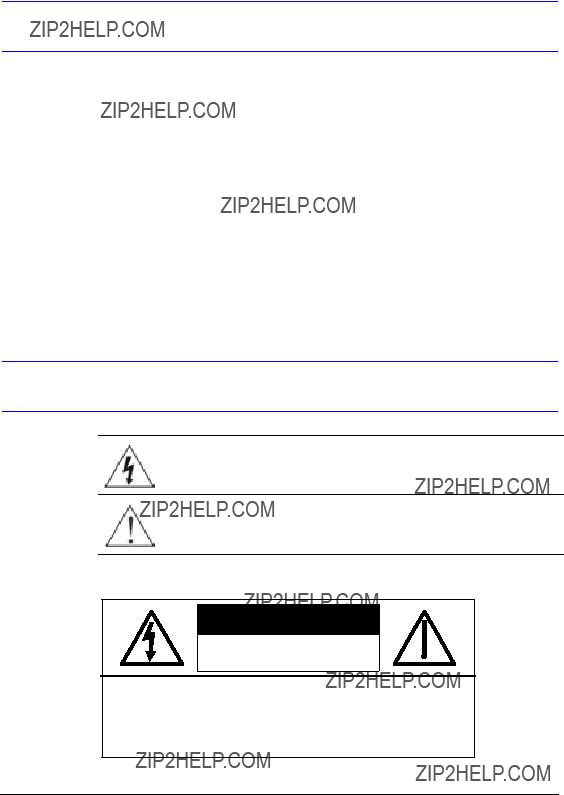
FCC Compliance Statement
INFORMATION TO THE USER: This equipment has been tested and found to comply with the limits for a Class A digital device, pursuant to part 15 of the FCC rules. These limits are designed to provide reasonable protection against harmful interference when the equipment is operated in a commercial environment. This equipment generates, uses, and can radiate radio frequency energy and, if not installed and used in accordance with the instruction manual, may cause harmful interference to radio communications. Operation of this equipment in a residential area is likely to cause harmful interference in which case the user will be required to correct the interference at his own expense.
CAUTION: Changes or modifications not expressly approved by the party responsible for compliance could void the user???s authority to operate the equipment.
This Class A digital apparatus complies with Canadian
Cet appareil num??rique de la Classe A est conforme ?? la norme
Explanation of Graphical Symbols
This symbol alerts the user to the presence of uninsulated "dangerous voltage" within the product's enclosure that may be of sufficient magnitude to constitute a risk of electric shock.
This symbol alerts the user to the presence of important operating and maintenance (servicing) instructions in the literature accompanying the appliance.
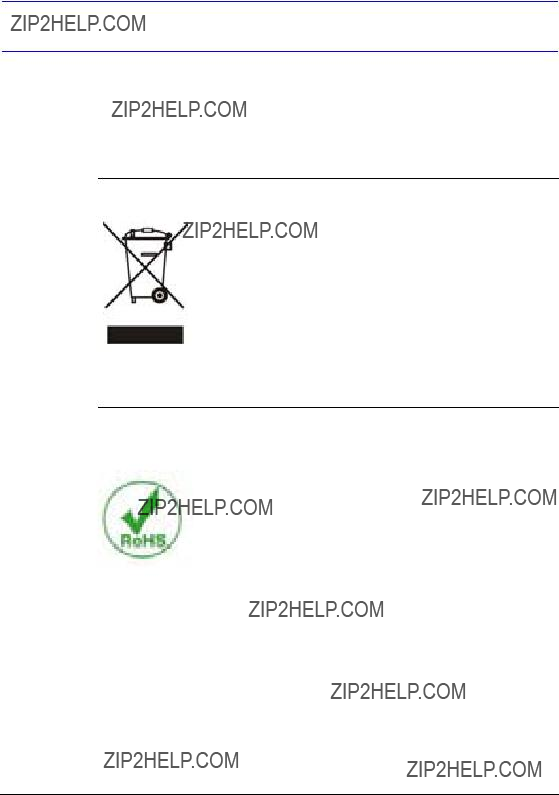
Compliance
WEEE (Waste Electrical and Electronic Equipment)
Correct Disposal of this Product (Applicable in the European Union and other European countries with separate collection systems)
This marking shown on the product or its literature, indicates that it should not be disposed with other household wastes at the end of its working life. To prevent possible harm to the environment or human health from uncontrolled waste disposal, please separate this from other types of wastes and recycle it responsibly to promote the sustainable reuse of material resources.
Household users should contact either the retailer where they purchased this product, or their local government office, for details of where and how they can take this item for environmentally safe recycling.
Business users should contact their supplier and check the terms and conditions of the purchase contract. This product should not be mixed with other commercial wastes for disposal.
RoHS
4

6

Contents
Go to the Date/Time . . . . . . . . . . . . . . . . . . . . . . . . . . . . . . . . . 109 Calendar Search. . . . . . . . . . . . . . . . . . . . . . . . . . . . . . . . . . . 110 Event Log Search . . . . . . . . . . . . . . . . . . . . . . . . . . . . . . . . . . 111
Appendix A USB Hard Disk Drive Preparation . . . . . . . . . . . . . . . . . . . . . . 121
Preparing the
Appendix B Text In Search Examples . . . . . . . . . . . . . . . . . . . . . . . . . . . 123
Appendix H Map of Screens . . . . . . . . . . . . . . . . . . . . . . . . . . . . . . . . 145 Appendix I System Log Notices . . . . . . . . . . . . . . . . . . . . . . . . . . . . . 147 Appendix J Error Code Notices . . . . . . . . . . . . . . . . . . . . . . . . . . . . . . 149 Appendix K Specifications . . . . . . . . . . . . . . . . . . . . . . . . . . . . . . . . . 151

Contents
8
Figures
Figures

10

12

About This Document
This document introduces the HRXD Series Digital Video Recorder (DVR) and describes how to install, configure, and operate the DVR.
This guide covers the 9- and
Overview of Contents
This document contains the following chapters and appendixes:
???Chapter 1, Introduction, introduces the HRXD Series DVR, lists the features and gives a functional overview of its components.
???Chapter 2, Installation, describes how to install the DVR and connect the system components.
???Chapter 3, Configuration, provides an overview of the front panel controls and LCD displays and provides instructions for configuring the DVR.
???Chapter 4, Operation, covers live monitoring, recording video and audio, playing recorded video, and searching for video.
???Appendix A, USB Hard Disk Drive Preparation, shows how to prepare the USB hard disk drive for computers using Microsoft?? Windows?? 2000/98 operating systems.
???Appendix B, Text In Search Examples, provides typical examples of text searches.
???Appendix C, Reviewing Video Clips, describes the Clip Player program and its features.
???Appendix D, WebGuard, demonstrates using WebGuard to access a remote DVR, monitor live video and search for recorded video using Internet Explorer.
???Appendix E, Time Overlap, instructs how to search for recorded video when you have overlapping time segments.
???Appendix F, Troubleshooting, provides answers for common technical issues.
???Appendix G, Connector Pin Outs, describes I/O and RS485 connector pinouts.

???Appendix H, Map of Screens, provides a graphical illustration of the menu screens.
???Appendix I, System Log Notices, lists all of the System Log notices.
???Appendix J, Error Code Notices, lists the system upgrade and clip copy Error Code notices.
???Appendix K, Specifications, lists the DVR specifications.
Important Safeguards
1.Read Instructions
All the safety and operating instructions should be read before the appliance is operated.
2.Retain Instructions
The safety and operating instructions should be retained for future reference.
3.Cleaning
Unplug this equipment from the wall outlet before cleaning it. Do not use liquid aerosol cleaners. Use a damp soft cloth for cleaning.
4.Attachments
Never add any attachments and/or equipment without the approval of the manufacturer as such additions may result in the risk of fire, electric shock, or other personal injury.
5.Water and/or Moisture
Do not use this equipment near water or in contact with water.
6.Accessories
Do not place this equipment on an unstable cart, stand, or table. The equipment may fall, causing serious injury to a child or adult, and serious damage to the equipment. Wall or shelf mounting should follow the manufacturer???s instructions, and should use a mounting kit approved by the manufacturer.
This equipment and cart combination should be moved with care. Quick stops, excessive force, and uneven surfaces may cause the equipment and cart combination to overturn.
7.Power Sources
This equipment should be operated only from the type of power source indicated on the marking label. If you are not sure of the type of power, please consult your equipment dealer or local power company.
14

8.Power Cords
Operator or installer must remove power, BNC, alarm, and other connections before moving the equipment.
9.Lightning
For added protection for this equipment during a lightning storm, or when it is left unattended and unused for long periods of time, unplug it from the wall outlet and disconnect the antenna or cable system. This will prevent damage to the equipment due to lightning and
10.Overloading
Do not overload wall outlets and extension cords to avoid the risk of fire or electric shock.
11.Objects and Liquids
Never push objects of any kind through openings of this equipment as they may touch dangerous voltage points or short out parts that could result in a fire or electric shock. Never spill liquid of any kind on the equipment.
12.Servicing
Do not attempt to service this equipment yourself. Refer all servicing to qualified service personnel.
13.Damage Requiring Service
Unplug this equipment from the wall outlet and refer servicing to qualified service personnel under the following conditions:
???When the
???If liquid is spilled or objects have fallen into the equipment
???If the equipment has been exposed to rain or water
???If the equipment does not operate normally by following the operating instructions, adjust only those controls that are covered by the operating instructions as an improper adjustment of other controls may result in damage and will often require extensive work by a qualified technician to restore the equipment to its normal operation.
???If the equipment has been dropped or the cabinet damaged
???When the equipment exhibits a distinct change in
14.Replacement Parts
When replacement parts are required, be sure the service technician has used replacement parts specified by the manufacturer or that have the same characteristics as the original part. Unauthorized substitutions may result in fire, electric shock, or other hazards.
15.Safety Check
Upon completion of any service or repairs to this equipment, ask the service technician to perform safety checks to determine that the equipment is in proper operating condition.
16.Field Installation
This installation should be made by a qualified service person and should conform to all local codes.

17. Correct Batteries
18.Operating Temperature
An operating temperature range is specified (see Appendix K, Specifications) so that the customer and installer may determine a suitable operating environment for the equipment.
19.Elevated Operating Ambient Temperature
If installed in a closed or
20.Reduced Air Flow
Installation of the equipment in the rack should be such that the amount of airflow required for safe operation of the equipment is not compromised.
21.Mechanical Loading
Mounting of the equipment in the rack should be such that a hazardous condition is not caused by uneven mechanical loading.
22.Circuit Overloading
Consideration should be given to connection of the equipment to supply circuit and the effect that overloading of circuits might have on
23.Reliable Earthing (Grounding)
Reliable grounding of rack mounted equipment should be maintained. Particular attention should be given to supply connections other than direct connections to the branch circuit (for example, use of power strips).
16
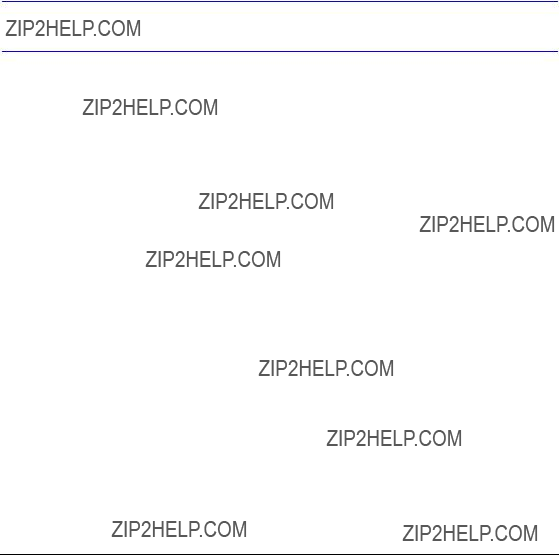
Introduction
1
Introduction
Features
Your color digital video recorder (DVR) provides recording capabilities for nine or 16 camera inputs. It provides exceptional picture quality in both live and playback modes, and offers the following features:
???9 or 16 composite video input connectors
???Compatible with color (NTSC or PAL) and B&W (CCIR and
???Auto detection for NTSC and PAL
???Multiple monitor connectors: 1 BNC Video Out, 1 SVHS, 4 Spot, 1 VGA
???Multiple search engines (Date/Time, Calendar, Event)
???Records up to 240/200 images per second (NTSC/PAL)
???
???Continuous recording in Disk Overwrite mode
???Video archiving via Ultra SCSI interface
???3 USB 2.0 ports
???Continues recording while archiving and transmitting to remote sites during playback
???
???Multiple recording modes
???
???Text input for ATM and POS
???Alarm connections include: Input, Output and Reset Input
???
???Live or recorded video access via Ethernet or modem
???Time synchronization using industry standard protocol
???
???
???Infrared remote control

Introduction
Technical Overview
In addition to replacing both a
The DVR converts analog NTSC or PAL video to digital images and records them on a hard disk drive. Using a hard disk drive allows you to access recorded video almost instantaneously; there is no need to rewind tape. The technology also allows you to view recorded video while the DVR continues recording video.
Digitally recorded video has several advantages over analog video recorded on tape. There is no need to adjust tracking. You can freeze frames, fast forward, fast reverse, slow forward and slow reverse without image streaking or tearing. Digital video can be indexed by time or events, and you can instantly view video after selecting the time or event.
Your DVR can be set up for event or
The DVR can be set up to alert you when the hard disk drive is full, or it can be set to record over the oldest video once the disk is full.
Your DVR uses a proprietary encryption scheme making it nearly impossible to alter video.
You can view video and control your DVR remotely by connecting via modem or Ethernet. There is a SCSI port that can be used to record or archive video to external hard disk drives, and there are also three USB ports that can be used to upgrade the system or copy video clips to external hard disk,
Note This manual covers the 9- and
18
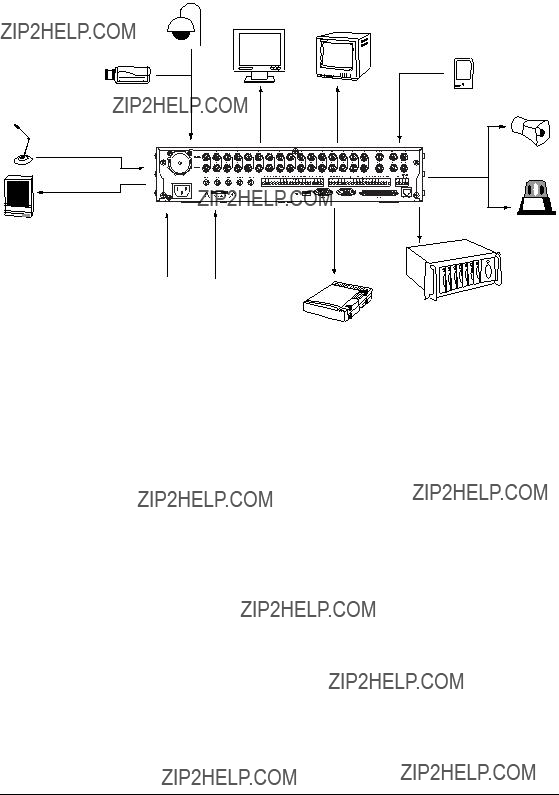
LAN or MODEM  Network ConnectionInternal
Network ConnectionInternal
or
External SCSI
Hard Disk Drive
USB Device x 3

Introduction
20
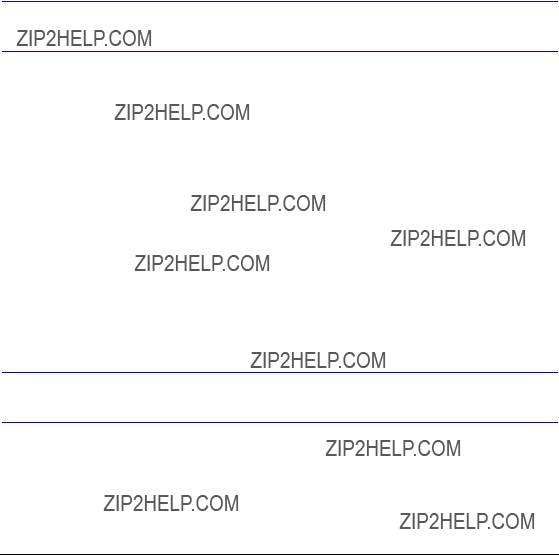
Installation
2
Installation
Package Contents
The package contains the following:
???Digital Video Recorder
???Power cord
???User Guide (this document)
???Multilingual User Guide (RASplus
???RASplus User Guide
???Multilingual RASplus Software CD and User Guide (RASplus
???DVRNS Server Software and User Guide (RASplus
???
???Assembly screws guide rails for adding Hard Disk drives
???Screws for attaching SCSI connector
???Infrared remote control
Required Installation Tools
No special tools are required to install the DVR. Refer to the installation manuals for the other items that make up part of your system.
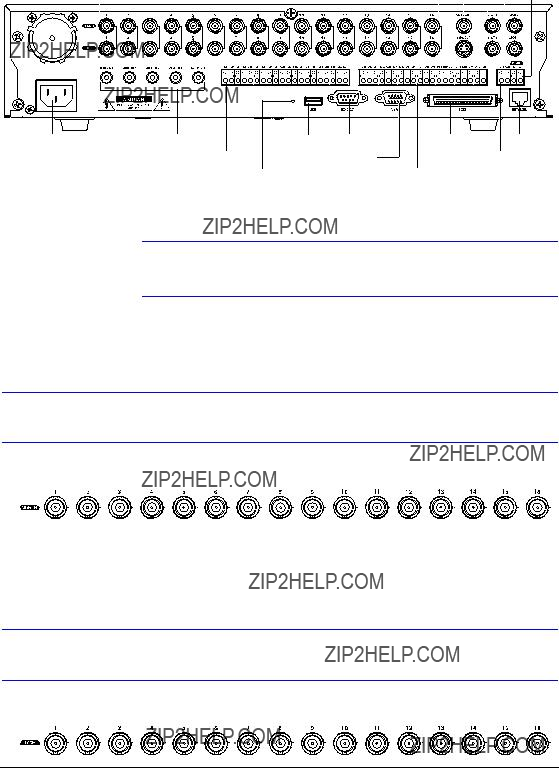
Installation
Alarm Outs
Your DVR can be used with either NTSC or PAL equipment.
Note You cannot mix NTSC and PAL equipment. For example, you cannot use a PAL camera and an NTSC monitor.
Connecting the Video Input
Figure
Connect the coaxial cables from the video sources to the BNC Video In connectors.
Connecting the
Figure
22

Installation
If you would like to connect your video source to another device, you can use the Loop BNC connectors.
Note The Loop BNC connectors are auto terminated. Do NOT connect a cable to the Loop BNC unless it is connected to a terminated device because it will cause poor quality video.
Connecting the Monitor
Figure
Connect the main monitor to either the Video Out or SVHS Out connector.
Note Use the SVHS input if your main monitor supports it because it will give you better quality video display.
Note The Video Out (BNC) and SVHS Out connectors may be connected to individual monitors for simultaneous operation.
Up to four Spot monitors can be connected to the DVR. Connect the spot monitors to the SPOT 1, SPOT 2, SPOT 3 and SPOT 4 connectors as needed.
Note When the DVR is in Search mode, it can display live video on the SPOT 1 monitor as displayed on the main monitor during the live mode.

Installation
Connecting a VGA Monitor
Figure
A VGA connector is provided so that you can use a standard,
Note Pressing and holding DISPLAY on the front panel for 5 seconds or longer will switch the video output between Video Out (BNC or SVHS Out) and VGA Out. During clip copy, you cannot switch the video output between Video Out and VGA Out.
Caution The DVR will NOT record video for about 3 seconds while switching the video output between Video Out and VGA Out.
Connecting Audio
Note It is the user???s responsibility to determine if local laws and regulations permit recording audio.
Figure
24

Installation
Your DVR can record audio from up to four sources. Connect the audio sources to Audio In 1, Audio In 2, Audio In 3 and Audio In 4 as needed using RCA jacks. Connect Audio Out to your amplifier.
Note The DVR does not have amplified audio output, so you will need a speaker with an amplifier. The DVR does not have a
Connecting Alarms
Figure
Note To make connections on the Alarm Connector strip, press and hold the button and insert the wire in the hole below the button. After releasing the button, tug gently on the wire to make certain it is connected. To disconnect a wire, press and hold the button above the wire and pull out the wire.
AI 1 to 16
You can use external devices to signal the DVR to react to events. Mechanical or electrical switches can be wired to the AI

Installation
GND (Ground)
Note All the connectors marked GND are common.
Connect the ground side of the alarm input and/or alarm output to the GND connector.
AO 1 to 16
Figure
The DVR can activate external devices such as buzzers or lights. Connect the device to the AO
ARI (Alarm Reset In)
Figure
An external signal to the Alarm Reset In can be used to reset both the Alarm Out signal and the DVR???s internal buzzer. Mechanical or electrical switches can be wired to the ARI (Alarm Reset In) and GND (Ground) connectors. The threshold voltage is below 0.3V and should be stable at least 0.5 seconds to be detected. Connect the wires to the ARI (Alarm Reset In) and GND (Ground) connectors.
26
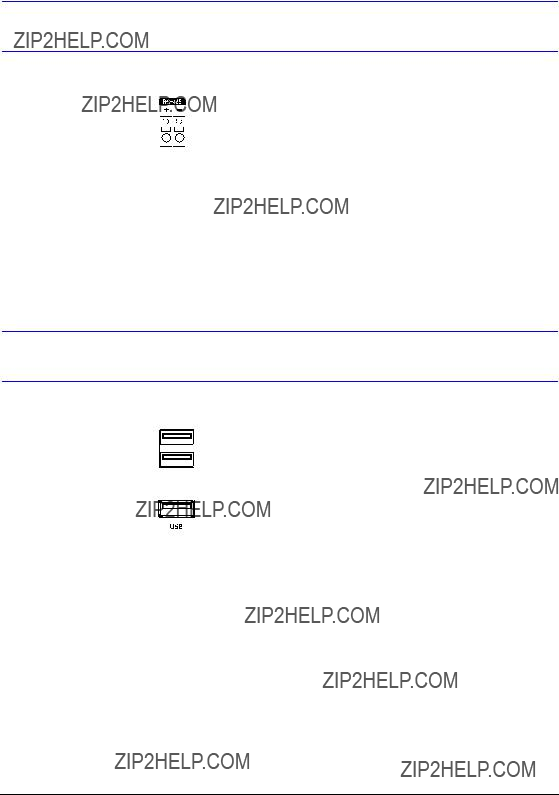
Installation
Connecting to the RS485 Port
Figure
The DVR can be controlled remotely by an external device or control system, such as a control keyboard, using RS485
Connecting to the USB Ports
Figure
Figure
Three USB ports are provided to connect external hard disk,
A USB mouse (not supplied) can be connected to one of the ports. You can use the mouse to navigate through the screens and menus much like you would on a computer.
A PostScript??? USB printer (not supplied) can be connected to one of the ports. You can print selected images resulting from a search. Refer to Chapter 4, Operation, Searching Video.
A USB to Serial converter can be connected to the USB port. Multiple
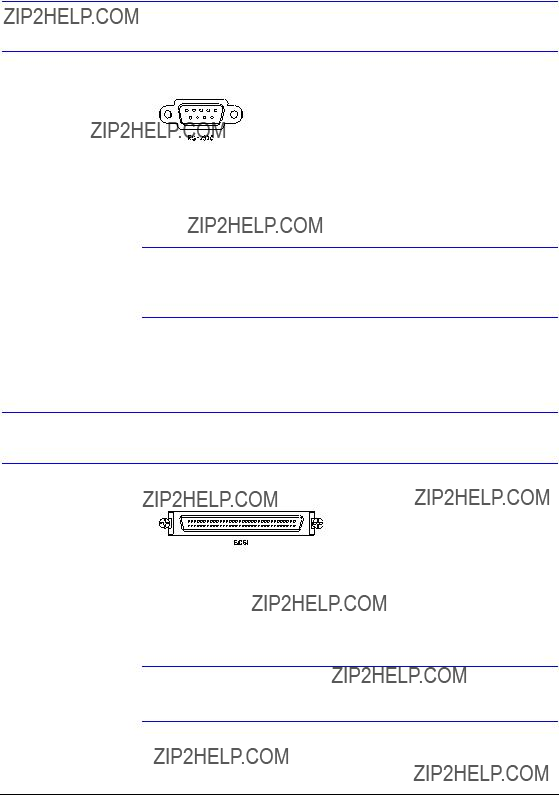
Installation
Connecting to the RS232 Port
Figure
An RS232 port is provided to connect an external modem for remote monitoring, configuration and software upgrades, and to connect a remote control keyboard. Use a modem cable with a
Note The DVR is not supplied with a modem cable, and many modems are not supplied with cables. Make certain you have the correct cable when purchasing the modem.
Connecting to the Ultra Wide SCSI Port
Figure
A SCSI port is provided to connect external storage devices for recording or archiving video. Connect the external SCSI hard disk drive (RAID) cable to the
Note The SCSI bus must be terminated, otherwise the DVR will not operate properly.
28
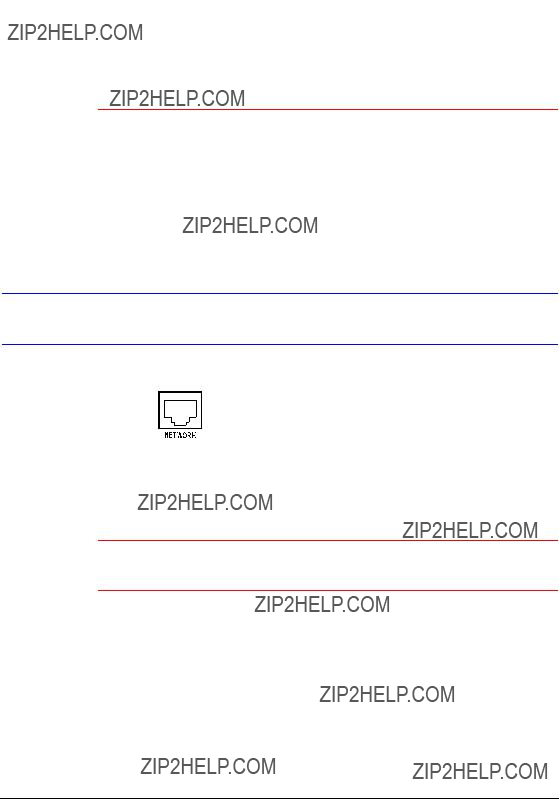
Installation
Caution Do NOT connect or disconnect SCSI devices while the DVR power is on. The DVR must be powered down to connect or disconnect SCSI devices. Power up SCSI devices so they are ready for operation before powering up the DVR. Power down SCSI devices after powering down the DVR and then disconnect SCSI devices.
Caution If the SCSI device is shut down while the device is operating, the
DVR system might not operate normally.
Connecting to the Network Port
Figure
The DVR can be networked using the 10/100Mb Ethernet connector. Connect a Cat5 cable with an
Caution The network connecter is not designed to be connected with cable or wire intended for outdoor use.

Installation
Factory Reset
Figure
The DVR has a Factory Reset switch to the left of the USB port on the rear panel. This switch will only be used on the rare occasions that you want to return all the settings to the original factory settings.
Caution When using the Factory Reset, you will lose any settings you have saved.
To reset the unit, you will need a straightened paperclip:
1.Turn the DVR off.
2.Turn it on again.
3.While the DVR is initializing, the front panel LEDs will blink. When any of the Camera 1 to 8 LEDs blink, poke the straightened paperclip in the unlabeled hole to the left of the USB port.
4.Hold the switch until all the LEDs on the front panel are lit.
Note When the DVR successfully resets to factory defaults, all the
LEDs on the front panel will flash five times.
5.Release the reset switch. All of the DVR???s settings are now at the original settings it had when it left the factory.
30

Installation
Connecting the Power Cord
Figure
Connect the AC power cord to the DVR and then to a wall outlet.
WARNING! ROUTE POWER CORDS SO THAT THEY ARE NOT A
TRIPPING HAZARD. MAKE CERTAIN THE POWER CORD
WILL NOT BE PINCHED OR ABRADED BY FURNITURE.
DO NOT INSTALL POWER CORDS UNDER RUGS OR
CARPET.
THE POWER CORD HAS A GROUNDING PIN. IF YOUR
POWER OUTLET DOES NOT HAVE A GROUNDING PIN
RECEPTACLE, DO NOT MODIFY THE PLUG.
DO NOT OVERLOAD THE CIRCUIT BY PLUGGING TOO
MANY DEVICES IN TO ONE CIRCUIT.
Caution In noisy electrical environments, use an Uninterruptible Power Supply (UPS) to minimize the potential of damage to the DVR from undesired power related hazards. Connect the UPS between the DVR and the AC voltage supply.
Your DVR is now ready to operate. Refer to Chapter 3, Configuration and Chapter 4, Operation to use the DVR.

Installation
32
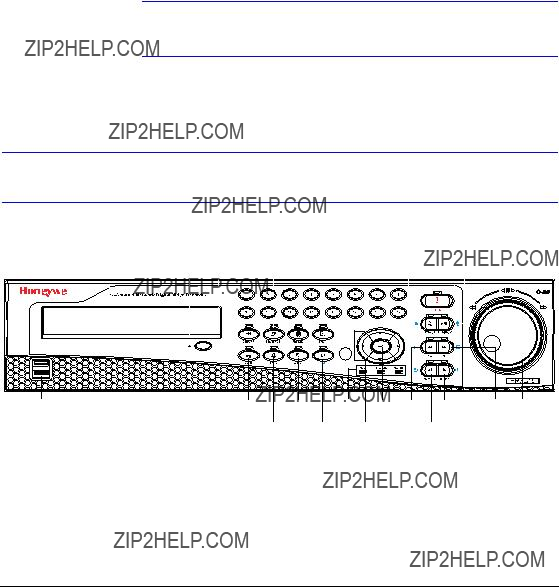
Configuration
3
Configuration
Note Your DVR should be completely installed before proceeding.
Refer to Chapter 2, Installation.
Front Panel Controls
The front panel looks and operates much like a VCR combined with a multiplexer. Many of the buttons have multiple functions. The buttons on the infrared remote control, while laid out differently, perform the same functions as those on the front panel. The following describes each button and control. Take a few minutes to review the descriptions. You will use these to initially set up your DVR and for daily operations.
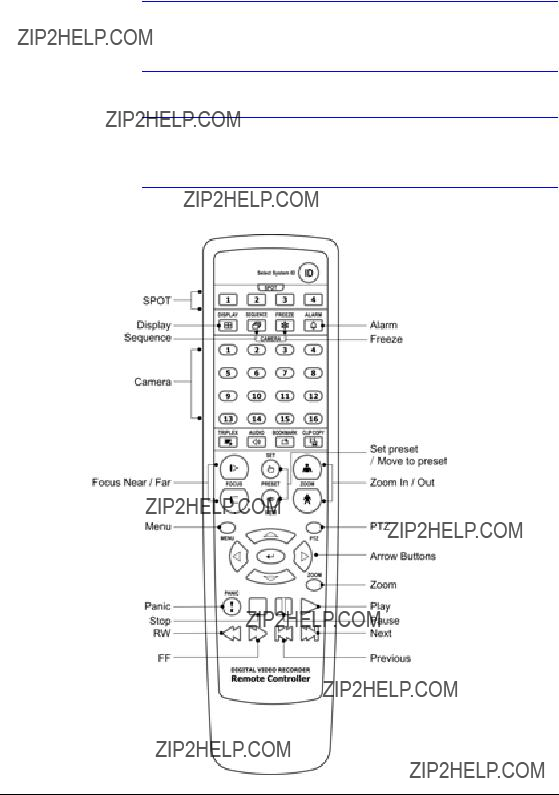
Configuration
Note The infrared sensor on the DVR is just to the left of the arrow buttons. Make certain that nothing blocks the sensor, or the remote control will not function properly.
Note You can also use a USB mouse (not supplied) to navigate through the screens and menus much like you would on a computer.
Figure
34

The arrow buttons are also used to control Pan and Tilt when in the PTZ mode. When in the PIP display format, pressing the Up and Down arrow buttons moves the position of the small screen
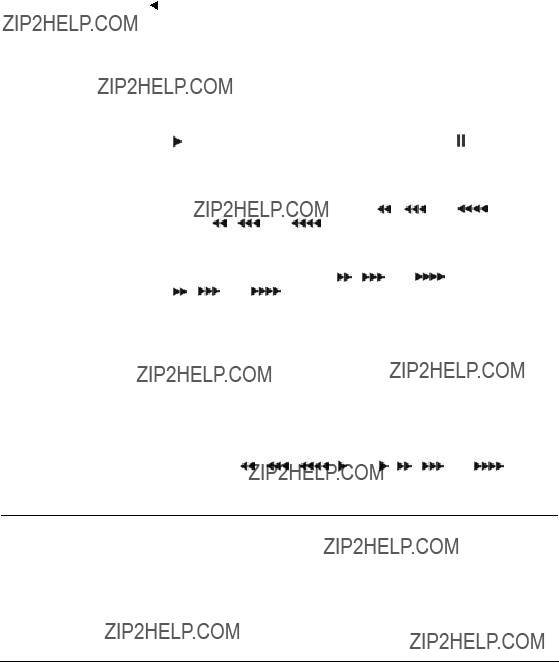
When you release the ring, it snaps back to the center position and the video pauses.
36
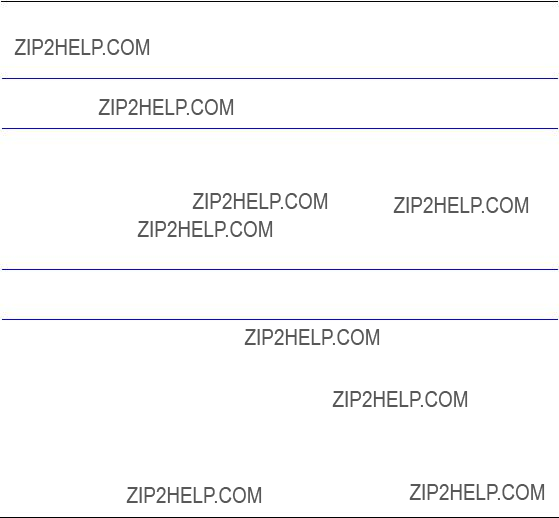
1 to 16, you must to press the ID button on the remote control and then press the corresponding number button (1 to 16) in order to control that DVR. If the System ID of two or more DVRs is set to 0, those DVRs will react to the infrared remote control at the same time.
Turning on the Power
Connecting the power cord to the DVR turns on the unit. The unit takes approximately 60 seconds to initialize.
Initial Unit Setup
Before using your DVR for the first time, you will want to establish the initial settings. This includes settings such as time and date, display language, camera, audio, remote control, record mode, network and password. Your DVR can be set up using various screens and dialog boxes.
Throughout the screens you will see  . Highlighting
. Highlighting  and pressing
and pressing 
 gives you the opportunity to reset that screen to its default settings.
gives you the opportunity to reset that screen to its default settings.
Press MENU to enter the setup screens. The Login screen appears.
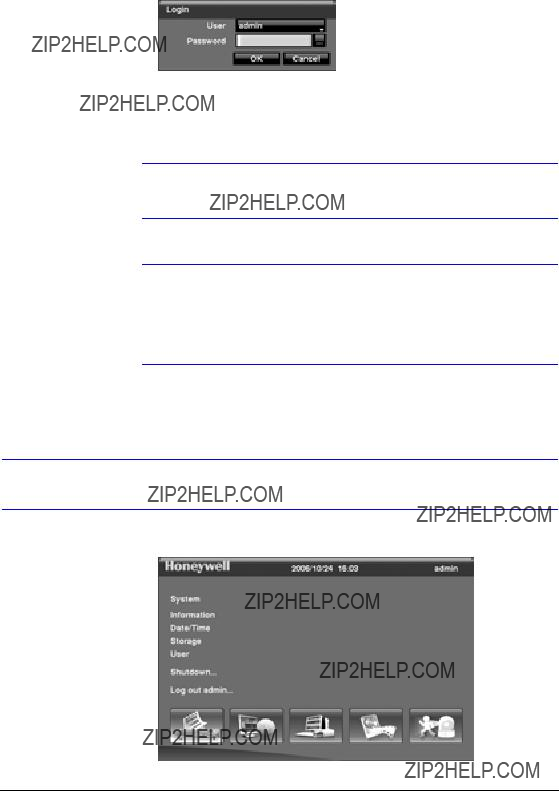
Configuration
Select a User and enter the password by pressing the appropriate combination of Camera number buttons and then 
 . There is no default password when logging in the admin user for the first time.
. There is no default password when logging in the admin user for the first time.
Note To assure the secure management of the system, setting up a password is strongly recommended.
Note You can use a mouse (not supplied) to access the Login screen in addition to using the front panel buttons or the infrared remote control. Click the right mouse button to display the Login screen. To enter a password, click the ... button, and the virtual keyboard displays. See Figure
Setup Screen
38

Configuration
Press MENU to enter the setup screen.
While setting up the DVR, there will be many opportunities to enter names and titles. When making these entries, a Virtual Keyboard will appear.
Figure
Use the arrow keys to highlight the character you want in the name or title and press

 . That character appears in the title bar and the cursor moves to the next position. Pressing
. That character appears in the title bar and the cursor moves to the next position. Pressing  toggles between the upper and lower case keyboards,
toggles between the upper and lower case keyboards,  backspaces, and
backspaces, and  deletes entered characters. You can use up to 31 characters including spaces in your title.
deletes entered characters. You can use up to 31 characters including spaces in your title.
Special characters can be created using ^ and a capital letter; for example, ^J for NL (New Line), ^M for CR (Carriage Return). Special characters are commonly used by text input devices and will be useful when performing
System Information
1.Highlight Information and press 
 . The Information screen (Figure
. The Information screen (Figure
Figure
In the Information screen, you can: name the site location, assign a System ID number, select the language the screens are displayed in, display the software version number, upgrade the software, show the System Log, display recorded time data, and clear all data.
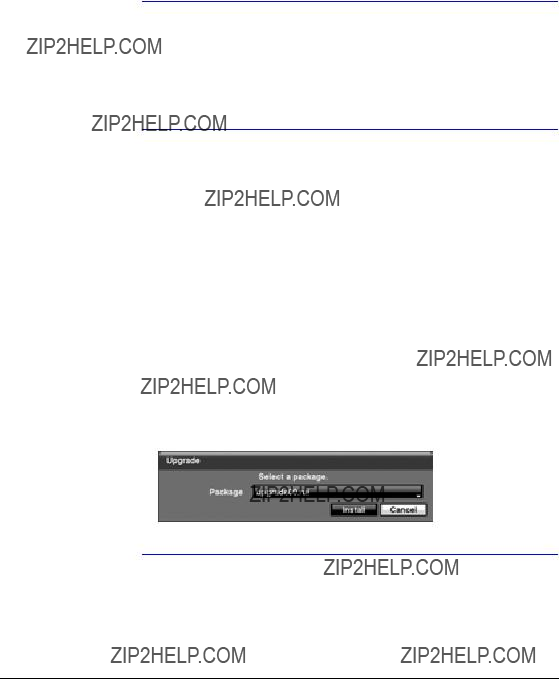
Configuration
2.Highlight the Site box and press 
 . A virtual keyboard appears that you can use to enter a Site Name.
. A virtual keyboard appears that you can use to enter a Site Name.
3.Once you have entered your title, highlight OK and press 
 .
.
4.Highlight the box beside System ID and press 
 . Change the number by highlighting it and using the Up and Down arrow buttons to increase and decrease the number from 0 to 99.
. Change the number by highlighting it and using the Up and Down arrow buttons to increase and decrease the number from 0 to 99.
Note The System ID number is used to identify the unit when it is connected with other DVRs through the RS485 port. You cannot use the same ID number for two or more DVRs that are in the same RS485 network. It is possible to have multiple DVRs with System ID 0 that are in the same area as long as they are not part of an RS485 network. If this is the case, all will be controlled at the same time when using the infrared remote control.
5.Highlight the box beside Language and press 
 . A
. A 
 .
.
6.The box beside Version displays the software version of the DVR. To upgrade the software:
a.Connect a USB device containing the upgrade package file to the DVR.
b.Highlight Upgrade??? and press 
 . The Upgrade screen appears. The screen displays the upgrade package file names that are available. The .rui indicates that the file is for software upgrades.
. The Upgrade screen appears. The screen displays the upgrade package file names that are available. The .rui indicates that the file is for software upgrades.
c.Select the desired file and press 
 .
.
d.Highlighting Install and pressing 
 will install the selected software package. Highlighting Cancel and pressing
will install the selected software package. Highlighting Cancel and pressing 
 will close the window without upgrading the software.
will close the window without upgrading the software.
If the upgrade package file is not installed on the DVR properly, you will get an error message.
e.The system restarts automatically after completing the upgrade.
Figure
40

Configuration
Caution The USB device must be FAT16 or FAT32 format.
7.You can import saved DVR settings or export the current DVR settings. To import saved DVR settings:
a.Connect the USB device containing the setup file (.dat) to the DVR.
b.Highlight Setup ??? Import??? and press 
 .
.
c.Select the desired setup file and press Import to import the selected settings and change the DVR settings accordingly.
d.Highlight Include Network Setup and press 
 to toggle between On and Off. When set to Off, the network settings will not be changed.
to toggle between On and Off. When set to Off, the network settings will not be changed.
Figure
8.To export the current DVR settings:
a.Connect the USB device to the DVR.
b.Highlight Setup ??? Export??? and press 
 .
.
c.Highlight the box beside File name and press 
 . A virtual keyboard allows you to enter the file name.
. A virtual keyboard allows you to enter the file name.
d.Selecting Export will save the current settings in .dat file format on the USB device.
Figure
Note Even after changing the DVR settings by importing saved settings, the
Caution The USB device must be FAT16 or FAT32 format.
9.Highlight Show System Log??? and press 
 to display the System Log.
to display the System Log.
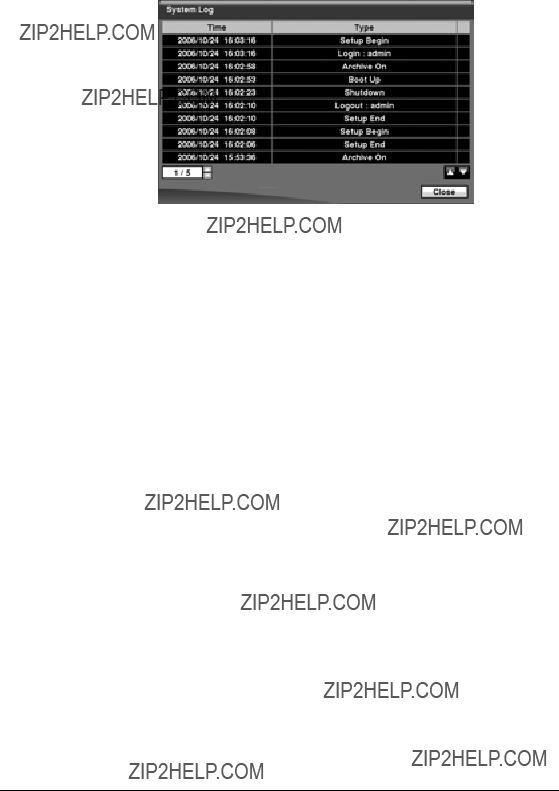
Configuration
Figure
The System Log screen lists system activities (up to 5,000 from the latest activity) that have occurred along with the time and date. The  icon will be displayed in the last column for system activities of the remote site. You can scroll through the log pages by using the Up and Down arrows, or you can go directly to a log page by entering the log page number in the box at the
icon will be displayed in the last column for system activities of the remote site. You can scroll through the log pages by using the Up and Down arrows, or you can go directly to a log page by entering the log page number in the box at the
Highlight Close and press 
 to exit the screen.
to exit the screen.
10.The box beside Recorded Data ??? From / To displays the time information of recorded data.
11.Highlighting Clear All Data??? and pressing 
 will clear all video data. You will be asked to verify that you wish to clear all data before the DVR erases the video data. Clear All Data??? will not clear the System Log.
will clear all video data. You will be asked to verify that you wish to clear all data before the DVR erases the video data. Clear All Data??? will not clear the System Log.
12.After you are finished with the Information Screen, you can highlight Save and press 
 to save the changes and exit the screen. If you do not wish to save the changes, highlight Cancel and press
to save the changes and exit the screen. If you do not wish to save the changes, highlight Cancel and press 
 to exit the screen.
to exit the screen.
Date/Time Setup
1.Highlight Date/Time in the System menu and press 
 . The Date/Time setup screen (Figure
. The Date/Time setup screen (Figure
42
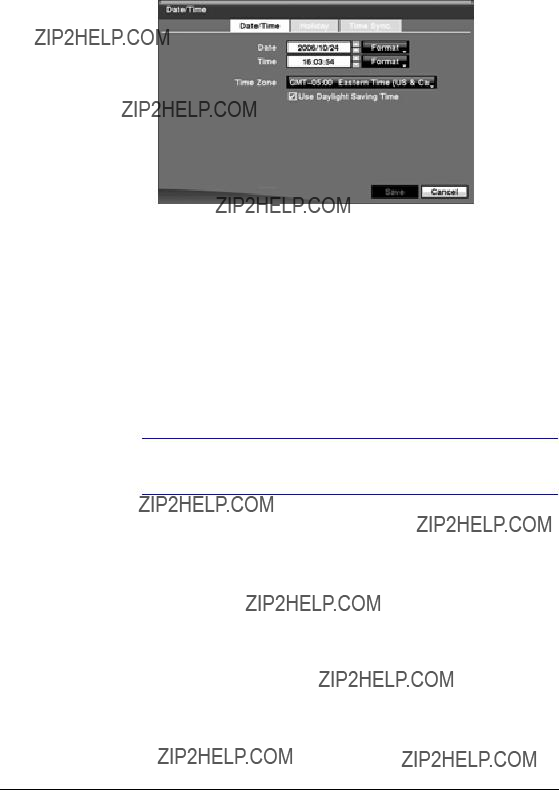
Configuration
Figure
2.Highlight the first box beside Date and press 
 . The individual sections of the date will highlight. Use the Up and Down arrow buttons to change the number. Use the Left and Right arrow buttons to move between month, date and year.
. The individual sections of the date will highlight. Use the Up and Down arrow buttons to change the number. Use the Left and Right arrow buttons to move between month, date and year.
Once you have the correct date, press 
 .
.
3.Highlight the Format box beside Date and press 
 . Select from the three available date formats and press
. Select from the three available date formats and press 
 to save your selected format.
to save your selected format.
4.Highlight the first box beside Time and press 
 . The individual sections of the time will highlight. Use the Up and Down arrow buttons to change the number. Use the Left and Right arrow buttons to move between hour, minutes and seconds. Once you have the correct time, press
. The individual sections of the time will highlight. Use the Up and Down arrow buttons to change the number. Use the Left and Right arrow buttons to move between hour, minutes and seconds. Once you have the correct time, press 
 .
.
5.Highlight the Format box beside Time and press 
 . Select from the three available time formats and press
. Select from the three available time formats and press 
 to save your selected format.
to save your selected format.
Note The clock will not start running until you have highlighted Save and pressed 
 .
.
6.Highlight the box beside Time Zone and press 
 . Select your time zone from the list and press
. Select your time zone from the list and press 
 .
.
7.Highlight Use Daylight Saving Time and press 
 . Pressing
. Pressing 
 toggles between On and Off.
toggles between On and Off.
8.Highlight the Holiday tab, and the Holiday setup screen (Figure
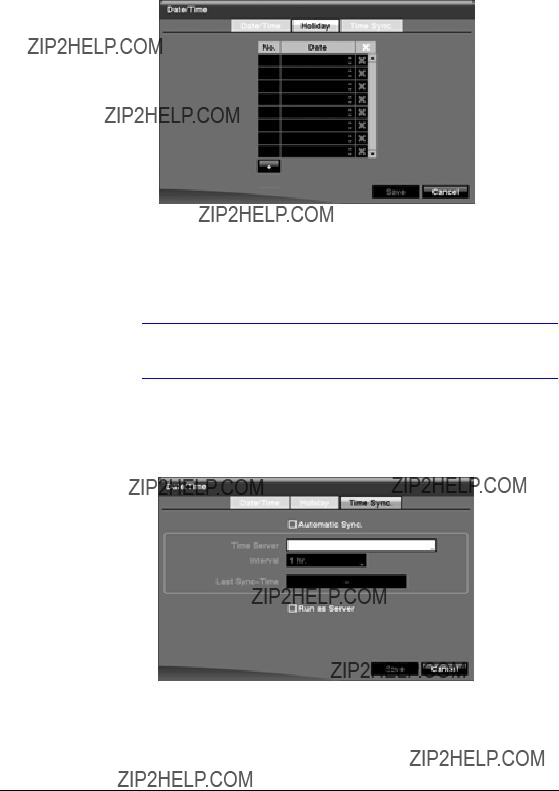
Configuration
Figure
9.You can set up holidays by highlighting + and pressing 
 . The current date appears.
. The current date appears.
10.Highlight the month and day and change them by using the Up and Down arrow
buttons. Press 
 to add the date. Dates can be deleted by highlighting
to add the date. Dates can be deleted by highlighting  beside the date and pressing
beside the date and pressing 
 .
.
Note Holidays that do not fall on the same date each year should be updated once the current year???s holiday has passed.
11.Highlighting the Time Sync tab causes the Time Sync screen to display. You can set up time synchronization between the DVR and standard time servers that are available in most time zones and countries, or between the DVR and another DVR.
Figure
12.Highlight the box beside Automatic Sync and press 
 . This toggles between
. This toggles between
On and Off.
13.Highlight the box beside Time Server and press 
 . A virtual keyboard appears that you can use to enter the IP address or domain name of the time server.
. A virtual keyboard appears that you can use to enter the IP address or domain name of the time server.
44
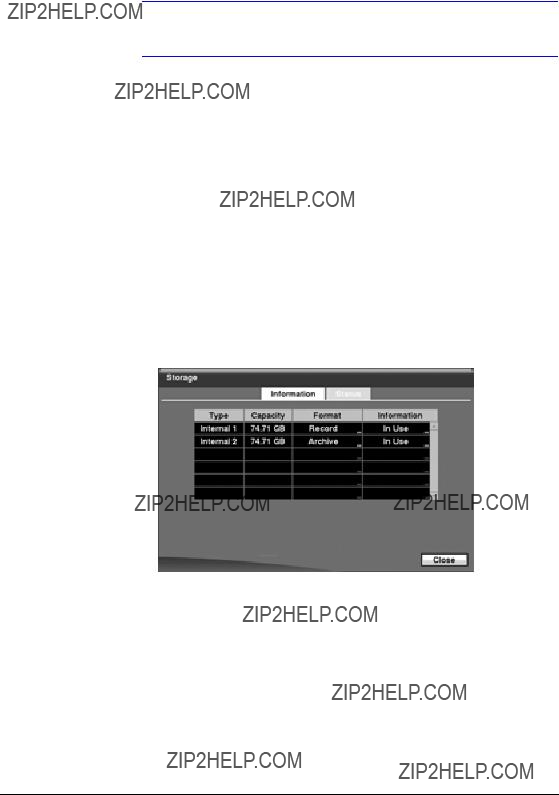
Configuration
Note You can use the domain name instead of an IP address if you already set up the DVRNS Server when setting up the LAN.
14.Highlight the box beside Interval and press 
 . Set the time interval for synchronization from 30 minutes to 1 day at various time intervals.
. Set the time interval for synchronization from 30 minutes to 1 day at various time intervals.
Last
15.Highlight Run as Server and press 
 . Pressing
. Pressing 
 toggles between On and Off. When it is On, the DVR you are setting up will run as a time server.
toggles between On and Off. When it is On, the DVR you are setting up will run as a time server.
16.You can save your changes by highlighting Save and pressing 
 . Selecting Cancel exits the screen without saving the changes.
. Selecting Cancel exits the screen without saving the changes.
Storage Screen
1.Highlight Storage in the System menu and press 
 . The Storage setup screen (Figure
. The Storage setup screen (Figure
Figure
The information in the Type column describes the storage device.
The capacity of the storage device is displayed in the Capacity column.
The Format column displays whether the device is used for recording (Record) or archiving (Archive). Not Using indicates the device is not used for either recording or archiving. Not formatted indicates the device is not formatted.  indicates when the device has temporary space set aside so that video clips can be saved on a
indicates when the device has temporary space set aside so that video clips can be saved on a
2.Highlight the box in the Format column for the desired storage device and press

 . You will be able to format the device for recording or archiving. When
. You will be able to format the device for recording or archiving. When
selecting Not Using from Use As and highlighting Format, the device will not be used for either recording or archiving. You can also set aside space to store temporary files for CD or DVD burning by selecting Partition ??? CD/DVD Burn.
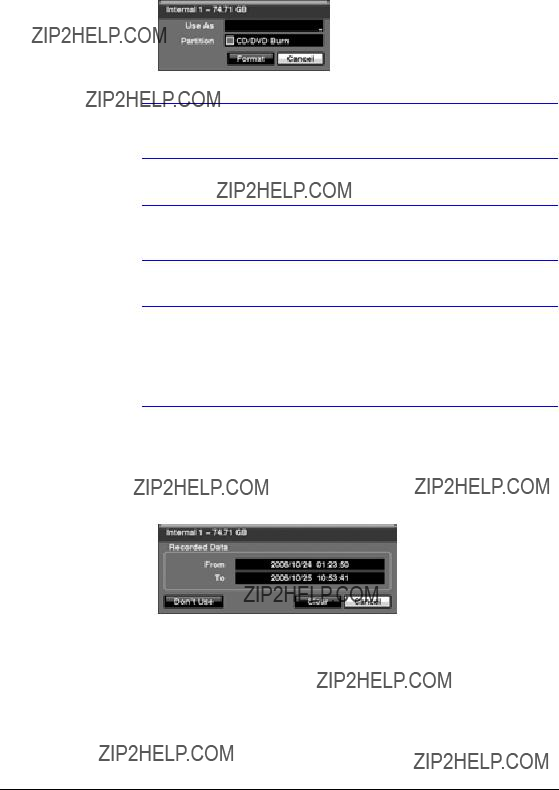
Configuration
Figure
Note A USB hard disk drive can be formatted and used only for archiving.
Note The DVR does NOT support USB hard disk drives with a version lower than 2.0.
Note System upgrades require formatting internal hard disk drives, so do not uninstall internal hard disk drives even though they are not used for either recording or archiving; for example, when using only external SCSI hard disk drives. Set the Use As for the internal hard disk drive to Not Using and format it.
The Information column displays whether the device is being used or not. Other indicates the device has been used for another DVR.
3.Highlight the box in the Information column for the desired storage device and press 
 . You will be able to check the time information about recorded data.
. You will be able to check the time information about recorded data.
Figure
4.If you want to erase recorded data on the selected device, highlight Clear and press 
 . You will be asked whether or not you want to delete the data.
. You will be asked whether or not you want to delete the data.
5.If you want to use a USB hard disk drive, highlight Use and press 
 after connecting the device. Highlight Don???t Use and press
after connecting the device. Highlight Don???t Use and press 
 if you want to stop using the device.
if you want to stop using the device.
46
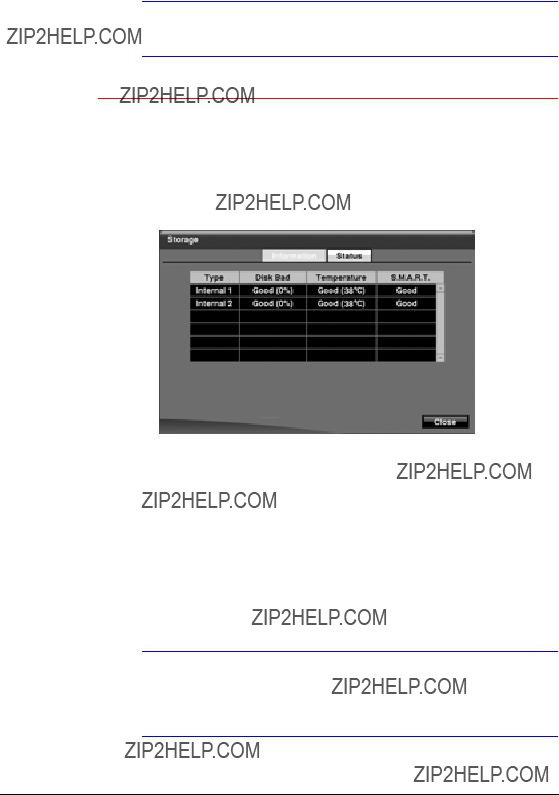
Configuration
Note When disconnecting a USB hard disk drive from the DVR, highlight Don???t Use first and then disconnect the device.
Caution Do NOT disconnect the USB cable or the power from the device while copying video clips. If the USB cable is disconnected while copying video clips, archived data might be lost.
6. Highlight the Status tab, and the Storage Status screen (Figure
Figure
The Type column displays the type of storage device.
The Disk Bad column displays the percentage of bad sectors. Not formatted indicates the device is not formatted.
The Temperature column displays the temperature of the storage device.
The S.M.A.R.T. column displays Good, Bad or N/A, depending on storage conditions.
???Good - The storage condition is normal.
???Bad - Data cannot be written on or read from the storage device.
???N/A - Storage conditions are normal, however, the S.M.A.R.T. monitoring is not working or supported.
Note When the storage condition is Bad, the Event Status - Storage screen displays and you can check the storage condition for details. Once the Bad message displays, replacing the hard disk drive is recommended, usually within 24 hours.
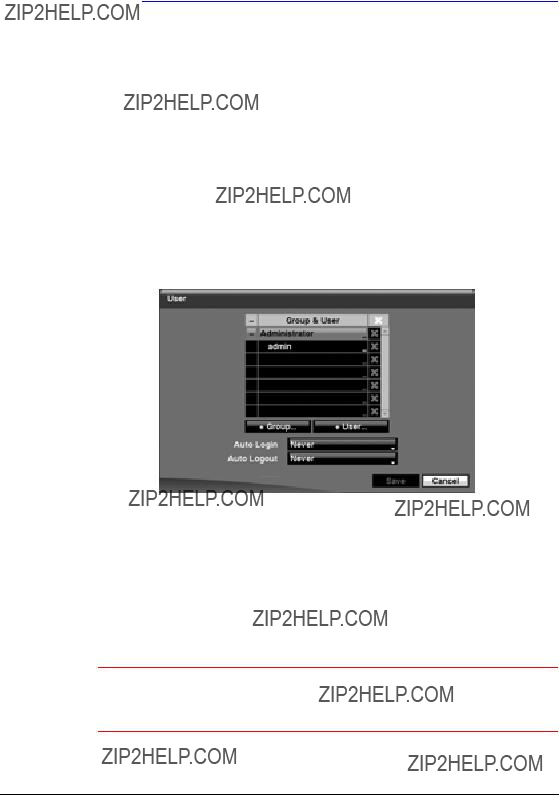
Configuration
7.Selecting Close and pressing 
 exits the screen.
exits the screen.
User Setup Screen
1.Highlight User in the System menu and press 
 . The User setup screen (Figure
. The User setup screen (Figure
Figure
2.The +/- column is used to collapse and expand user groups. If there is a + or - in this column, it indicates the item is a Group Name. If there is a - in front of the Group Name, it indicates that the group has been expanded and all of the User Names within that group are displayed below the Group Name. If there is a + in front of the Group Name, it indicates that the group has been collapsed and all of the User Names within that group are hidden. To collapse or expand a group, highlight the +/- column in front of the desired group and press 
 .
.
3.Highlighting a Group Name and pressing 
 allows you to change the authority levels assigned to the group.
allows you to change the authority levels assigned to the group.
Caution Write down the new password and save it in a secure place. If the password is forgotten, the unit must be reset using the Factory Reset button and all data settings will be lost.
48
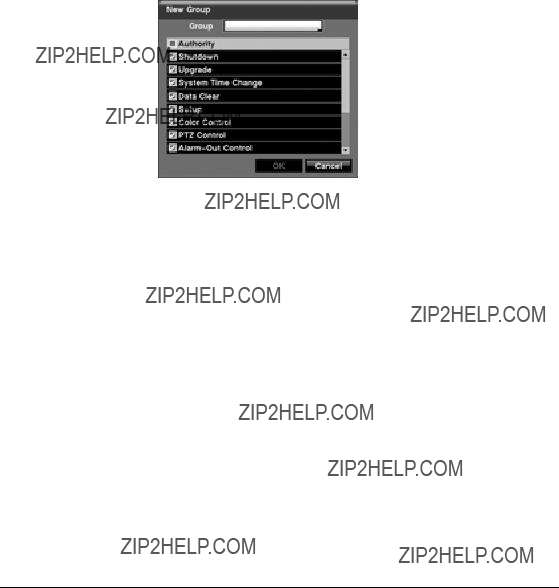
Configuration
4.Highlighting a User Name and pressing 
 allows you to add or change the password assigned to that user. You can also change the group to which the user is assigned.
allows you to add or change the password assigned to that user. You can also change the group to which the user is assigned.
5.The  column can be used to delete a User Name or an entire Group. If the
column can be used to delete a User Name or an entire Group. If the  is grayed out, that Group or User cannot be deleted. Highlight the
is grayed out, that Group or User cannot be deleted. Highlight the  and press
and press 
 . You will be asked to confirm that you want to delete the User or Group. To delete the User currently logged into the DVR on a local system or a PC running RAS, log the user out of the system first and then delete the user.
. You will be asked to confirm that you want to delete the User or Group. To delete the User currently logged into the DVR on a local system or a PC running RAS, log the user out of the system first and then delete the user.
6.To add a Group, highlight the + Group??? box and press 
 . A virtual keyboard appears allowing you to enter the Group name. You can use up to 15 characters including spaces in the group name. Enter the name and assign authority levels to the new group.
. A virtual keyboard appears allowing you to enter the Group name. You can use up to 15 characters including spaces in the group name. Enter the name and assign authority levels to the new group.
Figure
7.Highlighting the Authority box and pressing 
 will toggle between all authority levels being turned On and Off. Highlighting the individual authority level boxes and pressing
will toggle between all authority levels being turned On and Off. Highlighting the individual authority level boxes and pressing 
 will toggle between that authority level being turned On and Off. The authority levels that can be turned On and Off are:
will toggle between that authority level being turned On and Off. The authority levels that can be turned On and Off are:
???Shutdown ??? The user can shut the system down on a local system.
???Upgrade ??? The user can upgrade the software on a local system or a PC running RAS.
???System Time Change ??? The user can change the system date and time on a local system or a PC running RAS.
???Data Clear ??? The user can clear all video data or format disks on a local system or a PC running RAS.
???Setup ??? The user without Setup authority cannot establish any system settings excluding system shutdown and logout on a local system or a PC running RAS.
???Color Control ??? The user can control brightness, contrast, hue and saturation for cameras on a local system or a PC running RAS.
???PTZ Control ??? The user can control the PTZ camera on a local system or a PC running RAS.
???
???Covert Camera View ??? The user can view video from cameras set as Covert while in the Live Monitoring or Search mode on a local system or a PC running RAS.
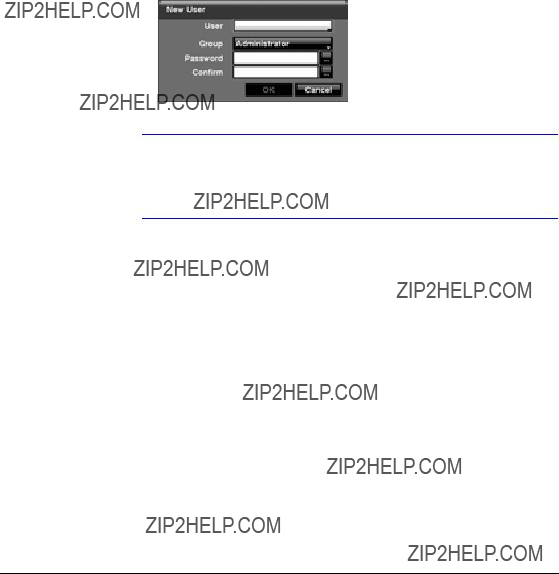
Configuration
???System Check ??? The user can view the remote system status or check the remote system status as a batch process on a PC running RAS.
???Record Setup ??? The user can establish all Record settings on a local system or a PC running RAS.
???Search ??? The user can access Search mode on a local system or a PC running RAS.
???
8.To add a User, highlight the + User??? box and press 
 . A virtual keyboard appears allowing you to enter the User Name. Enter the name and assign the User to a Group and password. You can use camera buttons 1 to 9 on either the front panel or remote control to assign the password. The password can be up to 8 digits. You will be asked to confirm the password.
. A virtual keyboard appears allowing you to enter the User Name. Enter the name and assign the User to a Group and password. You can use camera buttons 1 to 9 on either the front panel or remote control to assign the password. The password can be up to 8 digits. You will be asked to confirm the password.
Figure
Note In addition to using the front panel buttons or the infrared remote control, you can use the virtual keyboard to assign the password. To display the virtual keyboard select the ??? button using the mouse (not supplied) or the front panel arrow buttons.
9.Highlighting the box beside Auto Login allows you to select a User to be automatically logged in when the DVR is powered up. It can also be set to never automatically log in a user.
10.Highlighting the box beside Auto Logout allows you to select from a list of times that the user will be automatically logged out. The options are: Never, 1 min, 3 min, 5 min, 10 min, 15 min, 20 min, 25 min, 30 min and 1 hr.
11.You can save your changes by highlighting Save and pressing 
 . Selecting Cancel exits the screen without saving the changes.
. Selecting Cancel exits the screen without saving the changes.
Shutdown Screen
Highlight Shutdown in the System menu and press 
 . The Shutdown screen (Figure
. The Shutdown screen (Figure
50
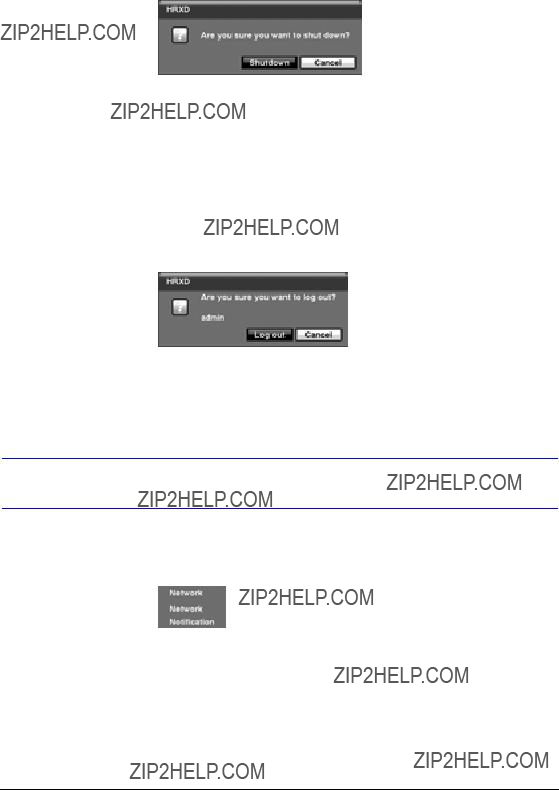
Configuration
Figure
After selecting Shutdown and pressing 
 , a screen will appear telling you when it is safe to disconnect power.
, a screen will appear telling you when it is safe to disconnect power.
Logout Screen
Highlight Logout in the System menu and press 
 . The Logout screen displays asking you to confirm whether or not you want to log out the current user.
. The Logout screen displays asking you to confirm whether or not you want to log out the current user.
Figure
After selecting Logout and pressing 
 , the user will be logged out.
, the user will be logged out.
Network and Notification Setup
In the Main screen, use the Left or Right arrow buttons to display the Network menu.
Figure
Network Screen
1.Highlight Network in the Network menu and press 
 . The Network setup screen (Figure
. The Network setup screen (Figure

Configuration
Figure
2.Highlight the first box beside Transfer Speed. Press the Up and Down arrow buttons to set the Transfer Speed from 50 Kbps to 100 Mbps.
3.Highlight the second box beside Transfer Speed. You can select the unit of measure for the transfer speed between: bps and ips. Press 
 to set the transfer speed.
to set the transfer speed.
4.Highlight the box beside Quality and press 
 . You can select the Quality from: Very High, High, Standard and Low. Press
. You can select the Quality from: Very High, High, Standard and Low. Press 
 to set the Quality.
to set the Quality.
Note The higher Quality settings require higher Transfer Speed settings. The transfer speed you set is the maximum speed. Depending on the network environment, this speed may not be achieved.
Note The local recording speed might be affected by various network bandwidth (Transfer Speed) conditions.
LAN Setup Screen
1.Highlight the LAN tab, and the LAN screen (Figure
52

Configuration
Figure
2.Highlight the box beside Type and press 
 . You can select the type of network configuration from: Manual, DHCP and ADSL (with PPPoE). Select the desired type and press
. You can select the type of network configuration from: Manual, DHCP and ADSL (with PPPoE). Select the desired type and press 
 .
.
3.Selecting Manual as the Type allows you to set up LAN parameters manually.
Note You will need to get the appropriate IP Address, Gateway and
Subnet Mask values from your network administrator.
a.Change the numbers by highlighting them and using the Up and Down arrow buttons to increase or decrease the number.
The factory default LAN settings are:
Gateway:192.168.1.254
b.Highlight the box beside DNS Server. Press the Up and Down arrow buttons to set the IP address of the DNS server.
c.Highlight the Port Number Setup??? box and press 
 . The Port Number Setup screen (Figure
. The Port Number Setup screen (Figure
Note You will need to get the appropriate Port Numbers for each RAS and WebGuard related program (Admin, Callback, Watch and Search) from your network administrator.
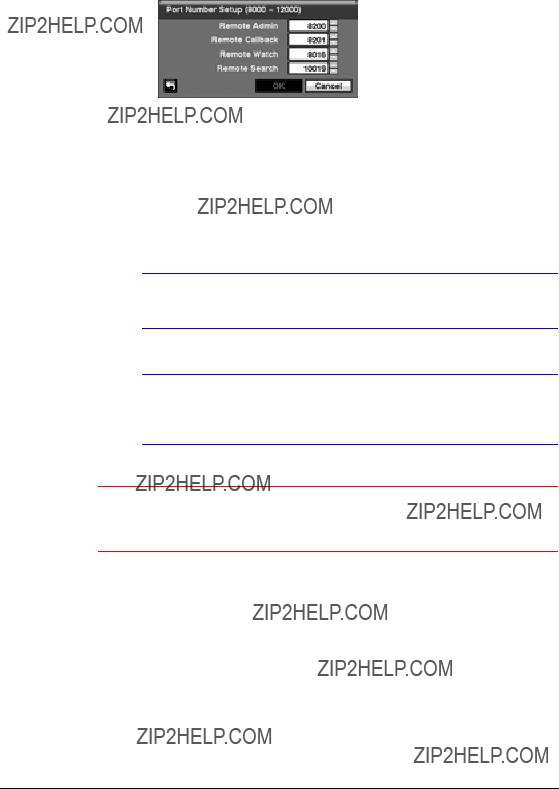
Configuration
Figure
d.Change the numbers by highlighting them and using the Up and Down arrow buttons to increase or decrease the number.
The factory default Port settings are:
Note The system restarts automatically after changing the port settings.
Note Do NOT use the same port number for two different programs, otherwise, the DVR cannot be connected with the PC running RAS or WebGuard.
Caution When changing the port settings, you must change the port settings on the PC running RAS or WebGuard as well. Refer to the
RAS Plus User Manual for details.
4.Selecting DHCP from the Type and highlighting Save reads the current IP address of the DVR configured by DHCP (Dynamic Host Configuration Protocol) network.
54
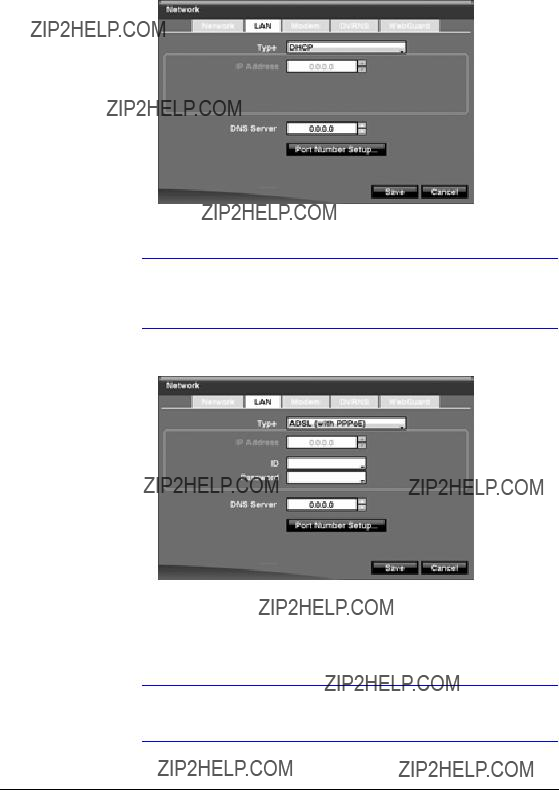
Configuration
Figure
5.Selecting ADSL (with PPPoE) allows you to set up the ADSL network.
Note ADSL and modem cannot be configured at the same time. If the DVR is configured by modem, the ADSL (with PPPoE) will not be selected.
Figure
a.Highlight the box beside ID and press 
 . A virtual keyboard appears allowing you to enter the ID for ADSL connection.
. A virtual keyboard appears allowing you to enter the ID for ADSL connection.
b.Highlight the box beside Password and press 
 . A virtual keyboard appears allowing you to enter the password for ADSL connection.
. A virtual keyboard appears allowing you to enter the password for ADSL connection.
Note Entering the ID and Password and highlighting OK reads the current IP address of the DVR configured by the ADSL network.

Configuration
Note If the DVR is configured for DHCP or an ADSL network, the
DVR???s IP address might change whenever the unit is turned on.
Modem Setup
1. Highlight the Modem tab, and the Modem screen (Figure
Figure
Note If the RS232 port is in use for remote control, networking cannot be configured for a modem.
2.Highlight Enable and press 
 to toggle between On and Off. You will only be able to change the settings if Modem is enabled.
to toggle between On and Off. You will only be able to change the settings if Modem is enabled.
3.Highlight the box beside Baud Rate and press 
 . A list of baud rates ranging from 300 to 115,200 appears.
. A list of baud rates ranging from 300 to 115,200 appears.
4.Highlight the box beside Data Bit and press 
 . Choose between 7 bit and 8 bit formats.
. Choose between 7 bit and 8 bit formats.
5.Highlight the box beside Stop Bit and press 
 . Choose between 1 and 2 Stop Bits.
. Choose between 1 and 2 Stop Bits.
6.Highlight the box beside Parity and press 
 . A
. A
56
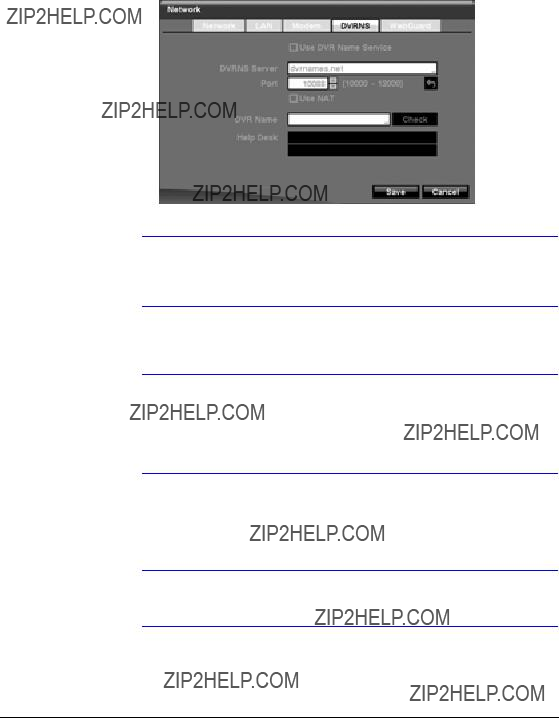
Configuration
DVRNS Setup
1. Highlight the DVRNS tab, and the DVRNS screen (Figure
Figure
Note When LAN settings have been changed, set up the DVRNS after saving your LAN changes by highlighting Save and pressing

 .
.
2.Highlight Use DVR Name Service and press 
 to toggle between On and Off.
to toggle between On and Off.
Note The DVRNS (DVR Name Service) allows the DVR to use Dynamic IP addresses for remote connection. When this feature is On, you can access your DVR remotely using the DVR name instead of its IP address. For the DVRNS feature, the DVR should be registered on the DVRNS server.
3.Highlight the box beside DVRNS Server and press 
 . A virtual keyboard appears allowing you to enter the IP address or domain name of the DVRNS server.
. A virtual keyboard appears allowing you to enter the IP address or domain name of the DVRNS server.
Note You will need to get the IP Address or domain name of the
DVRNS Server from your network administrator.

Configuration
Note You can use the domain name instead of IP address if you already set up the DNS Server when setting up the LAN.
4.Highlight the box beside Port and press 
 . Set the port number of the DVRNS server using the Up and Down arrow buttons to increase or decrease the numbers.
. Set the port number of the DVRNS server using the Up and Down arrow buttons to increase or decrease the numbers.
5.Highlight Use NAT and press 
 to toggle between On and Off.
to toggle between On and Off.
Note When using the NAT (Network Address Translation) device, refer to the NAT manufacturer???s instructions for the proper network settings.
6.Highlight the box beside DVR Name and press 
 . A virtual keyboard appears allowing you to enter the DVR name to be registered on the DVRNS server.
. A virtual keyboard appears allowing you to enter the DVR name to be registered on the DVRNS server.
7.Highlight the Check box and press 
 to check whether or not the name you entered can be used.
to check whether or not the name you entered can be used.
Note The DVR name you entered should be checked by selecting
Check, otherwise the DVRNS changes will not be saved.
Note When entering no name or a name already registered on the
DVRNS server, an error message displays.
8.Highlighting Save and pressing 
 registers the DVR on the DVRNS server. Proper DVRNS settings will display the help desk information of the DVRNS server in the box beside Help Desk.
registers the DVR on the DVRNS server. Proper DVRNS settings will display the help desk information of the DVRNS server in the box beside Help Desk.
WebGuard Setup
1.Highlight the WebGuard tab, and the WebGuard screen (Figure
58
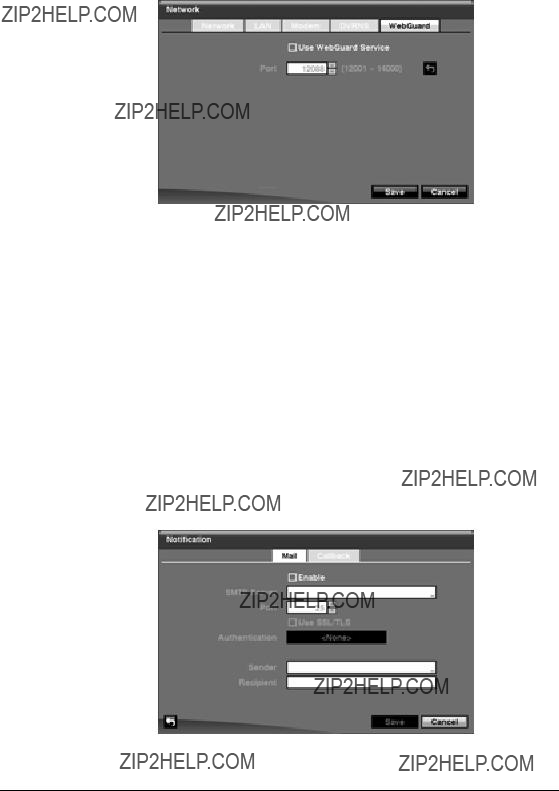
Configuration
Figure
2.Highlight Use WebGuard Service and press 
 to toggle between On and Off. See Appendix D, WebGuard for detailed descriptions of the WebGuard service.
to toggle between On and Off. See Appendix D, WebGuard for detailed descriptions of the WebGuard service.
3.Highlight the box beside Port and press 
 . Set the port number used when accessing WebGuard by using the Up and Down arrow buttons to increase or decrease the numbers.
. Set the port number used when accessing WebGuard by using the Up and Down arrow buttons to increase or decrease the numbers.
4.You can save your Network changes by highlighting Save and pressing 
 . Selecting Cancel exits the screen without saving the changes.
. Selecting Cancel exits the screen without saving the changes.
Notification Setup
The DVR can be set up to send an
1.Highlight Notification in the Network menu and press 
 . The Notification screen (Figure
. The Notification screen (Figure
Figure
2.Highlight Enable and press 
 to toggle between On and Off. You will only be able to change the settings if Mail is enabled.
to toggle between On and Off. You will only be able to change the settings if Mail is enabled.

Configuration
3.Highlight the box beside SMTP Server and press 
 . Use the virtual keyboard that appears to enter the IP address or domain name of the SMTP server.
. Use the virtual keyboard that appears to enter the IP address or domain name of the SMTP server.
Note You will need to get the IP address or domain name of the SMTP
Server from your network administrator.
Note You can use the domain name instead of IP address if you already set up the DNS Server when setting up the LAN.
4.Highlight the box beside Port and press 
 . Use the arrow buttons to enter the SMTP Server port number obtained from your network administrator. The default port number is 25.
. Use the arrow buttons to enter the SMTP Server port number obtained from your network administrator. The default port number is 25.
5.Highlight Use SSL/TLS and press 
 to toggle between On and Off. When it is On, the DVR can send an
to toggle between On and Off. When it is On, the DVR can send an
6.Highlight the box beside Authentication and press 
 . An Authentication screen (Figure
. An Authentication screen (Figure
a.Highlight Use and press 
 to toggle between On and Off.
to toggle between On and Off.
b.Highlight the box beside User/Password and press 
 . A virtual keyboard appears allowing you to enter the user ID and password.
. A virtual keyboard appears allowing you to enter the user ID and password.
c.Highlight OK and press 
 to accept your changes.
to accept your changes.
Figure
7.Highlight the box beside Sender and use the virtual keyboard to enter the sender???s
Note The
8.Highlight the box beside Recipient and use the virtual keyboard to enter the recipient???s
9.Highlight the Callback tab, and the Callback screen (Figure
60

Configuration
Figure
10.Highlight LAN and press 
 to toggle between On and Off. When LAN is turned On you can change the IP addresses.
to toggle between On and Off. When LAN is turned On you can change the IP addresses.
11.Highlight the IP Address box that you want to change and press 
 . Enter the IP address of the computer you want contacted during an event. You can enter up to five IP addresses.
. Enter the IP address of the computer you want contacted during an event. You can enter up to five IP addresses.
12.Highlight the box beside Retry and enter the number of times you would like the DVR to try contacting the computer(s). You can select from 1 to 10 retries.
13.If the modem was enabled in the Network screen, you can set up the DVR to contact a computer running RAS. Highlight Modem and press 
 to toggle between On and Off. When Modem is turned On you can enter a telephone number.
to toggle between On and Off. When Modem is turned On you can enter a telephone number.
14.Highlight the box beside Remote Server Phone Number and enter the telephone number of the computer running RAS.
15.Highlight the box beside Outside Line Call and enter any numbers that must be dialed for an outside line to function on your telephone system; for example, 9.
16.Highlight the box beside Callback Phone Number and enter the telephone number of the DVR.
17.You can save your Notification changes by highlighting Save and pressing 
 . Selecting Cancel exits the screen without saving the changes.
. Selecting Cancel exits the screen without saving the changes.
Configuring Devices
You can configure the video, audio, alarm, display and remote control devices connected to the DVR.

Configuration
Figure
Camera Setup Screen
1.Highlight Camera in the Devices menu and press 
 . The Camera setup screen (Figure
. The Camera setup screen (Figure
Figure
2.You can turn the camera number On or Off, and you can change the Title of each camera using the virtual keyboard.
3.You can also determine which cameras will display on the monitors by selecting Normal, Covert 1 or Covert 2 from a
Note When selecting Covert 1, the DVR displays the camera title and status icons on the covert video. When selecting Covert 2, the DVR displays only the camera title on the covert video.
Note A user who does not have Covert Camera View authority cannot view video from cameras set to Covert 1 or Covert 2 in both the live monitoring and playback modes.
4.Highlight the PTZ tab, and the PTZ setup screen (Figure
62

Configuration
Figure
Note You will only be able to set up PTZ devices if the PTZ port is set to RS232 or RS485. You will not be able to use a modem if you are using the RS232 port for PTZ control.
5.Highlight the box in the Product column for the PTZ camera you wish to configure and press 
 . A list of PTZ devices appears.
. A list of PTZ devices appears.
6.Select your camera from the list and press 
 . You will need to connect the camera to the RS232 or RS485 connector on the back of the DVR following the camera manufacturer???s instructions.
. You will need to connect the camera to the RS232 or RS485 connector on the back of the DVR following the camera manufacturer???s instructions.
Figure
7.You can assign IDs to each camera by highlighting the box under the ID heading and pressing 
 . Change the number by highlighting it and using the Up and Down arrow buttons to increase and decrease the number. The PTZ ID number can be set from 0 to 256.
. Change the number by highlighting it and using the Up and Down arrow buttons to increase and decrease the number. The PTZ ID number can be set from 0 to 256.
8.Highlight the Setup??? box and press 
 . The Port Setup window appears.
. The Port Setup window appears.

Configuration
Figure
9.Configure the port???s setting based on the PTZ camera manufacturer???s instructions.
10.You can save your Camera changes by highlighting Save and pressing 
 . Selecting Cancel exits the screen without saving the changes.
. Selecting Cancel exits the screen without saving the changes.
Audio Setup Screen
1.Highlight Audio in the Devices menu and press 
 . The Audio setup screen (Figure
. The Audio setup screen (Figure
Figure
2.The DVR can record up to four audio inputs. Highlight the box beside the input and press 
 . A list of cameras appears, and you can select which camera you want associated with that audio input.
. A list of cameras appears, and you can select which camera you want associated with that audio input.
3.Highlight Enable 
 . This toggles between enabling and disabling audio out.
. This toggles between enabling and disabling audio out.
Note The DVR will NOT record audio when the recording speed is set to less than 1 ips.
4.You can save your Audio changes by highlighting Save and pressing 
 . Selecting Cancel exits the screen without saving the changes.
. Selecting Cancel exits the screen without saving the changes.
64
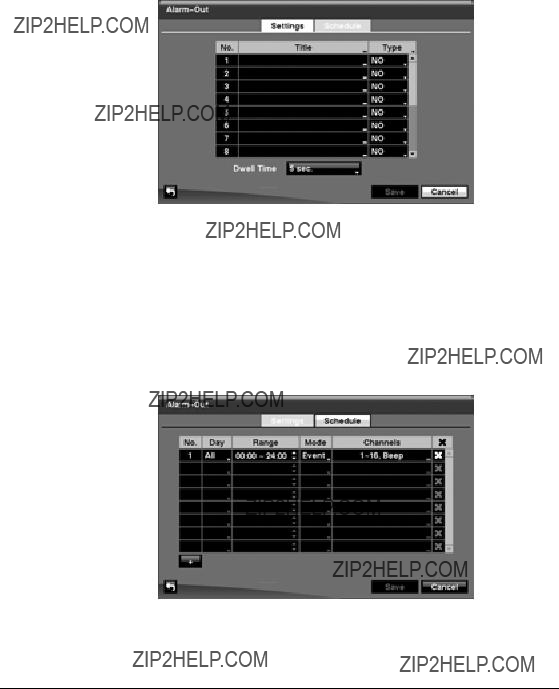
Configuration
1.Highlight 
 . The
. The
Figure
2.Each alarm output can be given its own title by highlighting the box under the Title heading and pressing 
 . A virtual keyboard appears allowing you to enter the title.
. A virtual keyboard appears allowing you to enter the title.
3.Highlighting the boxes under the Type heading allows you to set the alarm output for NO or NC (normally open or normally closed).
4.Highlighting the box beside Dwell Time and pressing 
 allows you to set the dwell time of the alarm output. Dwell times range from 5 seconds to 15 minutes.
allows you to set the dwell time of the alarm output. Dwell times range from 5 seconds to 15 minutes.
5.Highlighting the Schedule tab causes the Schedule screen (Figure
Figure
6.You can add and edit alarm output schedules on this screen. Highlight the + and press 
 to add a schedule. Highlighting the boxes in the columns and pressing
to add a schedule. Highlighting the boxes in the columns and pressing 
 allows you to edit the information in those boxes.
allows you to edit the information in those boxes.
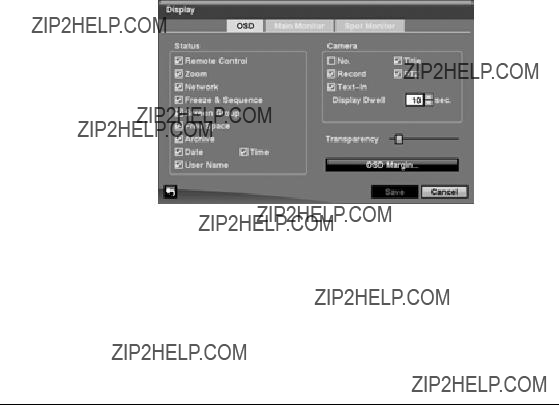
Configuration
a.The Day box allows you to select the days that the alarm schedule will be active. The choices are: Sun, Mon, Tue, Wed, Thu, Fri, Sat, M~F, Hol and All.
b.The Range box allows you to set the time that the alarm schedule will be active in
c.The Mode box allows you to set how the alarm reacts during the scheduled time. When set to On, the
d.The Channels box allows you to set which alarm outputs will be active. You can also select the DVR???s internal buzzer.
e.The  box allows you to delete an alarm output schedule. You will be asked to confirm whether or not you really wish to delete the schedule.
box allows you to delete an alarm output schedule. You will be asked to confirm whether or not you really wish to delete the schedule.
7.You can save your 
 . Selecting Cancel exits the screen without saving the changes.
. Selecting Cancel exits the screen without saving the changes.
Display Screen
1.Highlight Display in the Devices menu and press 
 . The Display screen (Figure
. The Display screen (Figure
Figure
66

Configuration
2.Highlighting an item and pressing 
 toggles that item On and Off. When an item is On, there is a checkmark in the box beside it. The following items can be turned On or Off:
toggles that item On and Off. When an item is On, there is a checkmark in the box beside it. The following items can be turned On or Off:
???Remote Control ??? The icon  displays when the DVR can be controlled by the infrared remote control.
displays when the DVR can be controlled by the infrared remote control.
???Zoom ??? The icon  displays on the enlarged video.
displays on the enlarged video.
???Network ??? The icon  displays when the unit is connected to a network via either Ethernet or modem.
displays when the unit is connected to a network via either Ethernet or modem.
???Freeze and Sequence ??? The icon  displays while in Freeze mode, and the
displays while in Freeze mode, and the  displays while in Sequence mode.
displays while in Sequence mode.
???Screen Group ??? The number of the screen group displays when the DVR is not in the 4x4 display mode of the
???Free Space ??? The icon  displays when the DVR is in Recycle mode, and the percentage of available storage space displays when the DVR is not in Recycle mode.
displays when the DVR is in Recycle mode, and the percentage of available storage space displays when the DVR is not in Recycle mode.
???Archive ??? The icon  displays when the DVR is archiving recorded data.
displays when the DVR is archiving recorded data.
???Date/Time ??? The current date and time information displays.
???User Name ??? The name of the current user logged in displays.
???Camera No. ??? The camera number displays at the
???Camera Title ??? The camera title displays at the
???Record ??? The record related icons display on each camera screen.
???PTZ ??? The icon  displays on each PTZ camera screen.
displays on each PTZ camera screen.
???
3.You can adjust the transparency of the setup screens by highlighting Transparency and using the Left and Right arrow buttons.
4.Highlighting OSD Margin??? and pressing 
 displays how OSD text will be displayed on the monitor. You can adjust the horizontal and vertical margins so that text and icons will not be hidden beyond the edges of the monitor.
displays how OSD text will be displayed on the monitor. You can adjust the horizontal and vertical margins so that text and icons will not be hidden beyond the edges of the monitor.
Figure
5.Highlight the Main Monitor tab to switch to the Sequence screen (Figure

Configuration
Figure
6.Here you can adjust the display dwell time for each camera displayed in sequence on the main monitor. Highlight the box beside Mode and press 
 . You can select between Full Sequence and Cameo Sequence.
. You can select between Full Sequence and Cameo Sequence.
Pressing SEQUENCE causes the DVR to sequence cameras, and the DVR can sequence cameras in two modes: Full and Cameo. In the Full mode, the DVR sequences through the cameras and displays them full screen. In the Cameo mode, the
Note Any cameras that are Off, have lost video or are set to Covert (unless the user has authority to view covert cameras) will be excluded from the Cameo sequence.
You can define the screen layout in a variety of formats and set the DVR to sequence through the different screen layouts (pages) so that all the cameras will be displayed. You can also set up the DVR to display one camera or a group of cameras all the time while cycling through the remaining cameras in a Cameo window. This can be done with one camera displayed full screen while displaying the cameo window as a PIP (picture in picture), or displaying the cameras in a grid pattern with the
Note Sequence cannot be used in the 4x4 display mode of the
7.You can adjust the display dwell time by highlighting the box beside Interval and pressing 
 . You can select dwell intervals ranging from 1 second to 1 minute.
. You can select dwell intervals ranging from 1 second to 1 minute.
8.Highlight Event Monitoring On and press 
 . Pressing
. Pressing 
 toggles between On and Off. When it is On, the DVR will display the camera associated with the event when an event occurs.
toggles between On and Off. When it is On, the DVR will display the camera associated with the event when an event occurs.
9.Highlight the Spot Monitor tab to switch to the Spot Monitor screen (Figure
68
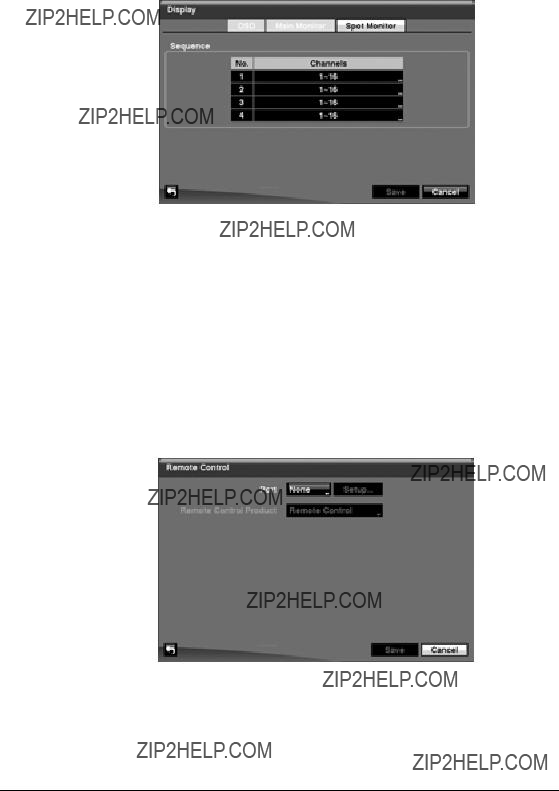
Configuration
Figure
10.You can define which cameras display sequentially on the Spot Monitors. Highlight the box in the Channels column for the desired Spot Monitor and press 
 .
.
11.You can save your Display settings by highlighting Save and pressing 
 . Selecting Cancel exits the screen without saving the changes.
. Selecting Cancel exits the screen without saving the changes.
Remote Control Screen
1.Highlight Remote Control in the Devices menu and press 
 . The Remote Control setup screen (Figure
. The Remote Control setup screen (Figure
Figure
2.Highlight the box beside Port and select from None, RS232 and RS485. If the RS232 port and RS485 port are in use for PTZ control, networking or text input, the remote keyboard cannot be configured.
3.Highlight Setup??? and select the correct Baud Rate, Parity, Data Bits and Stop Bits for the device you are connecting to the DVR.
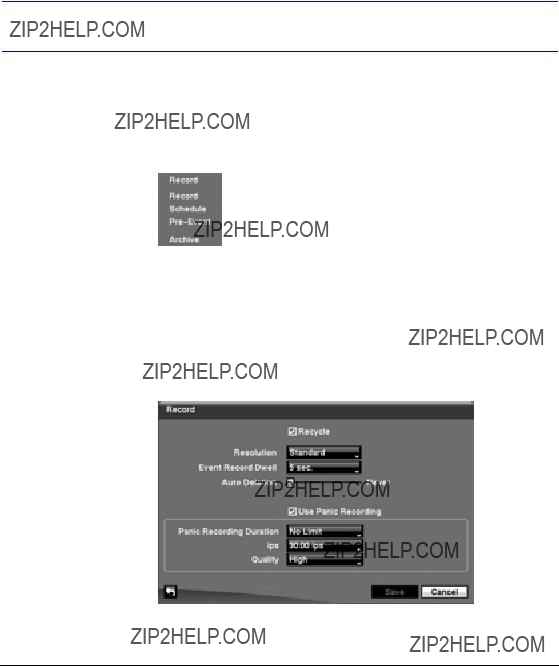
Configuration
4.Highlight the box beside Remote Control Product and select the device from the list.
5.You can save your Remote Control settings by highlighting Save and pressing

 . Selecting Cancel exits the screen without saving the changes.
. Selecting Cancel exits the screen without saving the changes.
Recording Settings
Your DVR offers a variety of flexible recording modes. You can set it up to record all the time or to only record events. It can be set up to continue recording once the hard disk drive is full by recording over the oldest video, or you can set it up to alert you when the hard disk is full and stop recording.
Figure
Record Screen
1.Highlight Record in the Record menu and press 
 . The Record setup screen (Figure
. The Record setup screen (Figure
Figure
70

Configuration
2.Highlighting Recycle and pressing 
 toggles between On and Off. In the Recycle mode, the DVR records over the oldest video data once all available storage space has been used. When Recycle is turned off, the DVR stops recording once all available storage space has been used.
toggles between On and Off. In the Recycle mode, the DVR records over the oldest video data once all available storage space has been used. When Recycle is turned off, the DVR stops recording once all available storage space has been used.
3.Highlight the Resolution box and select from High and Standard. All other variables being equal; selecting High resolution will decrease the recording and playback speed by half that of Standard resolution.
4.Highlight the Event Record Dwell box and set the length of time you would like to record for the associated event. You can set the dwell from 5 seconds to 15 minutes. Refer to Event Settings, page 75, for more information regarding event recording.
5.Highlight the slide bar beside Auto Deletion, and use the Left and Right arrow buttons to adjust the length of time recorded data will be kept from 1 to 99 days. The DVR automatically deletes video recorded earlier than the
6.Highlighting Use Panic Recording and pressing 
 toggles between On and
toggles between On and
Off.
7.Highlight the Panic Recording - Duration box and set the duration of panic recording. Panic recording will stop automatically after the preset duration as long as the PANIC button is not pressed to stop the panic recording. You can set the dwell from 5 minutes to 1 hour. Select No Limit if you only want to stop panic recording manually.
8.Highlighting the Panic Recording - ips and pressing 
 allows you to set the images per second for Panic recording. You can select from 0.10 to 30.00 images per second.
allows you to set the images per second for Panic recording. You can select from 0.10 to 30.00 images per second.
9.Highlighting the Panic Recording - Quality and pressing 
 allows you to set the recorded image quality for Panic recording. You can select from: Very High,
allows you to set the recorded image quality for Panic recording. You can select from: Very High,
High, Standard and Low.
10.You can save your Record settings by highlighting Save and pressing 
 . Selecting Cancel exits the screen without saving the changes.
. Selecting Cancel exits the screen without saving the changes.
Schedule Screen
1.Highlight Schedule in the Record menu and press 
 , and the Schedule setup screen (Figure
, and the Schedule setup screen (Figure
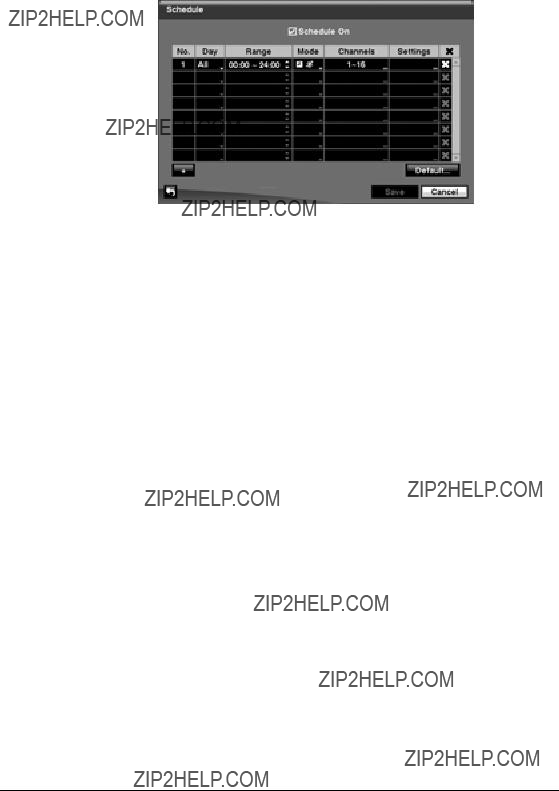
Configuration
Figure
You can program the DVR to record only during certain times based on time of day, day of the week, and holidays. The smallest time segment you can use is 15 minutes.
2.Highlighting Schedule On and pressing 
 toggles between On and Off. In the Schedule On mode, the DVR records video based on the schedule(s) established in the Schedule screen. When turning Schedule recording Off, you will be asked
toggles between On and Off. In the Schedule On mode, the DVR records video based on the schedule(s) established in the Schedule screen. When turning Schedule recording Off, you will be asked
to confirm your decision, and  displays at the
displays at the  displays during panic recording.
displays during panic recording.
3.Highlight the + and press 
 to add a schedule item.
to add a schedule item.
4.Highlight the box under the Day heading and press 
 to change the days that the scheduled recording will take place. Choose from: Sun, Mon, Tue, Wed, Thu,
to change the days that the scheduled recording will take place. Choose from: Sun, Mon, Tue, Wed, Thu,
Fri, Sat, M~F, Hol and All.
5.Highlight the box under the Range heading and press 
 to change the time range that the scheduled recording will take place. The smallest time segment you can use is 15 minutes.
to change the time range that the scheduled recording will take place. The smallest time segment you can use is 15 minutes.
6.Highlight the box under the Mode heading and press 
 to change the recording mode that will be used. Choose from: No Record, Time, Event and Time & Event.
to change the recording mode that will be used. Choose from: No Record, Time, Event and Time & Event.
When the DVR is in No Record mode, it will not record during the preset day and time range as long as the PANIC button is not pressed. Use the No Record mode when you do NOT want the DVR to record during certain times.
When the DVR is in Time mode, the  icon displays at the
icon displays at the  icon at the
icon at the
When the DVR is in Event mode, the red  icon displays at the
icon displays at the  icon at the
icon at the
mode, the yellow  icon displays when there is no event, and the DVR is not recording. When the DVR is in
icon displays when there is no event, and the DVR is not recording. When the DVR is in  and
and  display when any event occurs and the DVR starts recording.
display when any event occurs and the DVR starts recording.
When the DVR is in Time & Event mode, the DVR will follow the Time settings and
the  icon displays. The DVR follows the Event settings and the
icon displays. The DVR follows the Event settings and the  icon displays.
icon displays.
72
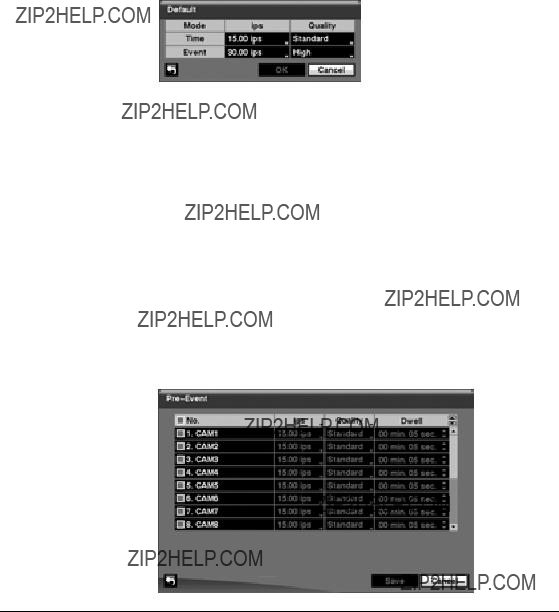
Configuration
7.Highlight the box under the Channels heading and press 
 to select which cameras will be recorded.
to select which cameras will be recorded.
8.Highlight the box under the Settings heading and press 
 to define the recording settings. You can set the ips and Quality of the recording for any modes you set up in the Mode column. If you do not set the ips and Quality in the Settings column, the DVR will follow the default settings. See Figure
to define the recording settings. You can set the ips and Quality of the recording for any modes you set up in the Mode column. If you do not set the ips and Quality in the Settings column, the DVR will follow the default settings. See Figure
9.Highlight the box under the  heading and press
heading and press 
 to delete the recording settings. You will be asked to confirm that you want to delete the settings.
to delete the recording settings. You will be asked to confirm that you want to delete the settings.
10.Highlight Default??? and press 
 . The Default screen appears.
. The Default screen appears.
Figure
11.Highlighting boxes under ips and pressing 
 allows you to set the images per second for Time and Event recording. You can select from 0.10 to 30.00 images per second.
allows you to set the images per second for Time and Event recording. You can select from 0.10 to 30.00 images per second.
12.Highlighting boxes under Quality and pressing 
 allows you to set the recorded image quality for Time and Event recording. You can select from: Very High,
allows you to set the recorded image quality for Time and Event recording. You can select from: Very High,
High, Standard and Low.
13.You can save your changes by highlighting Save and pressing 
 . Selecting Cancel exits the screen without saving the changes.
. Selecting Cancel exits the screen without saving the changes.
1.Highlight 
 , and the
, and the
Figure
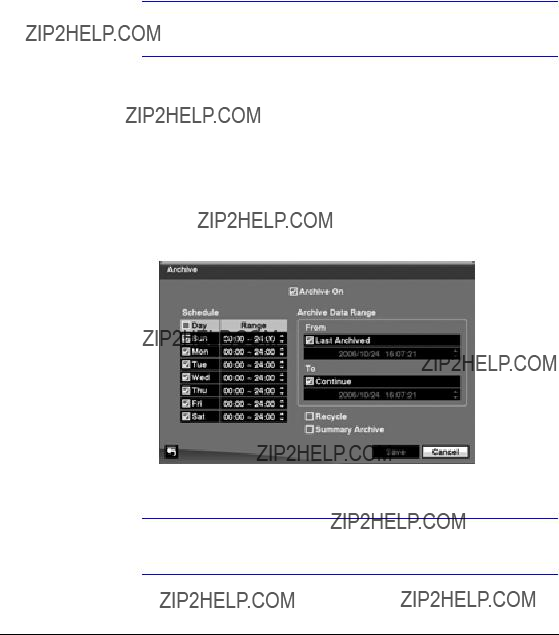
Configuration
When the DVR is in the Event Record mode it is possible to have it record images before the event occurs. The
2.You can turn individual cameras On or Off for
3.You can set the amount of time to record prior to the event by adjusting the Dwell. You can set the Dwell from 5 seconds to 30 minutes. The longer the dwell set, the fewer maximum ips can be set.
Note When the DVR is in the Time or Time & Event mode, it ignores the
4.You can save your changes by highlighting Save and pressing 
 . Selecting Cancel exits the screen without saving the changes.
. Selecting Cancel exits the screen without saving the changes.
Archive Screen
1.Highlight Archive in the Record menu and press 
 , and the Archive setup screen (Figure
, and the Archive setup screen (Figure
Figure
2.Highlight Archive On and press 
 to toggle between On and Off.
to toggle between On and Off.
Note If you have not set up a storage device for archiving, a message appears notifying you of this.
3.Select the Days and Time Range you want archived.
74
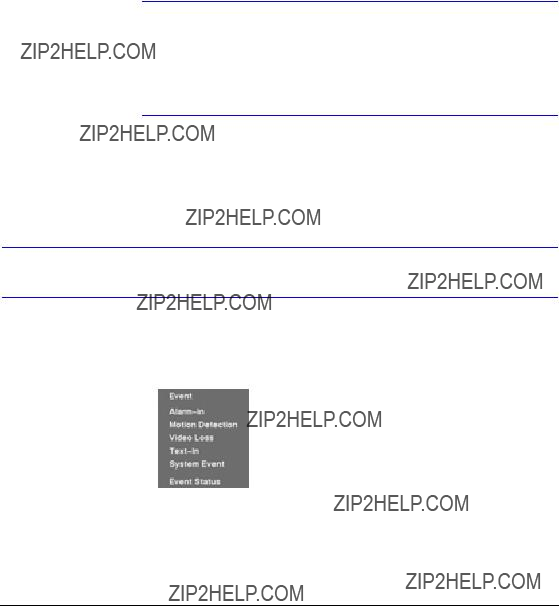
Configuration
4.You can accept the Archive Data Range by leaving the default checkmarks in the Last Archived and Continue boxes. If you wish to enter specific times and dates in From and To, toggle the checkmarks Off and then enter the time and date.
5.Highlight Recycle and press 
 to toggle between On and Off. When Recycle is On and the storage device is full, the newest archived video data will overwrite the oldest archived data. When Recycle is Off, the DVR will stop archiving video data until more space is made available.
to toggle between On and Off. When Recycle is On and the storage device is full, the newest archived video data will overwrite the oldest archived data. When Recycle is Off, the DVR will stop archiving video data until more space is made available.
6.Highlight Summary Archive and press 
 to toggle between On and Off. When Summary Archive is On, the DVR does not archive recorded video in full, but archives one image per 16 images from each channel. This will allow the DVR to archive more recorded video and increase archive speed as well.
to toggle between On and Off. When Summary Archive is On, the DVR does not archive recorded video in full, but archives one image per 16 images from each channel. This will allow the DVR to archive more recorded video and increase archive speed as well.
Note The archiving speed might be slower than the recording speed when a large quantity of recorded data is being archived. In this case, the old data can be overwritten by the latest data being recorded. To prevent unwanted data overwriting please use the Summary Archive function, or set the recorded image quality to Standard during the archiving process.
7.You can save your changes by highlighting Save and pressing 
 . Selecting Cancel exits the screen without saving the changes.
. Selecting Cancel exits the screen without saving the changes.
Event Settings
Your DVR can be set to detect many different events. You can also determine how it reacts to these events.
Figure

Configuration
1.Highlight 
 . The
. The
Figure
2.The alarm terminal strip on the back of the DVR has inputs associated with each alarm. You can set up each input on the 
 .
.
3.Each input can be given a title. Highlight the desired Title box and press 
 . A virtual keyboard appears allowing you to enter a title name.
. A virtual keyboard appears allowing you to enter a title name.
4.Each input can be set as NO (normally open) or NC (normally closed).
5.You can set the DVR to start panic recording whenever it senses an input on one of its alarm input connectors. Highlight the box beside Panic Record and press 
 . A list of Alarm Inputs appears, allowing you to select which alarm input you want associated with panic recording. The DVR will continue panic recording until an input on the selected alarm input is released, as long as the PANIC button is not pressed to stop the panic recording.
. A list of Alarm Inputs appears, allowing you to select which alarm input you want associated with panic recording. The DVR will continue panic recording until an input on the selected alarm input is released, as long as the PANIC button is not pressed to stop the panic recording.
6.Highlight the Actions 1 and Actions 2 tabs, and the Actions 1 (Figure
Figure
76

Configuration
You can set the actions the DVR will take whenever it senses an input on one of its alarm input connectors.
7.Highlight the desired box under the Record heading, and press 
 . A list of cameras appears. Select the cameras that you want the DVR to record whenever it detects an input on the associated alarm input.
. A list of cameras appears. Select the cameras that you want the DVR to record whenever it detects an input on the associated alarm input.
Note For the Record action, the camera you select should be set to the Event or Time & Event recording mode in the Record Schedule setup screen.
8.Highlight the desired box under the 
 . A list of Alarm Outputs and Beep appear. Select the Alarm Output connectors that you would like to activate whenever the DVR detects an input on the associated alarm input. You can also set the DVR???s internal buzzer to sound.
. A list of Alarm Outputs and Beep appear. Select the Alarm Output connectors that you would like to activate whenever the DVR detects an input on the associated alarm input. You can also set the DVR???s internal buzzer to sound.
Note For the
9.Highlight the desired box under the Notify heading, and press 
 . The
. The
Figure
10.You can toggle the entire list On and Off by highlighting Notification and pressing

 . You can toggle the individual items On and Off by highlighting that item and
. You can toggle the individual items On and Off by highlighting that item and
pressing 
 . Highlight OK and press
. Highlight OK and press 
 to accept your changes.
to accept your changes.
Note For the Notify action, the notify item you select should be enabled in the Notification setup screen and the DVR should be registered in the RAS (Remote Administration System).
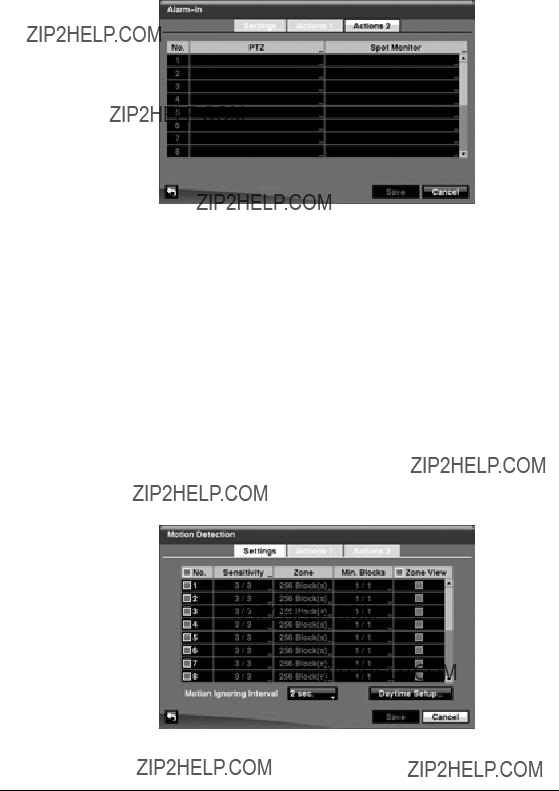
Configuration
Figure
11. In the Actions 2 tab, highlight the desired box under the PTZ heading, and press

 . A list of PTZ presets appears. Select the preset position for each PTZ camera, where you want PTZ cameras to move to whenever the DVR detects an input on the associated alarm input.
. A list of PTZ presets appears. Select the preset position for each PTZ camera, where you want PTZ cameras to move to whenever the DVR detects an input on the associated alarm input.
12.Highlight the desired box under the Spot Monitor heading, and press 
 . A list of SPOT monitors and cameras appears. Each SPOT monitor can be associated with a camera. The DVR will display the associated camera on the SPOT monitor whenever it detects an input on the associated alarm input.
. A list of SPOT monitors and cameras appears. Each SPOT monitor can be associated with a camera. The DVR will display the associated camera on the SPOT monitor whenever it detects an input on the associated alarm input.
13.You can save your 
 . Selecting Cancel exits the screen without saving the changes.
. Selecting Cancel exits the screen without saving the changes.
Motion Detection Screen
1.Highlight Motion Detection in the Event menu and press 
 . The Motion Detection setup screen (Figure
. The Motion Detection setup screen (Figure
Figure
2.Your DVR has 
 .
.
78
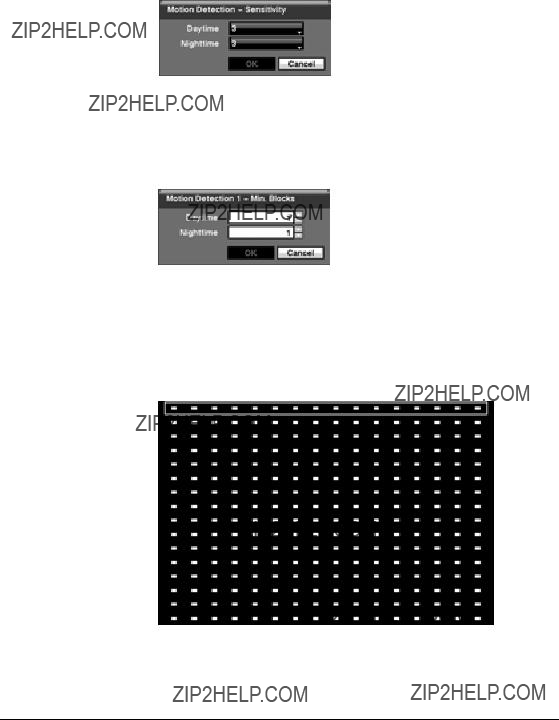
Configuration
3.Highlighting the box under the Sensitivity heading and pressing 
 allows you to adjust the DVR???s sensitivity to motion for Daytime and Nighttime independently. There are five settings with 1 being the least sensitive and 5 being the most sensitive.
allows you to adjust the DVR???s sensitivity to motion for Daytime and Nighttime independently. There are five settings with 1 being the least sensitive and 5 being the most sensitive.
Figure
4.You can adjust the minimum number of detection blocks that must be activated to trigger a motion alarm. Highlighting the box under the Min. Blocks heading and pressing 
 allows you to adjust the minimum number of detection blocks for Daytime and Nighttime independently. Smaller numbers provide greater sensitivity because fewer detection blocks must be activated.
allows you to adjust the minimum number of detection blocks for Daytime and Nighttime independently. Smaller numbers provide greater sensitivity because fewer detection blocks must be activated.
Figure
5.Turning Zone View On will allow you to observe how the DVR is reacting to motion. When in the motion viewing mode, the detection zone of video will be displayed in green. Any detected motion within the zone will be displayed in red.
6.You can define the area of the image where you want to detect motion; for example, a doorway. Highlight the box under the Zone heading, and press 
 . The Motion Detection Zone screen (Figure
. The Motion Detection Zone screen (Figure
Figure
The Motion Detection Zone screen is laid over the video for the selected camera. You can set up motion detection zones by selecting or clearing blocks.
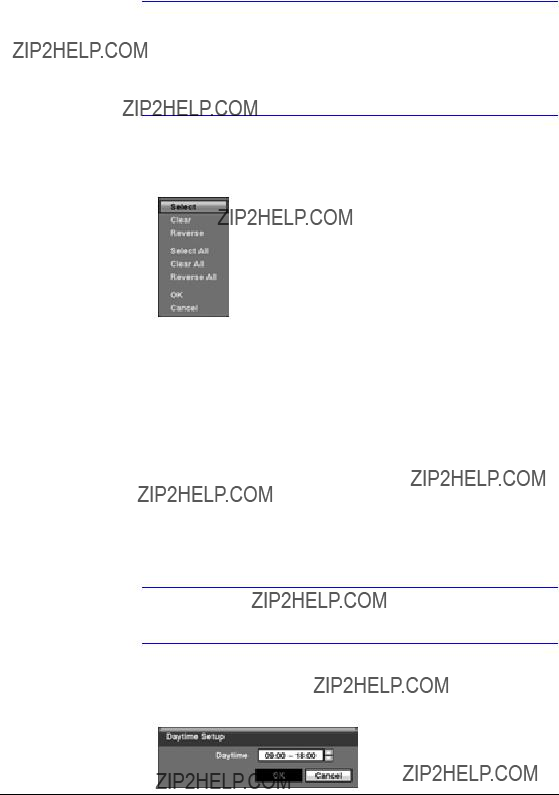
Configuration
Note You can set up motion zones one block at a time in groups of 8 or 16 individual block groups (9- and
7.Press 
 to display the menu screen. The menu on the setup screen has the following functions:
to display the menu screen. The menu on the setup screen has the following functions:
Figure
???Select ??? Activates highlighted blocks to detect motion.
???Clear ??? Deactivates highlighted blocks so that they will not detect motion.
???Reverse ??? Activates inactive highlighted blocks and deactivates active highlighted blocks.
???Select All ??? Activates all blocks to detect motion.
???Clear All ??? Deactivates all blocks so that they will not detect motion.
???Reverse All ??? Activates inactive blocks and deactivates active blocks.
???OK ??? Accepts changes and closes Zone setup.
???Cancel ??? Exits Zone setup without saving changes.
8.You can control excessive event logging and remote notification of motions detected after the motion dwell time by adjusting the motion ignoring dwell intervals. Highlight the box beside Motion Ignoring Interval and press 
 . A list of intervals ranging from 1 to 10 seconds or Never appears. The DVR will not log and notify motion events occurred during the preset interval range.
. A list of intervals ranging from 1 to 10 seconds or Never appears. The DVR will not log and notify motion events occurred during the preset interval range.
Note The record action for motion events will not be affected by the
Motion Ignoring function.
9.Highlighting the box beside Daytime Setup and pressing 
 allows you to set up the Daytime range.
allows you to set up the Daytime range.
Figure
80
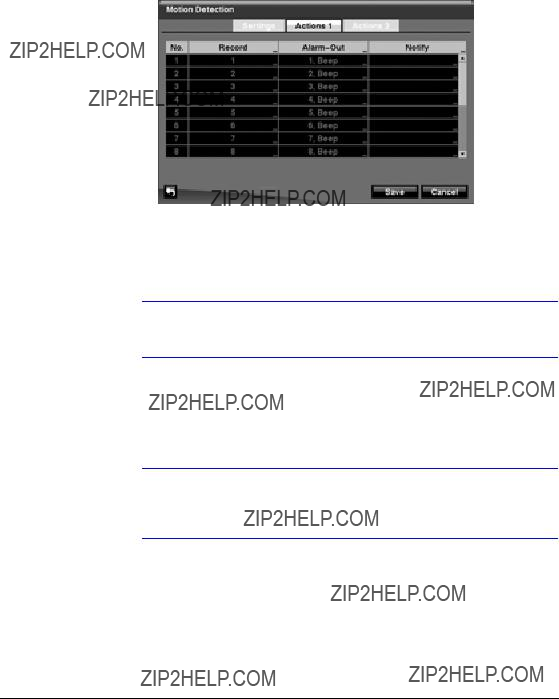
Configuration
10.Highlight the box beside Daytime and press 
 . Use the Up and Down arrow buttons to set the Daytime range. The DVR will consider the remaining time range as the Nighttime.
. Use the Up and Down arrow buttons to set the Daytime range. The DVR will consider the remaining time range as the Nighttime.
11.Highlight the Actions 1 and Actions 2 tabs and the Motion Detection Actions 1 (Figure
Figure
The DVR can be set to react to motion detection differently for each camera. Each camera can be associated with another camera, trigger an
Note You can associate multiple cameras with a camera that detects motion.
12.Highlight the box under the Record heading and press 
 . A list of cameras appears. You can associate as many cameras with that camera as you wish. If the DVR detects motion on the selected camera, it starts recording video from all the associated cameras.
. A list of cameras appears. You can associate as many cameras with that camera as you wish. If the DVR detects motion on the selected camera, it starts recording video from all the associated cameras.
Note For the Record action, the camera you select should be set to the Event or Time & Event recording mode in the Record Schedule setup screen.
13.Highlight the box under the 
 . A list of Alarm Outputs appears. You can associate as many
. A list of Alarm Outputs appears. You can associate as many

Configuration
Note For the
14.Highlight the box under the Notify heading and press 
 . You can toggle the entire list On and Off by highlighting Notification and pressing
. You can toggle the entire list On and Off by highlighting Notification and pressing 
 . You can toggle the individual items On and Off by highlighting that item and pressing
. You can toggle the individual items On and Off by highlighting that item and pressing 
 . Highlight OK and press
. Highlight OK and press 
 to accept your changes.
to accept your changes.
Note For the Notify action, the notify item you select should be enabled in the Notification setup screen and the DVR should be registered in the RAS (Remote Administration System).
Figure
15. In the Actions 2 tab, highlight the desired box under the PTZ heading, and press

 . A list of PTZ presets appears. Select the preset position for each PTZ camera, where you want PTZ cameras to move to whenever the DVR detects motion on the selected camera???s input.
. A list of PTZ presets appears. Select the preset position for each PTZ camera, where you want PTZ cameras to move to whenever the DVR detects motion on the selected camera???s input.
16.Highlight the desired box under the Spot Monitor heading, and press 
 . A list of SPOT monitors and cameras appears. Each SPOT monitor can be associated with a camera. The DVR will display the associated camera on the SPOT monitor whenever it detects motion on the selected camera.
. A list of SPOT monitors and cameras appears. Each SPOT monitor can be associated with a camera. The DVR will display the associated camera on the SPOT monitor whenever it detects motion on the selected camera.
17.You can save your Motion Detection changes by highlighting Save and pressing

 . Selecting Cancel exits the screen without saving the changes.
. Selecting Cancel exits the screen without saving the changes.
82
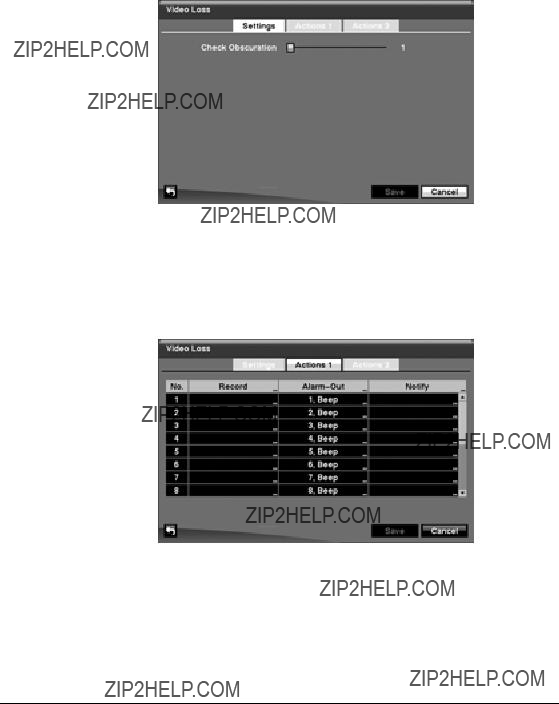
Configuration
Video Loss Screen
1.Highlight Video Loss in the Event menu and press 
 . The Video Loss setup screen (Figure
. The Video Loss setup screen (Figure
Figure
2.The DVR checks to see if anything is obscuring the camera. Highlight the slider bar beside Check Obscuration, and use the Left and Right arrow buttons to adjust the setting. The sensitivity can be set from Never to 255 (extremely sensitive).
3.Highlight the Actions 1 and Actions 2 tabs and the Video Loss Actions 1 and Actions 2 screens display.
Figure
The DVR can be set to react to video loss differently for each camera. Each camera can be associated with another camera, trigger an
4.Highlight the box under the Record heading and press 
 . A list of cameras appears. You can associate as many cameras with that camera as you wish. If the DVR detects video loss on the selected camera, it starts recording video from all the associated cameras.
. A list of cameras appears. You can associate as many cameras with that camera as you wish. If the DVR detects video loss on the selected camera, it starts recording video from all the associated cameras.
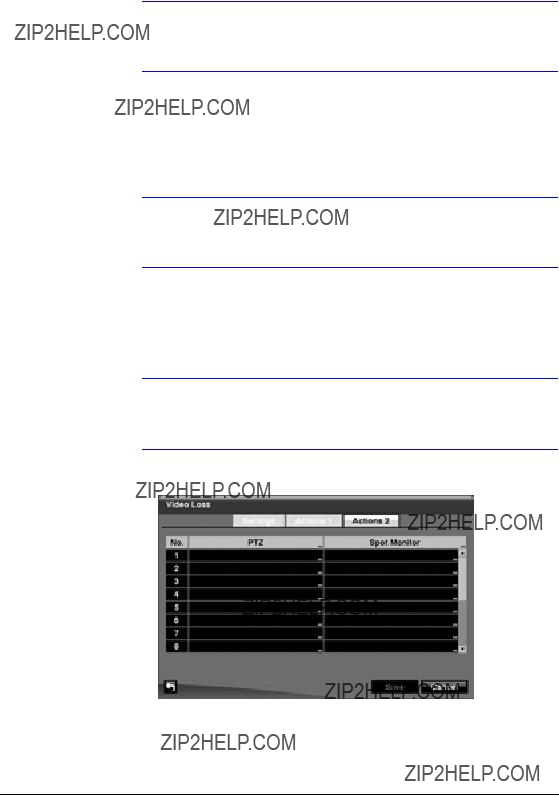
Configuration
Note For the Record action, the camera you select should be set to the Event or Time & Event recording mode in the Record Schedule setup screen.
5.Highlight the box under the 
 . A list of Alarm Outputs appears. You can associate as many
. A list of Alarm Outputs appears. You can associate as many
Note For the
6.Highlight the box under the Notify heading and press 
 . You can toggle the entire list On and Off by highlighting Notification and pressing
. You can toggle the entire list On and Off by highlighting Notification and pressing 
 . You can toggle the individual items On and Off by highlighting that item and pressing
. You can toggle the individual items On and Off by highlighting that item and pressing 
 . Highlight OK and press
. Highlight OK and press 
 to accept your changes.
to accept your changes.
Note For the Notify action, the notify item you select should be enabled in the Notification setup screen and the DVR should be registered in the RAS (Remote Administration System).
Figure
7.Highlight the desired box under the PTZ heading, and press 
 . A list of PTZ presets appears. Select the preset position for each PTZ camera, this is where you want PTZ cameras to move to when the DVR detects video loss on the selected camera???s input.
. A list of PTZ presets appears. Select the preset position for each PTZ camera, this is where you want PTZ cameras to move to when the DVR detects video loss on the selected camera???s input.
84
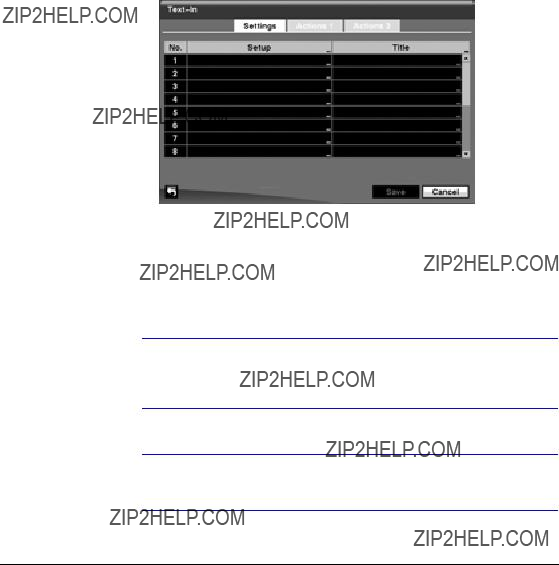
Configuration
8.Highlight the box under the Spot Monitor heading and press 
 . A list of SPOT monitors and cameras appears. Each SPOT monitor can be associated with a camera. The DVR will display the associated camera on the SPOT monitor whenever it detects video loss on the selected camera.
. A list of SPOT monitors and cameras appears. Each SPOT monitor can be associated with a camera. The DVR will display the associated camera on the SPOT monitor whenever it detects video loss on the selected camera.
9.You can save your Video Loss changes by highlighting Save and pressing 
 . Selecting Cancel exits the screen without saving the changes.
. Selecting Cancel exits the screen without saving the changes.
1.Highlight 
 . The
. The
Figure
The DVR can be setup to react to text input from devices such as ATMs (Automated Teller Machines) and POS (Point of Sale; as in cash registers). This screen allows you to configure the DVR for each
2.Highlight the box under the Setup heading, and press 
 . Selecting the Setup heading changes all the parameters excluding Port settings of all the text input channels.
. Selecting the Setup heading changes all the parameters excluding Port settings of all the text input channels.
Note The system performance might be affected when a large quantity of text inputs are detected from several channels at the same time.
Note VP Filter, Generic Text and

Configuration
Figure
Figure
Screen
3.Highlight the box beside Port, and press 
 . Select from None, RS232, RS485 and
. Select from None, RS232, RS485 and
Note If you have set the Port as None, you will not be able to make any changes to the screen.
Note When using the USB to serial
USB cable from the port while the system is running.
4.Highlight Setup???, and press 
 . Use the ATM or POS manufacturer???s recommended settings when configuring the RS232, RS485 or
. Use the ATM or POS manufacturer???s recommended settings when configuring the RS232, RS485 or
5.Highlight the box beside 
 . Select your device from the list.
. Select your device from the list.
86

Configuration
Note The screen changes for the different types of text input devices, changing the parameter boxes for you to enter information.
6.Highlight the box beside Virtual Port, and press 
 . Select the port number to use. This field will be activated only when setting up the VP Filter device.
. Select the port number to use. This field will be activated only when setting up the VP Filter device.
7.Highlight the box beside Transaction Start, and press 
 . Use the virtual keyboard to enter the Transaction Start string. Refer to the device manufacturer???s documentation for the text string that the device first sends when a transaction starts.
. Use the virtual keyboard to enter the Transaction Start string. Refer to the device manufacturer???s documentation for the text string that the device first sends when a transaction starts.
8.If you want the DVR to react to any character sent from the text input device, you will want to turn on Any Character. Highlight Any Character, and press 
 to toggle between On and Off.
to toggle between On and Off.
Note If Any Character is turned On, you will not be able to enter any
text in the Transaction Start box.
9.Highlight the box beside Transaction End, and press 
 . Use the virtual keyboard to enter the Transaction End string. Refer to the device manufacturer???s documentation for the text string that the device sends when a transaction ends.
. Use the virtual keyboard to enter the Transaction End string. Refer to the device manufacturer???s documentation for the text string that the device sends when a transaction ends.
10.Highlight the more line(s) box, and press 
 . Select the number of additional lines of text that you want the DVR to record. You can choose from 0 to 10.
. Select the number of additional lines of text that you want the DVR to record. You can choose from 0 to 10.
11.Highlight the box beside Line Delimiter, and press 
 . Use the virtual keyboard to enter the character(s) that the device uses to indicate the end of a line. Special characters can be created using ^ and a capital letter; for example, ^J for NL (New Line), ^M for CR (Carriage Return). Refer to the device manufacturer???s documentation for Line Delimiter character(s).
. Use the virtual keyboard to enter the character(s) that the device uses to indicate the end of a line. Special characters can be created using ^ and a capital letter; for example, ^J for NL (New Line), ^M for CR (Carriage Return). Refer to the device manufacturer???s documentation for Line Delimiter character(s).
12.Highlight the box beside Ignore String, and press 
 . Use the virtual keyboard to enter any strings of text that you want the DVR to ignore. Refer to the device manufacturer???s documentation for text strings that the device sends during transactions, so you will know which ones you do not want recorded.
. Use the virtual keyboard to enter any strings of text that you want the DVR to ignore. Refer to the device manufacturer???s documentation for text strings that the device sends during transactions, so you will know which ones you do not want recorded.
13.Highlight the Case Sensitive box, and press 
 to toggle between On and Off. Refer to the device manufacturer???s documentation to determine if the text strings are Case Sensitive. If the device distinguishes between upper and lower case letters, make certain the Case Sensitive box is enabled.
to toggle between On and Off. Refer to the device manufacturer???s documentation to determine if the text strings are Case Sensitive. If the device distinguishes between upper and lower case letters, make certain the Case Sensitive box is enabled.
14.Highlight the box beside Time Out, and press 
 . Set the length of time to wait for the next text string. The DVR will consider a transaction ended if there is no text string during timeout dwell time after the last text input string. You can adjust Time Out dwell from 0 seconds to 10 minutes.
. Set the length of time to wait for the next text string. The DVR will consider a transaction ended if there is no text string during timeout dwell time after the last text input string. You can adjust Time Out dwell from 0 seconds to 10 minutes.
15.Highlight the Actions 1 and Actions 2 tabs and the

Configuration
Figure
The DVR can be set to react to text input. Text input can be associated with cameras, trigger an
16.Highlight the box under the Record heading and press 
 . A list of cameras appears. You can associate as many cameras with the Text Input as you wish. If the DVR detects text input, it starts recording video from all the associated cameras.
. A list of cameras appears. You can associate as many cameras with the Text Input as you wish. If the DVR detects text input, it starts recording video from all the associated cameras.
Note For the Record action, the camera(s) you select should be set to the Event or Time & Event recording mode in the Record Schedule setup screen.
17.Highlight the box under the 
 . A list of Alarm Outputs appears. You can associate as many
. A list of Alarm Outputs appears. You can associate as many
Note For the
18.Highlight the box under the Notify heading and press 
 . You can toggle the entire list On and Off by highlighting Notification and pressing
. You can toggle the entire list On and Off by highlighting Notification and pressing 
 . You can toggle the individual items On and Off by highlighting that item and pressing
. You can toggle the individual items On and Off by highlighting that item and pressing 
 . Highlight OK and press
. Highlight OK and press 
 to accept your changes.
to accept your changes.
88

Configuration
Note For the Notify action, the notify item you select should be enabled in the Notification setup screen and the DVR should be registered in the RAS (Remote Administration System).
Figure
19.Highlight the desired box under the PTZ heading, and press 
 . A list of PTZ presets appears. Select the preset positions for each PTZ camera, this is where you want PTZ cameras to move to when the DVR detects text input.
. A list of PTZ presets appears. Select the preset positions for each PTZ camera, this is where you want PTZ cameras to move to when the DVR detects text input.
20.Highlight the box under the Spot Monitor and press 
 . A list of SPOT monitors and cameras appears. Each SPOT monitor can be associated with a camera. The DVR will display the associated camera on the SPOT monitor whenever it detects an input on the selected
. A list of SPOT monitors and cameras appears. Each SPOT monitor can be associated with a camera. The DVR will display the associated camera on the SPOT monitor whenever it detects an input on the selected
21.You can save your 
 . Selecting Cancel exits the screen without saving the changes.
. Selecting Cancel exits the screen without saving the changes.
System Event Screen
1.Highlight System Event in the Event menu and press 
 . The System Event setup screen (Figure
. The System Event setup screen (Figure

Configuration
Figure
The DVR can be configured to run
2.Highlighting the box beside System and pressing 
 allows you to select the interval that you want the DVR to run
allows you to select the interval that you want the DVR to run
3.Highlight the Setup... box beside Check Recording and press 
 . The Check Recording screen appears. Highlighting Schedule On and pressing
. The Check Recording screen appears. Highlighting Schedule On and pressing 
 toggles the schedules On and Off. When set to On, you can select the day, time range and interval that you want the DVR to run
toggles the schedules On and Off. When set to On, you can select the day, time range and interval that you want the DVR to run  box allows you to delete a check recording schedule.
box allows you to delete a check recording schedule.
Figure
4.Highlighting the box under the Interval heading beside each 
 allows you to change the interval that you want the DVR to run
allows you to change the interval that you want the DVR to run
5.Highlight the Storage tab and the Storage screen (Figure
90
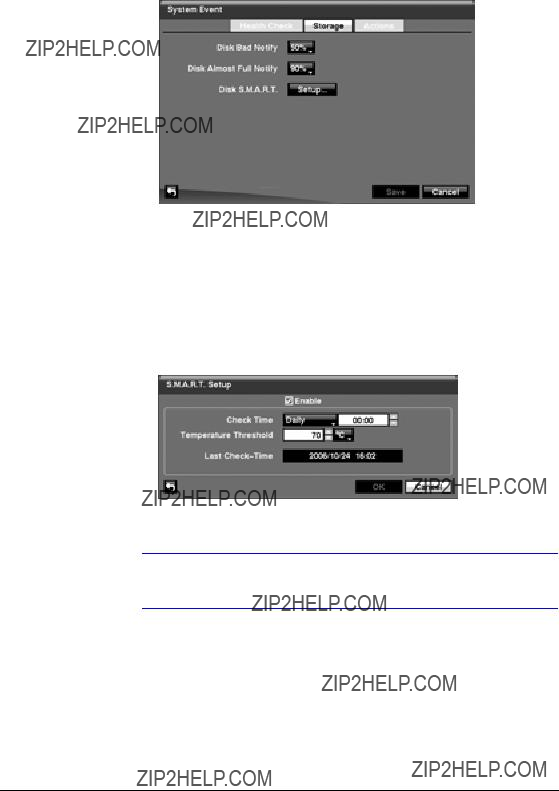
Configuration
Figure
6.Highlight the box beside Disk Bad Notify, and press 
 . Select the percentage level of bad disk sectors at which point you want the DVR to trigger an alert. Percentage levels range from 10% to 90%.
. Select the percentage level of bad disk sectors at which point you want the DVR to trigger an alert. Percentage levels range from 10% to 90%.
7.Highlight the box beside Disk Almost Full Notify, and press 
 . Select the percentage level of disk usage at which point you want the DVR to trigger an alert. Percentage levels range from 80% to 99%.
. Select the percentage level of disk usage at which point you want the DVR to trigger an alert. Percentage levels range from 80% to 99%.
8.Highlight the Setup??? box beside Disk S.M.A.R.T., and press 
 . The S.M.A.R.T. Setup screen (Figure
. The S.M.A.R.T. Setup screen (Figure
Figure
9.Highlight Enable, and press 
 to toggle S.M.A.R.T. Setup On and Off.
to toggle S.M.A.R.T. Setup On and Off.
Note If Enable is turned Off, you will not be able to make changes to any of the other fields.
10.Highlight the box beside Check Time, and press 
 . You can select from Monthly, Weekly and Daily. If you select Monthly, you will be asked to set the Day of the Month and Time to perform the check. If you select Weekly, you will be asked to set the Day of the Week and Time. If you select Daily, you will be asked to set the Time.
. You can select from Monthly, Weekly and Daily. If you select Monthly, you will be asked to set the Day of the Month and Time to perform the check. If you select Weekly, you will be asked to set the Day of the Week and Time. If you select Daily, you will be asked to set the Time.
11.Highlight the first box beside Temperature Threshold, and press 
 . Use the Up and Down arrow buttons to scroll through the numbers. Refer to the hard disk drive manufacturer???s documentation for the correct temperature setting. If the temperature of the hard disk drive exceeds the defined threshold, the system triggers an alert.
. Use the Up and Down arrow buttons to scroll through the numbers. Refer to the hard disk drive manufacturer???s documentation for the correct temperature setting. If the temperature of the hard disk drive exceeds the defined threshold, the system triggers an alert.

Configuration
12.Highlight the second box beside Temperature Threshold, and press 
 . Select either ??C (Celsius) or ??F (Fahrenheit), and press
. Select either ??C (Celsius) or ??F (Fahrenheit), and press 
 .
.
Note The box beside Last
13.Highlight OK, and press 
 to accept the changes. Selecting Cancel exits the screen without saving the changes.
to accept the changes. Selecting Cancel exits the screen without saving the changes.
14.Highlight the Actions tab and the System Event Actions screen (Figure
Figure
The DVR can be setup to react to system events. System events can be associated with an
15.Highlight the 
 . A list of Alarm Outputs appears. You can associate as many
. A list of Alarm Outputs appears. You can associate as many
16.Highlight the Notify box beside the desired event and press 
 . You can toggle the entire list On and Off by highlighting Notification and pressing
. You can toggle the entire list On and Off by highlighting Notification and pressing 
 . You can toggle the individual items On and Off by highlighting that item and pressing
. You can toggle the individual items On and Off by highlighting that item and pressing 
 . Highlight OK and press
. Highlight OK and press 
 to accept your changes.
to accept your changes.
92
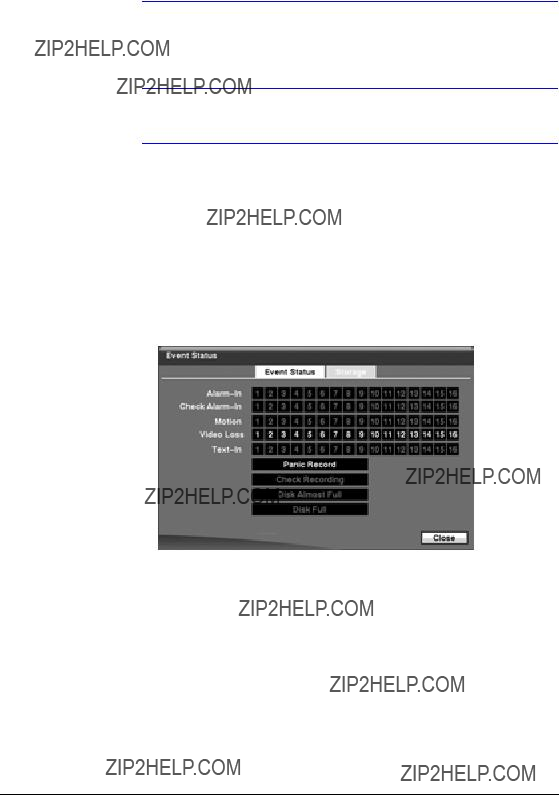
Configuration
Note For the Notify action to work, the DVR should be registered in the
RAS (Remote Administration System).
17.You can save your System Event changes by highlighting Save and pressing 
 . Selecting Cancel exits the screen without saving the changes.
. Selecting Cancel exits the screen without saving the changes.
Event Status Screen
Highlight Event Status in the Event menu and press 
 . The Event Status screen (Figure
. The Event Status screen (Figure
Figure
The Event Status screen displays the status of the DVR???s systems and inputs. The following events will be highlighted, and related channels or events will flicker for five seconds when detected:
???
???Check
???Panic Record will be highlighted while the DVR is in the panic recording mode.

Configuration
???Disk Almost Full will be highlighted when the DVR is not in the Recycle mode and the level of disk usage reaches the Disk Almost Full percentage you specified in the System Event setup screen on the Event menu. Disk Full will be highlighted when the DVR is not in the Recycle mode and all available storage space has been used.
Highlighting the Storage tab will display the hard disk drive status. Refer to Storage Screen, page 45 for more details.
94
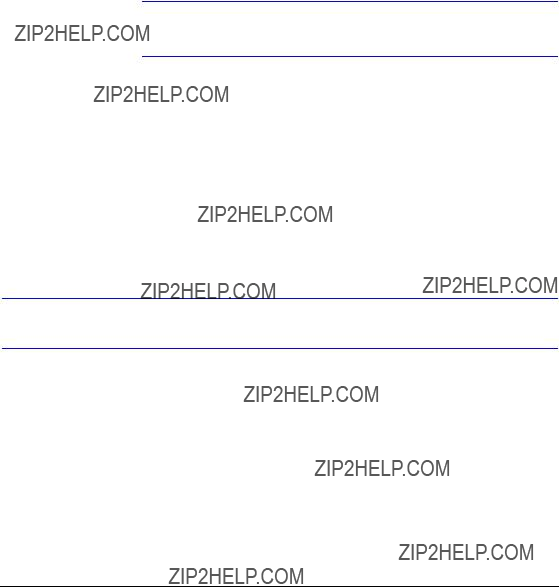
Operation
4
Operation
Note This chapter assumes your DVR has been installed and configured. If it has not, please refer to Chapter 2 and Chapter 3.
The DVR???s controls are similar to a VCR. As with a VCR, the main functions are recording and playing back video. However, you have much greater control over recording and playing back video. You can establish recording schedules based on time of day and day of the week. The DVR allows you to search through the recorded video using much more sophisticated tools than those available with VCRs. Additional DVR features that are not available with VCRs are remote control and viewing, and recording video at the same time you are watching previously recorded video.
The front panel controls are described in Chapter 3, Configuration.
Turning on the Power
Once you have installed the DVR following the instructions in Chapter 2, Installation, it is ready to record.
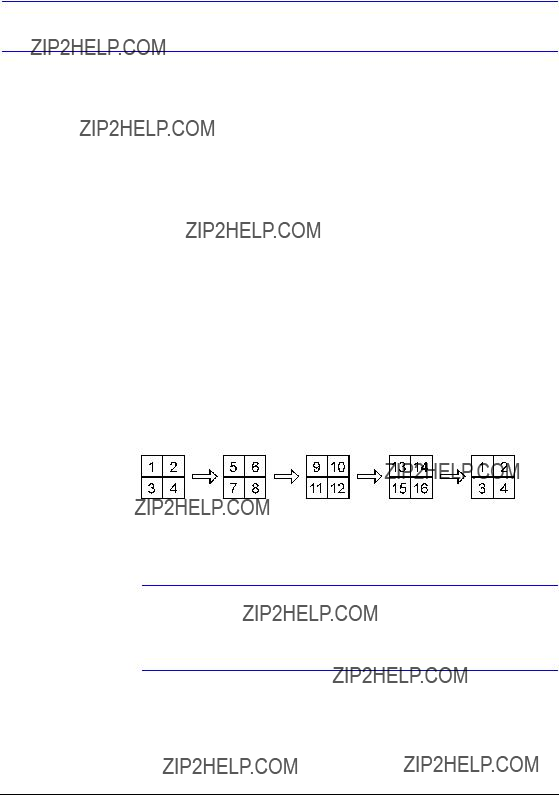
Operation
Live Monitoring
As soon as the DVR completes its initialization process, it will begin showing live video on the attached monitor and playing live audio through the attached speaker. The default mode is to display all cameras at once. Pressing any camera button will cause that camera to display full screen. It displays live video and plays live audio until the user enters another mode.
Pressing DISPLAY cycles the DVR through the different display formats.
The DVR can be set to display
Pressing SEQUENCE causes the cameras to display sequentially. When in one of the
If all the cameras in a page are Off, have lost video or are set to Covert (unless the user has authority to view covert cameras), that page will be excluded from the sequence.
Note The Full Sequence for the full sequence monitoring and the Cameo Sequence for the cameo sequence monitoring should be selected in the Display setup screen, Sequence tab (see
Pressing FREEZE will freeze the current image on the screen until you press the button again. While in the Freeze mode, the icon  displays in
displays in
To display cameras sequentially on a spot monitor, press SPOT and select the Spot Monitor and Sequence from the menu.
96

Operation
Active Cameo Mode
You can enter the Active Cameo mode by pressing 
 in any
in any 
 while in the Active Cameo mode exits the Active Cameo mode. The active cameo mode will remain in effect for 15 seconds if there is no further operation.
while in the Active Cameo mode exits the Active Cameo mode. The active cameo mode will remain in effect for 15 seconds if there is no further operation.
In active cameo mode, press the button for the camera you want displayed as active cameo. After setting the camera number to active cameo, the DVR moves the active cameo to the next cameo. You can change the screen layout in this way.
PIP Mode
You can display a
Zoom Mode
You can enlarge an area of the video by pressing ZOOM. For a few seconds after pressing ZOOM, a PIP displays. Inside the PIP, a rectangle shows the area that is enlarged. You can move the rectangle around using the arrow buttons. While in the Zoom mode, you can enlarge the area more by pressing 
 . The Zoom mode options are 2x, 3x and 4x. Exit Zoom mode by pressing ZOOM. While in Zoom mode,
. The Zoom mode options are 2x, 3x and 4x. Exit Zoom mode by pressing ZOOM. While in Zoom mode,  displays in
displays in
PTZ Mode
If a user who has PTZ Control authority logs into the system, the user can control PTZ cameras. The DVR will control cameras with Pan, Tilt and Zoom capabilities. Press PTZ to enter PTZ mode and press the button again to exit PTZ mode. You can control the camera using front panel control buttons, by setting up presets or by selecting the expanded PTZ features.
1.Select the PTZ camera you wish to control by selecting it from the menu. The icon
 displays on the PTZ camera screen.
displays on the PTZ camera screen.
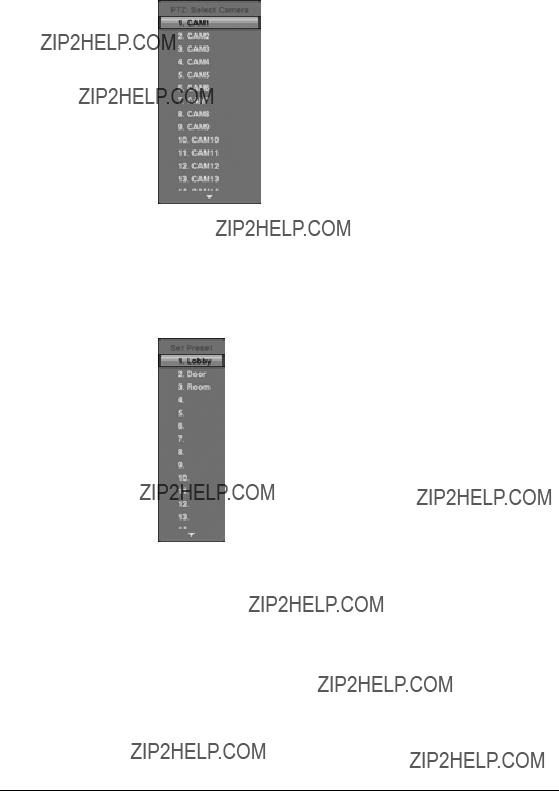
Operation
Figure
2.Use the front panel buttons to control the PTZ. Press the Left and Right arrow
buttons to pan left and right. Press the Up and Down arrow buttons to tilt the
camera up and down. Press  to zoom in, and press
to zoom in, and press  to zoom out. You can use
to zoom out. You can use  and
and  to focus the image.
to focus the image.
3.You can establish preset positions for PTZ cameras. Press  to establish Presets.
to establish Presets.
Figure
4.You can quickly move PTZ cameras to Preset positions. Press  to view an established camera Preset position.
to view an established camera Preset position.
98
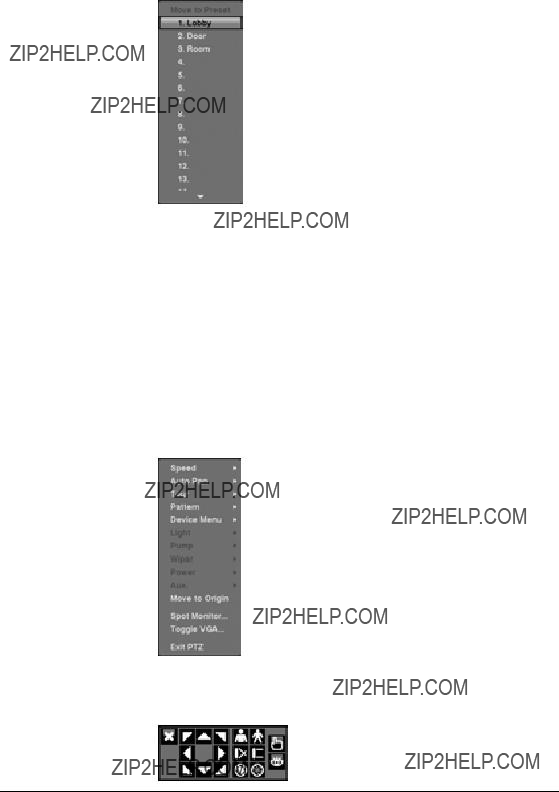
Operation
Figure
5.You can save camera position settings as presets so that you can go directly to desired views.
a.Once you have the camera at the desired settings, press  , and the PTZ Preset dialog box will appear.
, and the PTZ Preset dialog box will appear.
b.Select the number you want to assign to the preset and press 
 .
.
c.Use the virtual keyboard to enter the preset name.
d.Press  to load the PTZ preset and the Preset View dialog box will appear.
to load the PTZ preset and the Preset View dialog box will appear.
e.Select the desired preset and press 
 to load the preset.
to load the preset.
6.Pressing MENU displays the following PTZ menu. Set the feature you wish to control by selecting it from the menu. Refer to the camera manufacturer???s instructions for the proper settings. Depending on the camera specifications, some features may not be supported.
7.You can also use a mouse for convenient PTZ control. Position the mouse pointer at the bottom of the screen, and the following PTZ toolbar will display.
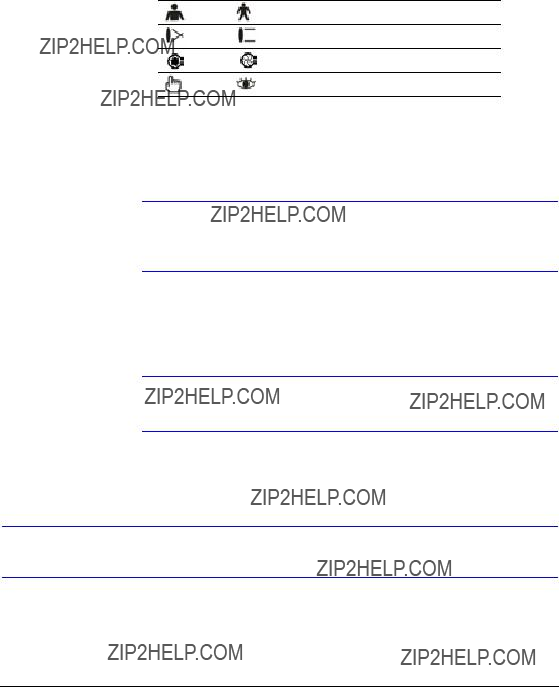
Operation
8.Clicking  on the left side closes the toolbar. If you want to display the toolbar again, position the mouse pointer at the bottom of the screen. Change the toolbar location by clicking the empty space on the left side of the toolbar and drag it to where you want it located on the screen. Use the arrow buttons on the toolbar to pan or tilt the camera in the direction you want. The other controls on the toolbar perform as described below:
on the left side closes the toolbar. If you want to display the toolbar again, position the mouse pointer at the bottom of the screen. Change the toolbar location by clicking the empty space on the left side of the toolbar and drag it to where you want it located on the screen. Use the arrow buttons on the toolbar to pan or tilt the camera in the direction you want. The other controls on the toolbar perform as described below:
Zoom In/Out
Focus Near/Far
Iris Open/Close
Set/Load Preset
Image Adjustment
Note It is important that cameras and monitors are correctly installed and adjusted prior to making any image adjustments using the DVR???s controls.
If a user who has Color Control authority logs in, the user can adjust the image. Pressing and holding a camera button for a few seconds displays an image adjustment dialog. You can control brightness, contrast, hue and saturation for each camera.
Note Any image adjustments you make will be applied to both the live video on the monitors and the recorded video.
Event Monitoring
When an event occurs, the DVR will display the camera associated with the event if Event Monitoring On is selected in the Display setup screen, OSD tab (see Display
100
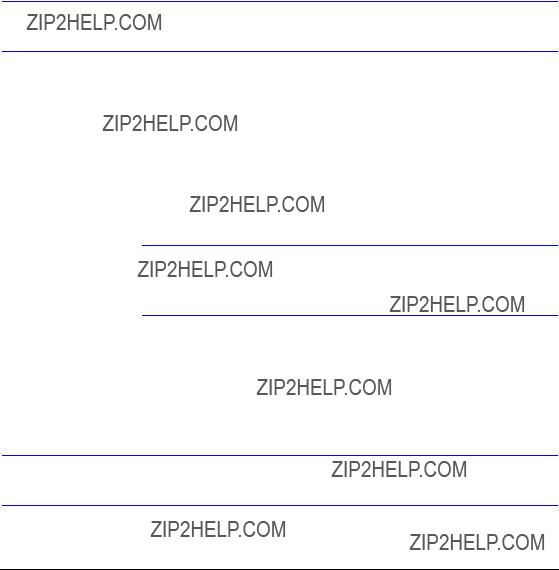
Operation
How the cameras are displayed depends on the number of cameras associated with the event. If one camera is associated with the event, the DVR will display the camera full screen. If two to four cameras are associated with the event, the DVR will display the cameras on a 2x2 screen. If five to nine cameras are associated with the event, the DVR will display the cameras on a 3x3 screen. If 10 or more cameras are associated with the event, the DVR will display the cameras on a 4x4 screen.
Event monitoring lasts for the dwell time set for event recording. After the dwell time has elapsed, the monitor returns to the previous screen unless another event has occurred. If you want to return to the live monitoring mode before the dwell time has elapsed, press DISPLAY or one of the camera buttons.
Covert Camera
If a camera is set up as Covert 1 in the Camera setup screen, Settings tab (see Camera Setup Screen, page 62), that camera will not be displayed unless a user with Covert Camera View authority logs into the system. However the camera title and status icons will be displayed on the monitor.
If a camera is set up as Covert 2 in the Camera setup screen, Settings tab (see Camera Setup Screen, page 62), that camera appears to be Off unless a user with Covert Camera View authority logs into the system. The camera title will be grayed out and status icons will not be displayed on the monitor.
Note When a camera is set up as Covert 1, the DVR displays the camera title and status icons on the covert video. When set up as Covert 2, the DVR displays only the camera title on the video.
If a user who has Covert Camera View authority logs in, the user can view video from cameras set to Covert 1 or Covert 2 including the camera titles and status icons.
Spot Monitoring
You can select the camera you want to display on a Spot Monitor:
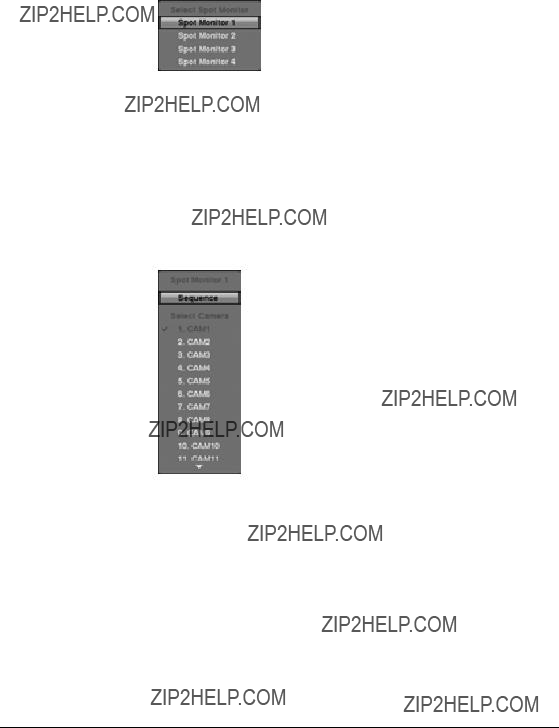
Operation
1.Press SPOT on the front panel or remote control, then select one of four Spot Monitors.
2.Select the camera to be displayed on the Spot Monitor.
Figure
If you want to display more than one camera on a Spot Monitor, you can display them sequentially:
1.In the Spot Monitor selection mode, press SEQUENCE on the front panel or remote control, or select Sequence On from the menu to start displaying cameras sequentially.
2.Press SEQUENCE or select Sequence On again to stop sequencing on the Spot Monitor.
Any cameras that are Off, have lost video or are set to Covert (unless the user has authority to view covert cameras) will be excluded from the sequence.
Figure
The Spot Monitor 1 supports
When the Spot Monitor is in the sequence mode, you can set the camera???s display dwell time. Refer to Display Screen on page 66 for details.
102
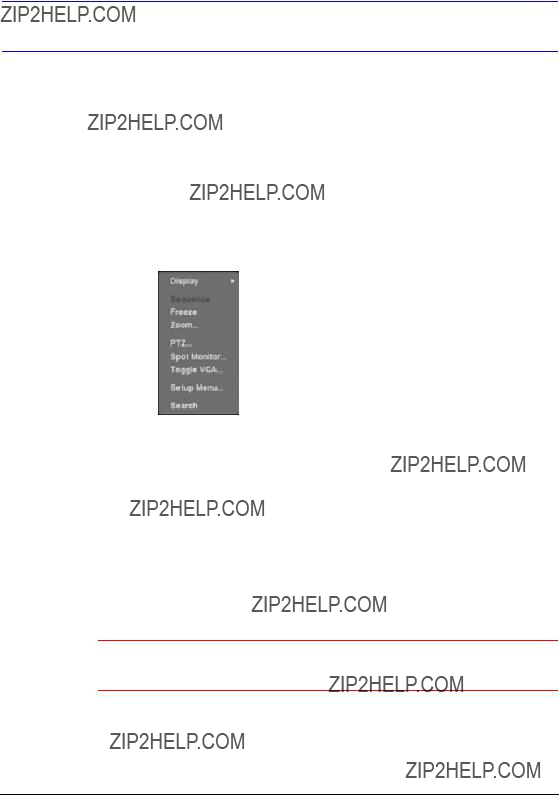
Operation
Using a Mouse
You can use a mouse instead of the front panel buttons to perform many of the DVR functions. The following operations are supported when using a mouse during live monitoring:
???When in one of the
???When in one of the
???Clicking the right mouse button during live monitoring displays Figure
???Selecting Freeze, PTZ??? and Spot Monitor??? is the same as pressing the FREEZE, PTZ and SPOT buttons as described in the Live Monitoring section of this chapter.
???Selecting Zoom??? zooms in on the live image. While in the zoom mode, there are two ways to move around the enlarged portion of the video. First, there is a PIP located in the
???Selecting Toggle VGA is the same as pressing and holding DISPLAY for more than five seconds. It switches the video output between Video Out (BNC or SVHS Out) and VGA Out. During clip copy, you cannot switch the output between Video Out and VGA Out.
Caution The DVR will NOT record video for about 3 seconds while switching the video output between Video Out and VGA Out.
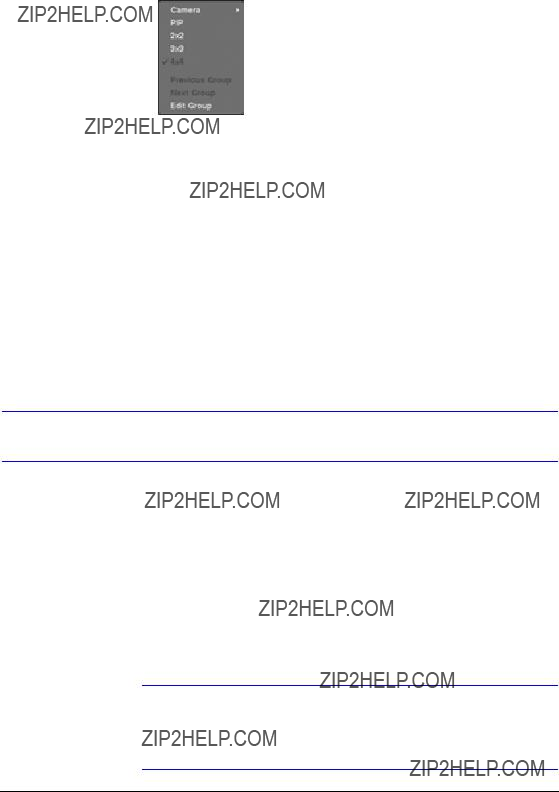
Operation
Figure
???Clicking Camera and selecting the camera number is the same as pressing the individual camera buttons on the front panel which displays the selected camera full screen. When in the PIP display mode, clicking the right mouse button and selecting PIP changes the location and the size of the PIP.
???Selecting PIP, 2x2, 3x3 and 4x4 displays the cameras in the selected
???Clicking Previous Group or Next Group is the same as pressing the Left or Right buttons on the front panel which moves to the previous or next page.
???Selecting Edit Group supports the active cameo function. Select Edit Group and choose a camera that you want to change the display position (for example, Camera A). Then, click the right mouse button to display the menu. If you select another camera in the menu (for example, Camera B), the screen displays Camera B instead of Camera A. When in the 4x4 format, Camera A and Camera B will switch positions.
Recording Video
Once you have installed the DVR following the instructions in Chapter 2, Installation, it is ready to record. The DVR will start recording based on the settings you made in the
Record setup screen (see Chapter 3, Configuration).
Recording can be set to Recycle On or Recycle Off. The factory default is Recycle On, which means the DVR records over the oldest video once the hard disk is full. Setting the DVR to Recycle Off causes it to stop recording once the hard disk is full.
Resolution can be set to Standard or High. The factory default resolution is Standard. When set to Standard, the DVR has a maximum recording speed of 240 ips. When set to High, the DVR has a maximum recording speed of 120 ips.
Note When the DVR is in the search mode, the maximum recording speed decreases by half. For example, in search mode, the DVR???s maximum recording speed decreases to 120 ips when set to Standard resolution.
104
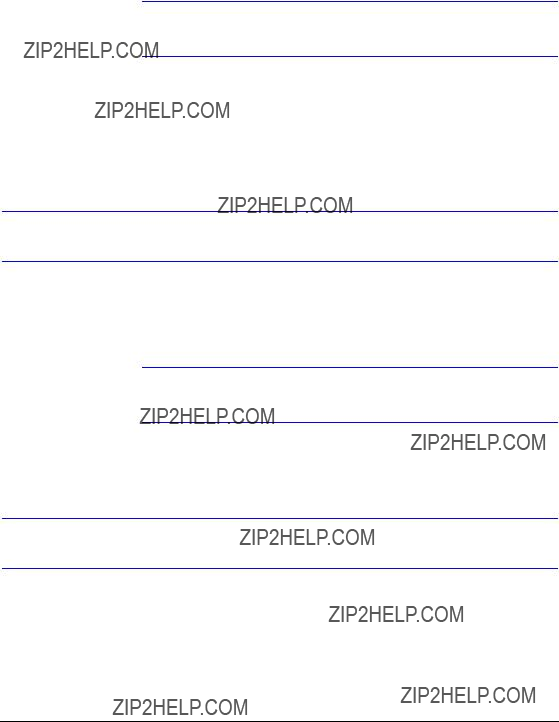
Operation
Pressing PANIC starts panic recording of all cameras, and pressing the button again stops panic recording. If you set the Panic Recording Duration in the Record Screen (see Record Screen, page 70), panic recording will stop automatically according to the preset duration as long as PANIC is not pressed.
Note When the DVR is not in Recycle mode and all available storage space has been used, panic recording will not operate.
Although you will be able to record without changing the unit from its original factory settings, you will want to take advantages of the DVR???s many tools. See Chapter 3, Configuration for detailed descriptions of the recording options.
Recording Audio
If the DVR was set up to record audio, it will record audio from up to four inputs when video is recording. The DVR will not record audio when the recording speed is set to less than 1 ips.
Note Make certain you comply with all local and federal laws and regulations when recording audio.
Playing Recorded Video
If a user who has Search authority logs into the system, the user can view recorded images. Once video has been recorded, you can view it by pressing PLAY/PAUSE. When playing video for the first time, the DVR will display the most recent image. When playing video subsequent times, the DVR will start playing video from the last recalled image. Recorded audio will be played when the DVR displays a camera with recorded audio in full screen mode.

Operation
Note While playing back video, the recording speed might decrease.
Note Only the administrator and users with Covert Camera View authority can view video from covert cameras. The covert cameras in the playback mode are determined by the current camera settings.
Pressing PLAY/PAUSE again will freeze the video on the screen.
RW (Rewind) Button
Pressing RW plays video backward at high speed. Pressing the button again toggles the playback speed between  ,
,  and
and  . The screen displays
. The screen displays  ,
,  and
and  respectively.
respectively.
Entering Fast Backward Playback mode from Live Monitoring mode can be password protected.
FF (Fast Forward) Button
Pressing FF plays video forward at high speed. Pressing the button again toggles the playback speed between  ,
,  and
and  . The screen displays
. The screen displays  ,
,  and
and  respectively.
respectively.
Entering Fast Playback mode from Live Monitoring mode can be password protected.
BACKWARD Button
Pressing BACKWARD goes to the previous image.
FORWARD Button
Pressing FORWARD goes to the next image.
106

Operation
SEARCH Button
Pressing SEARCH while in the Playback mode returns the DVR to the Live Monitoring mode. Pressing SEARCH while in the Live Monitoring mode returns the DVR to the Search mode.
Camera Buttons (1 to 16)
Pressing a camera button will display that camera full screen.
DISPLAY Button
Pressing DISPLAY will cycle the display through the different screen layouts. The display modes are: 4x4, PIP, 3x3 and 2x2 (not all formats are available for the
ZOOM Button
Pressing ZOOM zooms the current playback image on the screen.
Shuttle Ring
The Shuttle Ring only functions in Playback mode. The Shuttle Ring is spring loaded and returns to the center position when released. Turning the ring clockwise plays video forward. Turning the ring counterclockwise plays video backward. Playback speed varies with the amount the ring is turned. The playback speeds are  ,
,  ,
,  ,
,  x0.5,
x0.5,  ,
,  ,
,  and
and  .
.
When you release the ring, it snaps back to the center position and the video pauses.
Jog Dial
The Jog Dial only functions when playback video has been paused. By turning the jog dial clockwise, you can play video forward
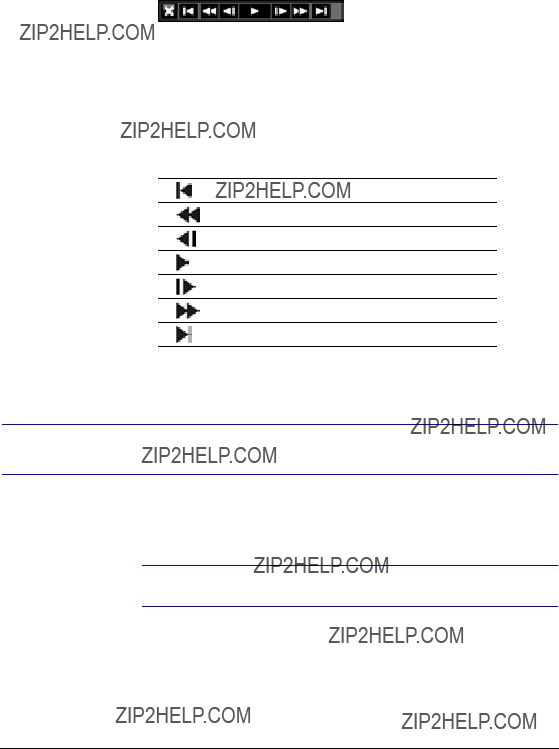
Operation
You can also use a mouse for convenient playback control. Position the mouse pointer on the search screen, and the following search toolbar will display.
Figure
Clicking  on the left side exits the toolbar. If you want to display the toolbar again, position the mouse pointer on the screen. Change the toolbar location by clicking the empty space on the right side of the toolbar and drag it to where you want it located on the screen.
on the left side exits the toolbar. If you want to display the toolbar again, position the mouse pointer on the screen. Change the toolbar location by clicking the empty space on the right side of the toolbar and drag it to where you want it located on the screen.
The individual controls on the toolbar perform the following functions as described below:
Table
Go to the first image
Fast backward play
Go to the previous image
Play
Go to the next image
Fast forward play
Go to the last image
Searching Video
Pressing MENU or clicking the right mouse button while in the Search mode displays the Search Menu (Figure
Note While searching video, the recording speed might decrease.
108

Operation
Figure
???Go to the First ??? Displays the first recorded image
???Go to the Last ??? Displays the last recorded image
???Go to the Date/Time??? ??? Searches by date and time (see below for more details)
???Calendar Search??? ??? Searches using a calendar (see below for more details)
???Event Log Search??? ??? Selects video from the event log (see below for more details)
???
???Motion Search??? ??? Searches motion events (see below for more details)
???
???Print??? ??? Allows you to print a selected image (see below for more details)
???Zoom??? ??? Zooms the current playback image
???Slow Play??? ??? Plays video at low speed (x1/2, x1/3, x1/4, x1/6 and x1/8)
???Data Source ??? Allows you to choose between recorded and archived video
???Exit Search ??? Exits the Search Menu
Note The searching speed might decrease when all camera channels are in the
Go to the Date/Time
Figure
1.Move the cursor over the date and time and press 
 .
.
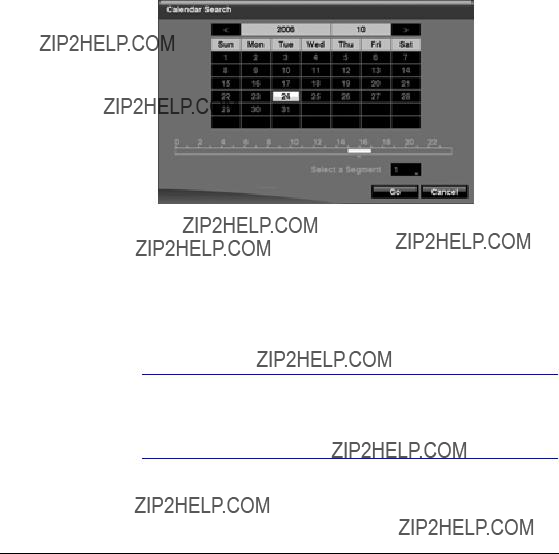
Operation
2.You can use the Left and Right arrow buttons to highlight the year, month, day, hours, minutes and seconds. Use the Up and Down arrow buttons to change to the date and time you want to search for video.
3.Once you have set the date and time you want, press 
 . Then highlight Go and press
. Then highlight Go and press 
 .
.
4.Video from the selected date and time will display (if no video was recorded during the selected time, a message appears alerting you that no image was recorded at that time). The PLAY/PAUSE, RW, FF, Jog Dial and Shuttle Ring can now be used to review the surrounding video.
Calendar Search
Figure
1.Days with recorded video display on the calendar with white numbers. You can highlight the days with recorded video by using the arrow buttons. Once you have highlighted a day, press 
 to select it.
to select it.
2.A time bar displays at the bottom of the calendar. Hours in which video was recorded will be highlighted with blue. Use the Up and Down arrow buttons to highlight the time bar.
3.Once the time bar is highlighted, select the time by using the Left and Right arrow buttons.
Note The time bar is in
110

Operation
4.If the DVR???s time and date have been reset to a time that is earlier than some recorded video, it is possible for the DVR to have more than one video stream in the same time range. Move to Select a Segment, and select the video stream you want to search. Refer to Appendix E, Time Overlap for further information on searching
Note The lower number of the Segment indicates the latest recorded video.
5.Once you have set the date and time you want to search, highlight GO and press

 . Video from the selected date and time will display. The PLAY/PAUSE, RW, FF, Jog Dial and Shuttle Ring can now be used to review the surrounding video.
. Video from the selected date and time will display. The PLAY/PAUSE, RW, FF, Jog Dial and Shuttle Ring can now be used to review the surrounding video.
Note It is possible that no recorded image displays on the current screen. Press DISPLAY and change the screen mode to 4x4. You will be able to easily see which camera(s) have recorded video during the target time.
Event Log Search
Figure
The DVR maintains a log of each time the Alarm Input port is activated. The Event Log Search screen displays this list.
The Event Log Search screen can also be accessed by pressing ALARM unless there is an alarm. There is no determined user authority to display the Event Log Search screen, however, the event video will not be played unless a user with Search authority logs into the system.
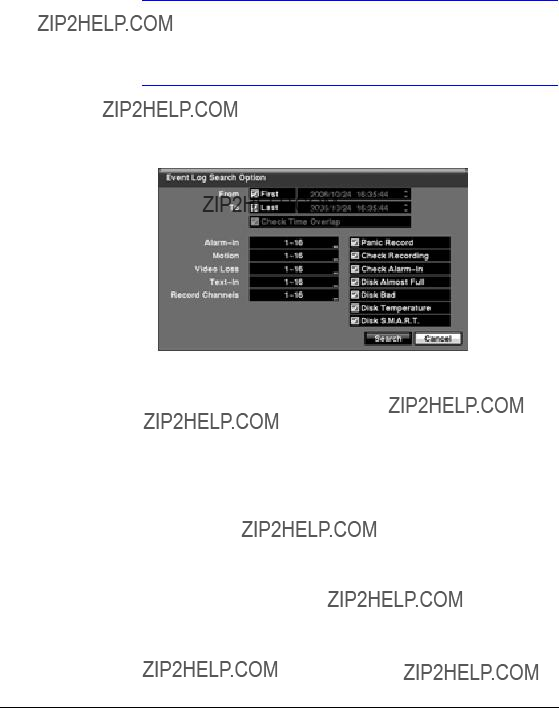
Operation
1.Use the arrow buttons to highlight the event for which you would like to see video.
2.Pressing 
 will extract the event video and display the first image of the event.
will extract the event video and display the first image of the event.
3.Pressing PLAY/PAUSE will start playing the event video segment. Pressing SEARCH returns to live monitoring.
Note It is possible that no recorded image displays on the current screen. Press DISPLAY and change the screen mode to 4x4. You will be able to easily see which camera(s) have recorded video during the target time.
4.You can also narrow your event search by selecting Option??? and setting up a new search condition.
Figure
You can search video from the first to last recorded images, or you can set the start and stop times and dates.
a.Highlight the box beside From and press 
 to toggle between On and Off. When set to Off, you can enter a specific Date and Time. When set to On, the search will be from the first recorded image.
to toggle between On and Off. When set to Off, you can enter a specific Date and Time. When set to On, the search will be from the first recorded image.
b.Highlight the box beside To and press 
 to toggle between On and Off. When set to Off, you can enter a specific Date and Time. When set to On, the search will be from the last recorded image.
to toggle between On and Off. When set to Off, you can enter a specific Date and Time. When set to On, the search will be from the last recorded image.
c.Highlight the box beside Check Time Overlap and press 
 . It toggles between On and Off. You will only be able to turn the Check Time Overlap on or off if a
. It toggles between On and Off. You will only be able to turn the Check Time Overlap on or off if a
d.Highlight the box beside 
 . You can select the alarm inputs that you want to include in your search.
. You can select the alarm inputs that you want to include in your search.
e.Highlight the box beside Motion and press 
 . You can select the cameras for which you want to search for any reports of motion detection.
. You can select the cameras for which you want to search for any reports of motion detection.
112
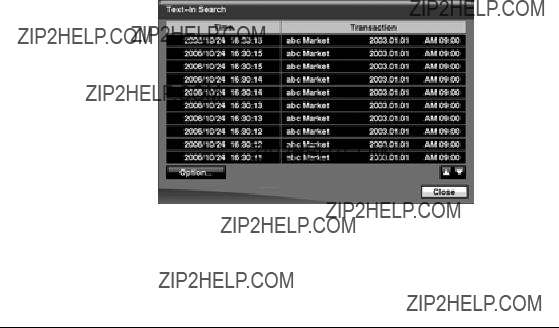
Operation
f.Highlight the box beside Video Loss and press 
 . You can select the cameras for which you want to search for any reports of lost video.
. You can select the cameras for which you want to search for any reports of lost video.
g.Highlight the box beside 
 . You can select the
. You can select the
h.Highlight the box beside Record Channels and press 
 . You can select the cameras that you want to search for any reports of event recorded data. The DVR will display the events (not the camera channels) that occurred and that also are recorded on the camera channel that you selected. If you do not select a camera channel in this field, the DVR will search events that are not associated with cameras.
. You can select the cameras that you want to search for any reports of event recorded data. The DVR will display the events (not the camera channels) that occurred and that also are recorded on the camera channel that you selected. If you do not select a camera channel in this field, the DVR will search events that are not associated with cameras.
i.You can also toggle On and Off
???Panic Record
???Check Recording
???Check
???Disk Almost Full
???Disk Bad
???Disk Temperature
???Disk S.M.A.R.T.
5.Once you set your desired search conditions, highlight Search and press 
 to display the search results in the Event Log Search screen. Selecting Cancel exits the screen without saving the changes.
to display the search results in the Event Log Search screen. Selecting Cancel exits the screen without saving the changes.
Figure
The DVR maintains a log of each time there is Text Input. The
1.Use the arrow buttons to highlight the event for which you would like to see video.
2.Pressing 
 will extract the video associated with the Text Input and display the first image of the event.
will extract the video associated with the Text Input and display the first image of the event.
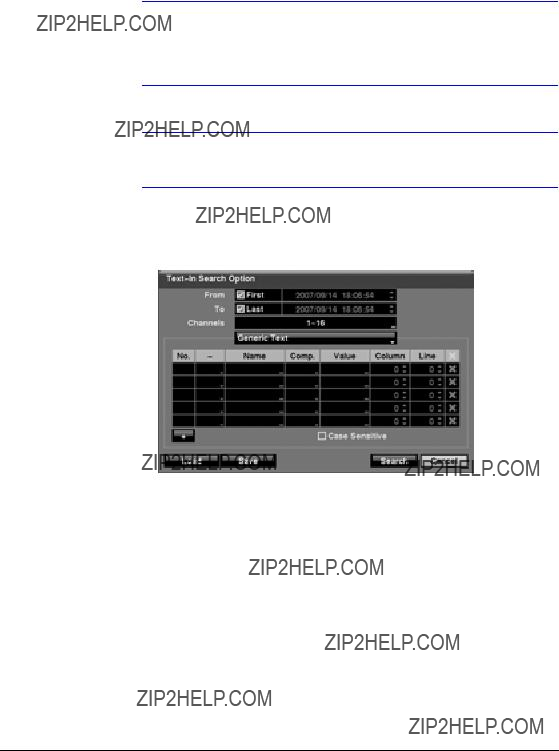
Operation
3.Pressing PLAY/PAUSE will start playing the event video segment. Pressing SEARCH returns to live monitoring.
Note It is possible that no recorded image displays on the current screen. Press DISPLAY and change the screen mode to 4x4. You will be able to easily see which camera(s) have recorded video during the target time.
Note Text Input information will be overlaid on the image while the recorded video is played at regular speed.
4.You can also narrow your event search by selecting Option??? and setting up a new search condition.
Figure
You can search video from the first to last recorded images, or you can set the start and stop times and dates.
a.Highlight the box beside From and press 
 to toggle between On and Off. When set to Off, you can enter a specific Date and Time. When set to On, the search will be from the first recorded image.
to toggle between On and Off. When set to Off, you can enter a specific Date and Time. When set to On, the search will be from the first recorded image.
b.Highlight the box beside To and press 
 to toggle between On and Off. When set to Off, you can enter a specific Date and Time. When set to On, the search will be from the last recorded image.
to toggle between On and Off. When set to Off, you can enter a specific Date and Time. When set to On, the search will be from the last recorded image.
c.Highlight the Channel and press 
 . Select the
. Select the
d.Highlight the Text Input Device box and press 
 . Select your Text Input Device from the list.
. Select your Text Input Device from the list.
114
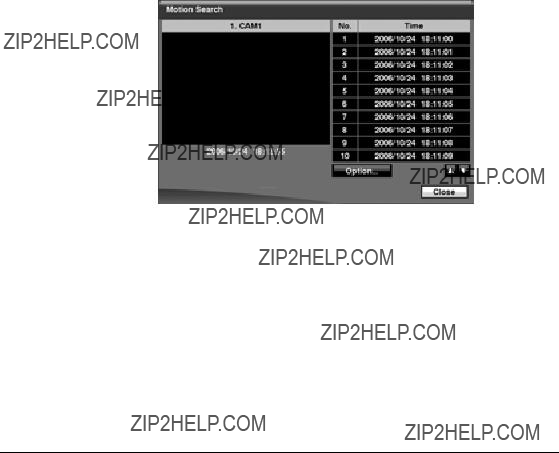
Operation
e.Highlighting + and pressing 
 allows you to add a new search parameter. Set up the desired search parameter. Refer to Appendix B, Text In Search Examples for more information on setting up search parameters. The
allows you to add a new search parameter. Set up the desired search parameter. Refer to Appendix B, Text In Search Examples for more information on setting up search parameters. The  column can be used to delete a single search parameter or all of the search parameters.
column can be used to delete a single search parameter or all of the search parameters.
f.Highlight Case Sensitive and press 
 . This will toggle between On and Off. When this feature is On, the search will find only those text strings in which the case matches.
. This will toggle between On and Off. When this feature is On, the search will find only those text strings in which the case matches.
g.Highlight Load and press 
 to load saved search option settings. Select the desired search option setting.
to load saved search option settings. Select the desired search option setting.
h.Highlight Save and press 
 to save the current search option settings. Use the virtual keyboard that appears to enter the search option name.
to save the current search option settings. Use the virtual keyboard that appears to enter the search option name.
5.Once you set your desired search conditions, highlight Search and press 
 to display the search results in the
to display the search results in the
Motion Search
Figure
1.The Motion Search??? can be selected from the Search menu while the DVR displays the camera full screen. The Motion Search screen displays a list of motion events.
2.Use the arrow buttons to highlight the event for which you would like to see video
and press 
 to display the video associated with the selected event on the small search screen.
to display the video associated with the selected event on the small search screen.
3.Highlighting Close and pressing 
 will extract the video associated with the Motion event and display the first image of the event.
will extract the video associated with the Motion event and display the first image of the event.
4.Pressing PLAY/PAUSE will start playing the event video segment. Pressing SEARCH returns to live monitoring.
5.You can also narrow your event search by selecting Option??? and setting up a new search condition.
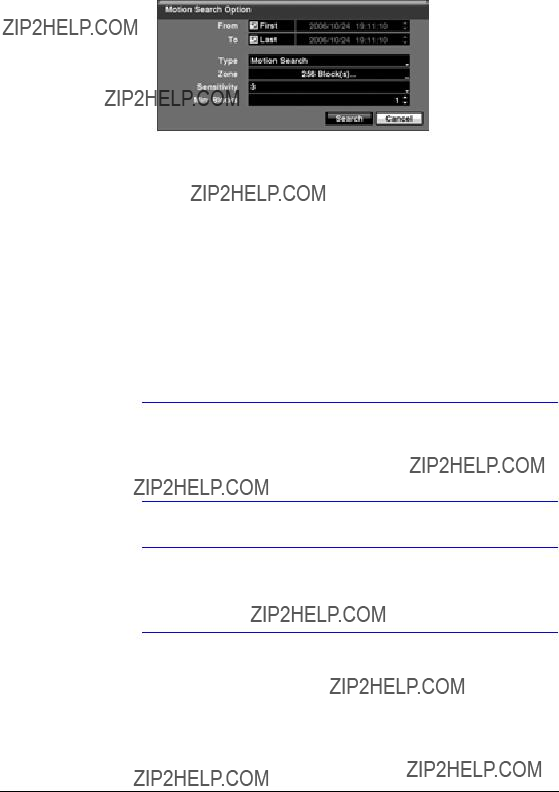
Operation
Figure
You can search video from the first to last recorded images, or you can set the start and stop times and dates.
a.Highlight the box beside From and press 
 to toggle between On and Off. When set to Off, you can enter a specific Date and Time. When set to On, the search will be from the first recorded image.
to toggle between On and Off. When set to Off, you can enter a specific Date and Time. When set to On, the search will be from the first recorded image.
b.Highlight the box beside To and press 
 to toggle between On and Off. When set to Off, you can enter a specific Date and Time. When set to On, the search will be from the last recorded image.
to toggle between On and Off. When set to Off, you can enter a specific Date and Time. When set to On, the search will be from the last recorded image.
c.Highlight the box beside Type and press 
 . You can select between Motion Search and Museum Search. Motion Search detects motion in the defined area. Museum Search detects if a defined object has moved.
. You can select between Motion Search and Museum Search. Motion Search detects motion in the defined area. Museum Search detects if a defined object has moved.
d.Highlight the box beside Zone and press 
 . An image from the video appears with a grid overlaid. You can turn sensor blocks On and Off to define the area of the picture in which you want to search for motion.
. An image from the video appears with a grid overlaid. You can turn sensor blocks On and Off to define the area of the picture in which you want to search for motion.
Note Defining the area of the image in which you want to search for motion is nearly identical to setting up the DVR for Motion Detection. Please refer to Motion Detection Screen in Chapter 3, Configuration for more detailed instructions on setting up the detection blocks.
Note When setting the Museum Search Zone, the zone should be placed inside of the border line of the target object. If the selected block is placed on the border line, the sensitivity of the Museum Search may decrease.
e.For Museum searching, the zone should be placed or focused on the center or, at least, within the outline of targeted object.
f.Highlight the box beside Sensitivity and press 
 . You will be able to select from 1 (low sensitivity) to 5 (high sensitivity).
. You will be able to select from 1 (low sensitivity) to 5 (high sensitivity).
g.Highlight the box beside Min. Blocks and press 
 . You will be able to set the number of sensor blocks that must be activated for motion to be detected. Setting the Min Blocks is only available if Motion Search is selected.
. You will be able to set the number of sensor blocks that must be activated for motion to be detected. Setting the Min Blocks is only available if Motion Search is selected.
116
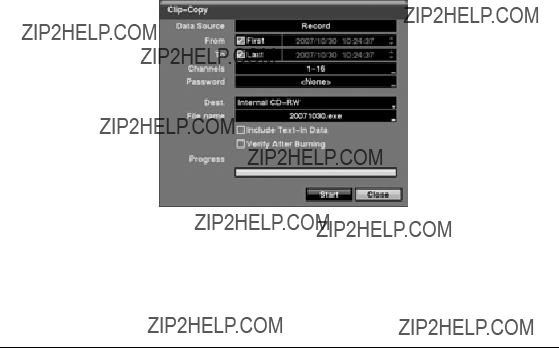
Operation
6.Once you set your desired search conditions, highlight Search and press 
 to display the search results in the Motion Search screen. Selecting Cancel exits the screen without saving the changes.
to display the search results in the Motion Search screen. Selecting Cancel exits the screen without saving the changes.
When you search for motion events of another camera, you will be asked whether or not you want to delete the previous search results from the list.
The
Appendix A, USB Hard Disk Drive Preparation for information on preparing the external drive for clips. The clip copy can be simply done by pressing MENU or FREEZE.
1.Press and hold MENU for more than two seconds while in the Search mode, and the
2.Pressing FREEZE during the playback will set the starting point of the video to be clip copied, and  displays at the
displays at the
3.Pressing FREEZE again will set the ending point of the video to be clip copied by displaying the
4.Pressing and holding FREEZE for more than two seconds while in Search mode or Live Monitoring mode initiates the
Figure
5.The Data Source box displays the source from which you make a video clip copy. The data source can be selected from Record or Archive in the Search menu.

Operation
6.You can search video from the first to last recorded images, or you can set the start and stop times and dates:
???Highlight the box beside From and press 
 to toggle between On and Off. When set to Off, you can enter a specific Date and Time. When set to On, the search will be from the first recorded image.
to toggle between On and Off. When set to Off, you can enter a specific Date and Time. When set to On, the search will be from the first recorded image.
???Highlight the box beside To and press 
 to toggle between On and Off. When set to Off, you can enter a specific Date and Time. When set to On, the search will be from the last recorded image.
to toggle between On and Off. When set to Off, you can enter a specific Date and Time. When set to On, the search will be from the last recorded image.
7.Highlight the box beside Channels and press 
 . You can select the cameras that you would like to include in your video clip.
. You can select the cameras that you would like to include in your video clip.
8.Highlight the box beside Password and press 
 . A virtual keyboard appears allowing you to enter a password for reviewing the video clips.
. A virtual keyboard appears allowing you to enter a password for reviewing the video clips.
9.Highlight the box beside Dest. and press 
 . You can select the storage device on which you would like to record the video clip. You can choose from Internal
. You can select the storage device on which you would like to record the video clip. You can choose from Internal
Caution The USB device for clip copy must be FAT16 or FAT32 format.
Note While copying video clips to the
Note While copying video clips to the
Note When the error message Firmware update of the optical drive is required displays, update the firmware
of the installed
10.The DVR automatically assigns a file name to the video clip. However, you can give the video clip file a different name. Highlight the box beside File Name and
press 
 . A virtual keyboard appears. Enter a file name for the video you are backing up and select Close. The DVR will automatically add the camera number (for example, 01) and .exe to the file name. If you want to save the file in a specific folder, enter the folder name followed by a ???/???. For example: ???folder/filename???.
. A virtual keyboard appears. Enter a file name for the video you are backing up and select Close. The DVR will automatically add the camera number (for example, 01) and .exe to the file name. If you want to save the file in a specific folder, enter the folder name followed by a ???/???. For example: ???folder/filename???.
118

Operation
Note When naming a file, you cannot use the following characters: \, /,
:, *, ?, ", <, >, |.
11.Highlight Include 
 . This will toggle between On and Off. When this feature is On, you can include
. This will toggle between On and Off. When this feature is On, you can include
12.Highlight Verify After Burning and press 
 . This will toggle between On and Off. When this feature is on, you can verify that the data is written on the
. This will toggle between On and Off. When this feature is on, you can verify that the data is written on the
13.Once you have given the video clip a file name, highlight Start and press 
 . The confirmation screen displaying data size will appear. When the storage device does not have enough space, the DVR will ask if you want to copy as much of the
. The confirmation screen displaying data size will appear. When the storage device does not have enough space, the DVR will ask if you want to copy as much of the
video clip as possible in the available space. Highlight Continue and press 
 to continue clip copy.
to continue clip copy.
14.Once the clip copy starts, you can cancel it by selecting Cancel or hide the screen by selecting Close. When selecting Close, Clip Copy continues and a confirmation screen will display when it is complete.
Note Only 4.7GB DVD media is available. To clip copy video on the DVD media using remaining space, the size of previously recorded data on the DVD media should be less than 4GB.
Note The file size for clip copy is limited to 2GB.
15.You can use other functions on the DVR while video is being backed up. To do
this, highlight Close and press 
 . You can return to the
. You can return to the
Refer to Appendix C, Reviewing Video Clips for instructions on how to review video clips you have copied.
Note During Clip Copy, you cannot shut the system down, clear data on the storage device, or format the storage device.
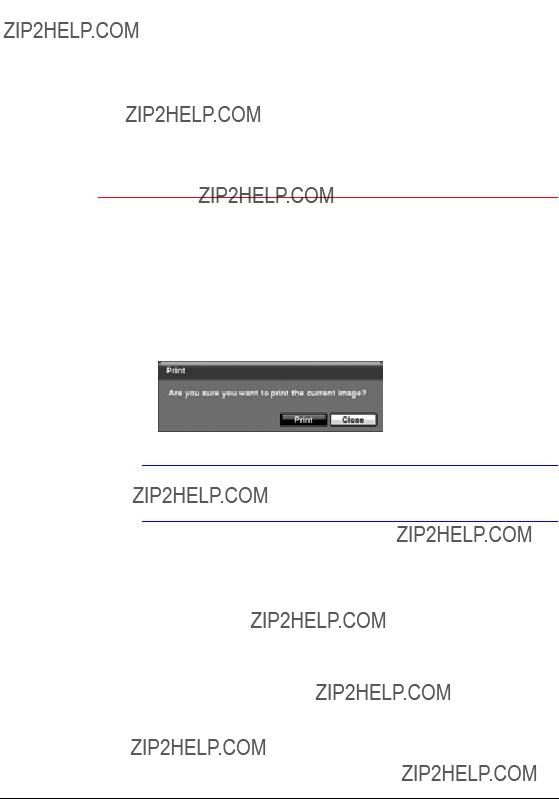
Operation
Caution Do NOT disconnect the USB cable or the power from the external drive while copying video clips. If the external drive is shut down or the USB cable is disconnected while copying video clips, THE
DVR SYSTEM MAY NOT WORK NORMALLY OR THE EXTERNAL DRIVE COULD BE DAMAGED, and you will get an error message the next time you try to copy video clips. You will need to power down the DVR and restart it to get rid of the error message. Once the file system of the
Print Screen
You can print images from the screen. Connect a PostScript??? printer to one of the USB ports. A message appears asking you if you want to print the current image.
Figure
Note If your printer only supports an LPT connection (parallel), use an
LPT to USB converter cable. The printer cable is not provided.
120

USB Hard Disk Drive Preparation
A
USB Hard Disk Drive Preparation
Preparing the
Note Preparing a
1.Connect the
2.Turn on your computer.
3.The USB device icon should display on the Taskbar.
4.If the
5.If the
Control Panel and launch Computer Management. Open Disk Management in
Storage and
6.In the Create Partition wizard, click Next then Primary Partition, and follow the instructions on the screen. Make sure that the FAT32 is selected for the file system.
Note The partition size should be less than 32GB because of Microsoft limitations.
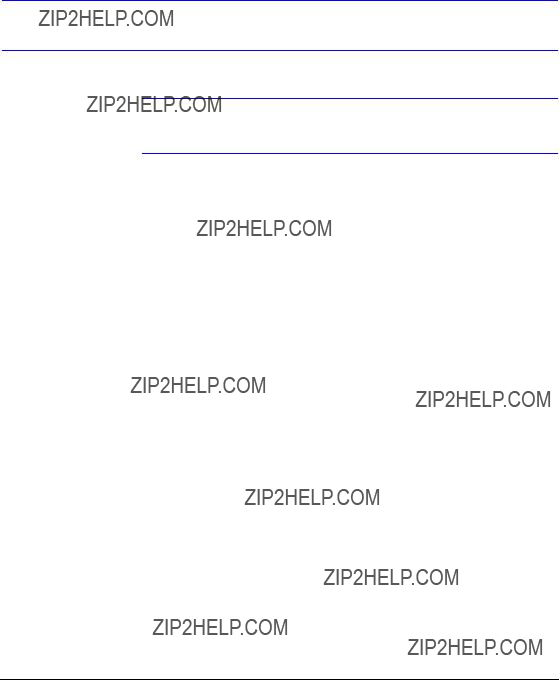
USB Hard Disk Drive Preparation
After formatting is complete, the
Computer.
7.Connect the
Preparing the
Note Preparing a
1.Connect the
2.Turn on your computer. The Add New Hardware wizard window will appear.
3.Install the device driver for the USB backup device following the instructions provided with your USB hard disk drive.
4.If the
5.Run the FDISK utility by clicking Start then RUN. Type fdisk and click OK.
6.When the
7.In the FDISK Option menu, choose 5. Change current fixed disk drive.
8.Choose the appropriate letter corresponding to the
9.In the FDISK Option menu, choose 1. Create DOS partition or Logical DOS Drive.
10.In the Create DOS Partition or Logical DOS Drive menu, choose 1. Create Primary DOS Partition. Type Y to use all available space and press the enter key. Press ESC to exit the screen after the
11.Restart your computer and verify the newly created drive is in My Computer.
12.
13.In the Format Screen, select Full as the Format type and click Start.
14.After formatting is complete, connect the
122
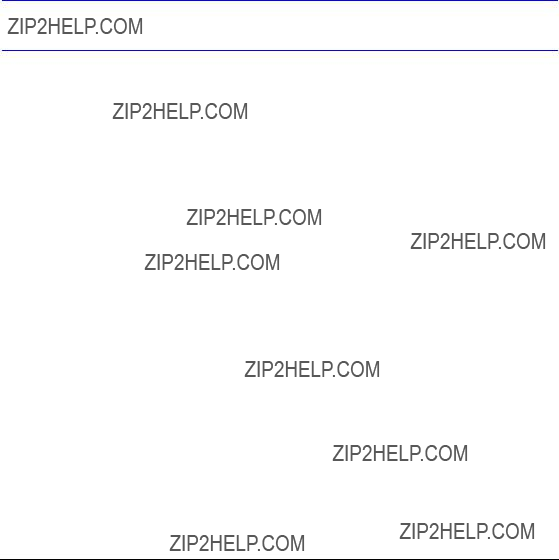
Text In Search Examples
B
Text In Search Examples
Search Example 1
1 2 3 4 5 6
123456789012345678901234567890123456789012345678901234567890
Thank you~~
In the above
Column box.
For example, if you want to search for Coke with a Qty (Quantity) of more than 1 and Hotdog with an amount totaling over $8, the following search condition can be set.
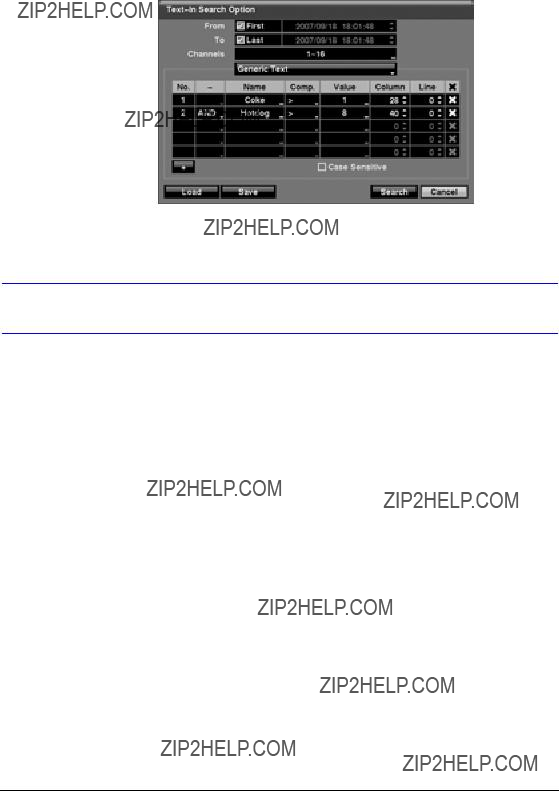
Text In Search Examples
Figure
Search Example 2
1 2 3 4 5 6
123456789012345678901234567890123456789012345678901234567890
Thank you~~
In the above
For example, if you want to search for Coke with a Qty (Quantity) of more than 1 and Hotdog with an amount totaling over $8, the following search condition can be set.
124

Text In Search Examples
Figure

Text In Search Examples
126

Reviewing Video Clips
C
Reviewing Video Clips
You do not need to install any special software on your personal computer to review the video clips. The copied video clip contains the Clip Player program.
1.If you used a USB device, disconnect either the external
2.
Note It is suggested that the computer used for the Clip Player program has at least an 800MHz Pentium III. If your CPU is slower than this, video clips recorded at maximum speed with very high image quality will be played back slowly. Also DirectX 8.0 or higher is required to run Clip Player, and a VGA card with 16MB or more video RAM is recommended for proper operation.
Figure

Reviewing Video Clips
3.The Clip Player Screen displays the clip images. Use the player controls to review the clip.
Note Proper image display depends on the display settings of your PC. If you are experiencing display problems, click the right mouse button on the background screen and select Properties > Settings then set the Color quality to 32 bit. Then select Advanced > Troubleshoot and set Hardware Acceleration to
Full. Please make sure that DirectX version 8.0 or higher has been installed if the display problem continues to occur. To check the version of DirectX, click Start > RUN and type dxdiag and press the enter key. The DirectX Diagnostic Tool dialog box will display. Then move to the Display tab and make sure
DirectDraw Acceleration is set to Enabled. Test the DirectDraw by selecting the DirectDraw Test button. After changing the settings, update the driver version of the VGA card. If you still have display problems after changing all display settings as described above, try replacing the video card. Video cards with an ATI chipset are recommended.
???Clicking  exits the Player program.
exits the Player program.
???Click  to go to the beginning of the video clip.
to go to the beginning of the video clip.
???Click  to play the video clip in fast reverse.
to play the video clip in fast reverse.
???Click  to go back one frame of the video clip.
to go back one frame of the video clip.
???Click  to play the video clip.
to play the video clip.
???Click  to go forward one frame of the video clip.
to go forward one frame of the video clip.
???Click  to play the video clip in fast forward.
to play the video clip in fast forward.
???Click  to go to the end of the video clip.
to go to the end of the video clip.
???Click  to show the previous page.
to show the previous page.
???Click  to cycle through the screen layouts (2x2, 3x3 and 4x4).
to cycle through the screen layouts (2x2, 3x3 and 4x4).
???Click  to show the next page.
to show the next page.
???Click  to select from Save, Print, Info, Image Processing, Video Format and Show Text In. Selecting Save saves the current image in a bitmap file format on the local hard disk drive or floppy disk. Selecting Print lets you print the current image on the printer connected to your computer. Selecting Info displays Channel, Title, Time, Type, Size and Resolution information about the image. Selecting Image Processing allows you to control brightness, blur and sharpen for playback images. Selecting Video Format allows you to find appropriate display environments that can be varied depending on the type of graphics card installed in your PC. Use Video Format option when you are experiencing improper image display. Selecting Show Text In displays video with
to select from Save, Print, Info, Image Processing, Video Format and Show Text In. Selecting Save saves the current image in a bitmap file format on the local hard disk drive or floppy disk. Selecting Print lets you print the current image on the printer connected to your computer. Selecting Info displays Channel, Title, Time, Type, Size and Resolution information about the image. Selecting Image Processing allows you to control brightness, blur and sharpen for playback images. Selecting Video Format allows you to find appropriate display environments that can be varied depending on the type of graphics card installed in your PC. Use Video Format option when you are experiencing improper image display. Selecting Show Text In displays video with
128

Reviewing Video Clips
Note If you are not sure about the appropriate Video Format option, try each option until the image displays properly.
???Click  to select from Normal and Double screen views. Clicking the left mouse button on the enlarged image moves its position.
to select from Normal and Double screen views. Clicking the left mouse button on the enlarged image moves its position.
???Click  to display the image full screen.
to display the image full screen.
???Encryption icons display in the  indicates the clip file has not been tampered with, and
indicates the clip file has not been tampered with, and  indicates the system has detected tampering.
indicates the system has detected tampering.
Note If the VGA card or monitor for your PC does not support 640x480 video resolution, Full Screen might not display properly when selected. If this happens, press ESC on your PC to return to the normal screen mode.
???Click the slider bar and move it left or right to move through the video clip.
???Placing the mouse cursor on an image and clicking it will cause that image to display full frame.

Reviewing Video Clips
130

WebGuard
D
WebGuard
WebGuard allows you to access a remote DVR, monitor live video images and search recorded video using Internet Explorer web browser anytime from virtually anywhere.
Computer system requirements for using the WebGuard program are:
???Operating System: Microsoft?? Windows?? 2000, Microsoft Windows XP or Microsoft Windows Vista
???CPU: Intel Pentium III (Celeron) 600MHz or faster
???RAM: 128MB or higher
???VGA: 8MB or higher (1024 x 768, 24bpp or higher)
???Internet Explorer: Version 6.0 or later
1.Start Internet Explorer on your local PC. You can run the WebGuard program by entering the following information in the address field:
Http://IP address:port number. The DVR IP address and the WebGuard port number set in the Network setup screen (WebGuard tab).
OR
Http://DVRNS server address/DVR name. The DVRNS server address and the DVR name registered on the DVRNS server.
Note You will need to get the appropriate IP address for the DVR you want to connect to and the WebGuard port number from your network administrator.
Note WebGuard only works with Microsoft Internet Explorer and will
NOT work with Netscape.

WebGuard
Note When running WebGuard in the Microsoft Windows Vista operating system, it is recommended to start Internet Explorer with elevated administrator permissions. Click the right mouse button on the Internet Explorer icon and select the Run as administrator option from the context menu. Otherwise, some functions of WebGuard might be limited to use.
Figure
2.Select between the WATCH (Web monitoring) and SEARCH (Web search) modes and enter the appropriate port number of the program.
3.Entering ID and PASSWORD and clicking the [LOGIN] button logs in using the selected mode.
4.Selecting Save ID saves the ID you entered.
Note The port numbers for WATCH and SEARCH should be the same as the port numbers for Remote Watch and Remote Search set during Network setup.
Note When running the updated WebGuard for the first time, Internet Explorer might occasionally load the information of the previous version. In this case, delete the temporary internet files by selecting Tools > Internet Options > General tab, and then run WebGuard again.
132

WebGuard
Web Monitoring Mode
WebWatch is a remote web monitoring program that allows you to monitor live video transmitted in
Figure
1.Click  to log out of the WebGuard program.
to log out of the WebGuard program.
2.Click  to access the web search mode.
to access the web search mode.
3.Position the mouse pointer on the WebWatch logo to see the version of the WebGuard program.
4.The DVR information window displays the login information of WebGuard.
5.Click the screen format to select the desired display mode. When changing the screen format, and selected camera on the current screen will be located in the first cell of the new layout.
6.Click the camera button (1 to 16) to select the camera to be viewed.

WebGuard
7.Click  to adjust the brightness, contrast, saturation and hue of the monitoring image.
to adjust the brightness, contrast, saturation and hue of the monitoring image.
8.Click  to control pan, tilt, and zoom of a PTZ camera from a remote site.
to control pan, tilt, and zoom of a PTZ camera from a remote site.
9.Click  to control alarm out devices at the remote site.
to control alarm out devices at the remote site.
10.Click  to save the current image as a bitmap or JPEG file format.
to save the current image as a bitmap or JPEG file format.
11.Click  to set up the image drawing mode and OSD display. You can adjust the display speed by changing the image drawing mode, and select the OSD information to display on the screen.
to set up the image drawing mode and OSD display. You can adjust the display speed by changing the image drawing mode, and select the OSD information to display on the screen.
12.The event status window at the bottom displays a list of events that were detected from the remote site.
13.Selecting a camera on the screen and clicking the right mouse button displays the text menu screen.
???Change Camera Title: Changes the camera name.
???Aspect Ratio: Changes the image aspect ratio.
???
Note The camera name changed in the Web Watch mode does not affect name set up on the remote site. Leaving the Camera Title blank causes the camera name set up on the remote site to dispay.
134
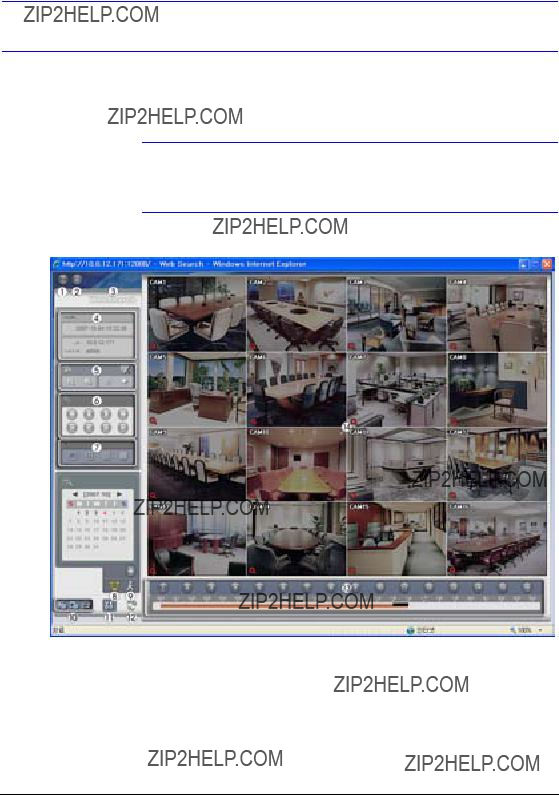
WebGuard
Web Search Mode
WebSearch is a remote web search program that allows you to search recorded video on the remote DVR.
Note The remote site connection in the Web Search mode will automatically be disconnected if there is no activity for 30 minutes.
Figure
1.Click  to log out of the WebGuard program.
to log out of the WebGuard program.
2.Click  to access to the web monitoring mode.
to access to the web monitoring mode.
3.Position the mouse pointer on the WebSearch logo to see the version of the WebGuard program.
4.The DVR information window displays the time information of recorded data on the remote DVR and login information of WebGuard.

WebGuard
5.Click  to blur, sharpen, equalize and interpolate playback images. Click
to blur, sharpen, equalize and interpolate playback images. Click
 to zoom out or zoom in on the recorded image. Click
to zoom out or zoom in on the recorded image. Click  to adjust the brightness of the recorded images.
to adjust the brightness of the recorded images.
Note Image processing works only in the pause mode.
6.The playback function buttons include fast backward, pause, play, fast forward, go to the first image, go to the previous image, go to the next image, and go to the last image.
7.Click the screen format to select the desired display mode.
8.Click  to enter the
to enter the  allows you to display an image from a specific time.
allows you to display an image from a specific time.
9.Click  to enter the event search mode which allows you to search for event log entries using specific conditions and play back the images associated with those event entries.
to enter the event search mode which allows you to search for event log entries using specific conditions and play back the images associated with those event entries.
10.Click  to save any video clip of recorded data as an executable file, or click
to save any video clip of recorded data as an executable file, or click  to save the current image in a bitmap or JPEG file format. Click
to save the current image in a bitmap or JPEG file format. Click  to print the current image on a printer connected to your computer.
to print the current image on a printer connected to your computer.
11.Click  to set up the image drawing mode and OSD display. You can adjust the display speed by changing the image drawing mode, and select the OSD information to display on the screen.
to set up the image drawing mode and OSD display. You can adjust the display speed by changing the image drawing mode, and select the OSD information to display on the screen.
12.Click  to reload the recording data.
to reload the recording data.
13.The timetable displays recorded data of the selected camera by time (in hour segments).
136

WebGuard
14.Selecting a camera on the screen and clicking the right mouse button dispays the text menu screen.
???Change Camera Title: Changes the camera name.
???Aspect Ratio: Changes the image aspect ratio.
???
Note The camera name changed in the Web Search mode does not affect the camera name set up on the remote site. Leaving the Camera Title blank causes the camera name set up on the remote site to display.

WebGuard
138
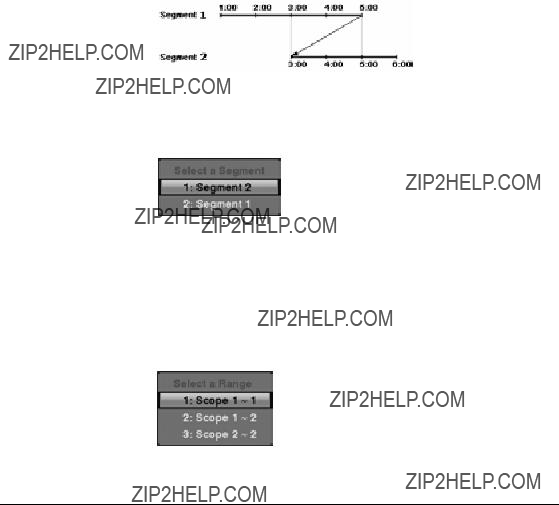
Time Overlap
E
Time Overlap
If the DVR???s time and date have been reset to a time that is earlier than the existing recorded video, it is possible for the DVR to have more than one video stream in the same time range. In this case, you can search overlapping video streams individually by selecting a specific segment. For example, when the DVR has recorded video from one to five o???clock and the user changes the time backward from five to three o???clock and then continues recording until six o???clock, there will be two video streams and segments from three to five o???clock.
You can search overlapping video streams by selecting a specific time or time range. If you want to search recorded video at four o???clock during the overlapping time range using a search menu such as Go to the Date/Time, select the segment you want to search.
If you want to search recorded video from four to five o???clock during the overlapping time range using a search menu such as Event Log Search,
???From four o???clock of the first segment to five o???clock of the first segment
???From four o???clock of the first segment to five o???clock of the second segment
???From four o???clock of the second segment to five o???clock of the second segment

Time Overlap
140

Troubleshooting
F
Troubleshooting

Troubleshooting
142

Connector Pin Outs
G
Connector Pin Outs
I/O Connector Pin Outs

Connector Pin Outs
RS485 Connector Pin Outs
+ ! To ! TX+
??? ! To ! TX???
+ ! To ! RX+
??? ! To ! RX???
144
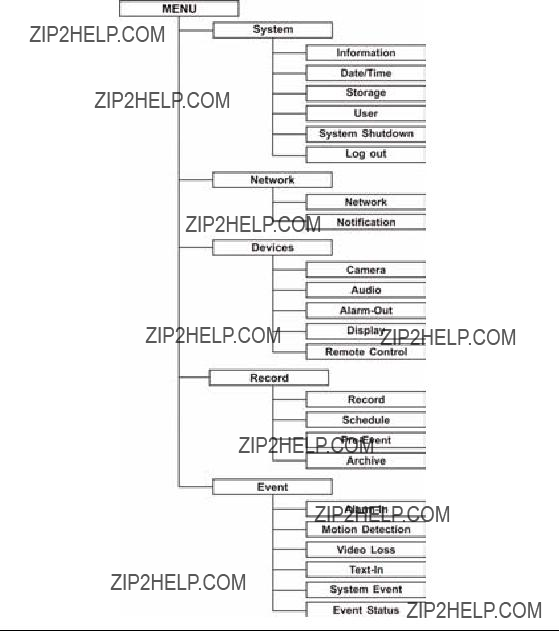
Map of Screens
H
Map of Screens

Map of Screens
146

System Log Notices
I
System Log Notices

System Log Notices
148

Error Code Notices
J
Error Code Notices

Error Code Notices
150
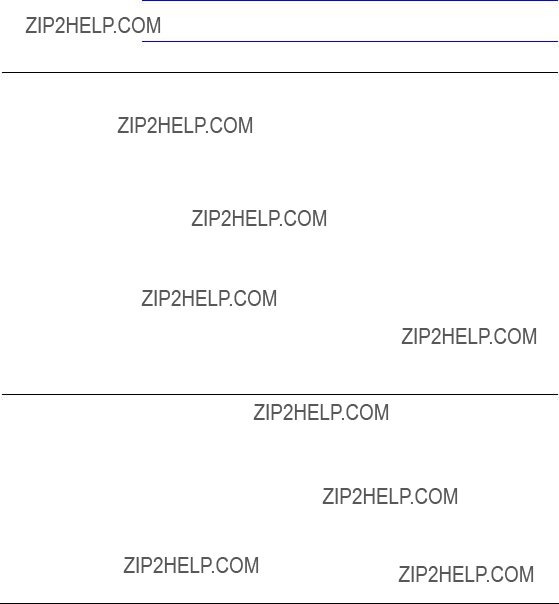
Specifications
K
Specifications
Note Specifications are subject to change without notice.

Specifications
* Using a shielded
** When installing an internal
152

Specifications

Specifications
154

www.honeywellvideo.com +1.800.796.CCTV (North America only) HVSsupport@honeywell.com
Document 900.0856 ??? Rev B ??? 02/08
?? 2008 Honeywell International Inc. All rights reserved. No part of this publication may be reproduced by any means without written permission from Honeywell Video Systems. The information in this publication is believed to be accurate in all respects. However, Honeywell Video Systems cannot assume responsibility for any consequences resulting from the use thereof. The information contained herein is subject to change without notice. Revisions or new editions to this publication may be issued to incorporate such changes.